Leading IT Transformation – Workshop 14 (Contract Negotiation)

The Appleton Greene Corporate Training Program (CTP) for Leading IT Transformation is provided by Ms. Drabenstadt MBA BBA Certified Learning Provider (CLP). Program Specifications: Monthly cost USD$2,500.00; Monthly Workshops 6 hours; Monthly Support 4 hours; Program Duration 24 months; Program orders subject to ongoing availability.
If you would like to view the Client Information Hub (CIH) for this program, please Click Here
Learning Provider Profile

Ms. Drabenstadt is a Certified Learning Provider (CLP) at Appleton Greene and she has experience in Information Technology, Information Governance, Compliance and Audit. She has achieved an MBA, and BBA. She has industry experience within the following sectors: Technology; Insurance and Financial Services. She has had commercial experience within the following countries: United States of America, Canada, Australia, India, Trinidad, and Jamaica. Her program will initially be available in the following cities: Madison WI; Minneapolis MN; Chicago IL; Atlanta GA and Denver CO. Her personal achievements include: Developed Trusted IT-Business Relationship; Delivered Increased Business Value/Time; Decreased IT Costs; Re-tooled IT Staff; Increased IT Employee Morale. Her service skills incorporate: IT transformation leadership; process improvement; change management; program management and information governance.
MOST Analysis
Mission Statement
After vendor selection is done, a contract has to be signed to formalize the terms of the agreement. But before a contract is finalized, there is generally a process of contract negotiation where both parties discuss and smooth out all the details of the contract. It is important for parties involved in a contract to understand their rights as well as obligations. The expected services and the compensation against those services should be clearly defined. All stakeholders should be in agreement with the terms of the contract. Only when these and other conditions are satisfied, can a contract be considered successful. This is what contract negotiation ensures. Negotiation of the terms of a contract should take into account all of the above points as well as other basic aspects of the agreement. Some of these aspects would be the price, quality, services offered, delivery, terms of payment, support, and any other crucial issues. Apart from these core factors, there are some other points of negotiation as well which ensure that the contract will work smoothly on application. For instance, the contract needs to define the KPIs to be used for vendor performance monitoring and the reporting methods. It should define the communication methods, invoicing methods, and delivery practices, including any system integrations that may be required from the vendor. The contract should also lay out the terms for dispute resolution and clearly name the contacts on both sides for such purpose. Any training or skill transfer requirements must also be agreed upon before finalizing the contract. A final critical component is to anticipate a possible future amicable “divorce”. The contract should clearly specify ownership of data, intellectual capital developed, customer relationships, how data will be transferred to a new vendor, transitioning knowledge, etc., if either party terminates the contract.
Objectives
01. Prepare for Contract Negotiation: departmental SWOT analysis; strategy research & development. Time Allocated: 1 Month
02. Set Negotiation Objectives: departmental SWOT analysis; strategy research & development. Time Allocated: 1 Month
03. Negotiation Strategies: departmental SWOT analysis; strategy research & development. Time Allocated: 1 Month
04. Request for Proposal (RFP): departmental SWOT analysis; strategy research & development. Time Allocated: 1 Month
05. Due Diligence Checklist: departmental SWOT analysis; strategy research & development. Time Allocated: 1 Month
06. Check References: departmental SWOT analysis; strategy research & development. Time Allocated: 1 Month
07. Exit Strategy: departmental SWOT analysis; strategy research & development. 1 Month
08. Mitigating Contract Risks: departmental SWOT analysis; strategy research & development. Time Allocated: 1 Month
09. Contract Review & Next Steps: departmental SWOT analysis; strategy research & development. Time Allocated: 1 Month
Strategies
01. Prepare for Contract Negotiation: Each individual department head to undertake departmental SWOT analysis; strategy research & development.
02. Set Negotiation Objectives: Each individual department head to undertake departmental SWOT analysis; strategy research & development.
03. Negotiation Strategies: Each individual department head to undertake departmental SWOT analysis; strategy research & development.
04. Request for Proposal (RFP): Each individual department head to undertake departmental SWOT analysis; strategy research & development.
05. Due Diligence Checklist: Each individual department head to undertake departmental SWOT analysis; strategy research & development.
06. Check References: Each individual department head to undertake departmental SWOT analysis; strategy research & development.
07. Exit Strategy: Each individual department head to undertake departmental SWOT analysis; strategy research & development.
08. Mitigating Contract Risks: Each individual department head to undertake departmental SWOT analysis; strategy research & development.
09. Contract Review & Next Steps: Each individual department head to undertake departmental SWOT analysis; strategy research & development.
Tasks
01. Create a task on your calendar, to be completed within the next month, to analyze Prepare for Contract Negotiation.
02. Create a task on your calendar, to be completed within the next month, to analyze Set Negotiation Objectives.
03. Create a task on your calendar, to be completed within the next month, to analyze Negotiation Strategies.
04. Create a task on your calendar, to be completed within the next month, to analyze Request for Proposal (RFP).
05. Create a task on your calendar, to be completed within the next month, to analyze Due Diligence Checklist.
06. Create a task on your calendar, to be completed within the next month, to analyze Check References.
07. Create a task on your calendar, to be completed within the next month, to analyze Exit Strategy.
08. Create a task on your calendar, to be completed within the next month, to analyze Mitigating Contract Risks.
09. Create a task on your calendar, to be completed within the next month, to analyze Contract Review & Next Steps.
Introduction
Running a successful business requires collaboration across many teams when negotiating contracts with vendors. However, many companies typically lack the skills necessary to bargain effectively with suppliers, which results in costs that could have been easily avoided. Because of this, every business owner needs to develop their negotiation skills.
There are a few things you should watch out for if you’re planning to connect up with vendors or have already established a supply chain network. These tips will enable you to manage your company more successfully and help you stay within your budget while buying goods and services.
The essentials of a fruitful vendor negotiation
These five essential strategies for creating a successful relationship with your vendors are likely well known to anyone with even a few years of procurement experience. There’s a good possibility that you already do at least some of these if you run a business. Let’s examine the ideal methods for negotiating vendor agreements.
Assess your position
Always consider whether the vendor meshes with your business and is consistent with your current objective. Mutual interest is the one factor that unites all partnerships. The likelihood of developing a lasting connection increases with the amount of shared interests you have. On the other hand, it is always preferable to leave if your ideals appear to be at odds.
The next step is to create a thoughtful list of the requirements you’re looking to fill. Consider carefully the obstacles the vendor will need to overcome, the services or costs you are willing to bargain for, and the issues you will not be willing to compromise on.
Here are some things to consider:
• The specifications you have for the goods you’re producing or buying
• Your financial situation
• The current sales targets of your organization
• Your objectives for the new collaboration
• Criteria for selecting a vendor
Negotiate with more than one vendor
Never enter vendor contract discussions without having a strong backup plan. This should be your guiding principle while negotiating supplier contracts. Additionally, you can always advocate for what’s best for you while exploring the options with more than one provider because you won’t have to worry about damaging a connection.
converse with several suppliers at once. Inquire about their costs, the method they use to transport their products, and other facets of their operation. Gather a lot of information to aid in weighing the competing offers from each provider. Comparing various bids ensures that you are not entering a negotiation without any market expertise.
Risks and liabilities
Risks and liabilities are another issue to watch out for during vendor contract discussions. You are most exposed if you are a business owner. You must therefore avoid taking a chance by clinging to any loose ends that can wind up costing you later.
To emphasize the obvious once more, there will always be dangers in business. Things that happen in business that you didn’t expect to happen frequently include vendors who falsify their financials, unexpected recessions, and global pandemics.
It’s usually advisable to establish boundaries for risks and responsibilities that are clearly specified in order to avoid being caught off guard. Recognize when you should renegotiate a contract or when you can afford to cut your losses and part ways with a vendor.
Mutually beneficial relationships
A lot of business owners are mistaken about this. Negotiating with a vendor effectively doesn’t include nickel and diming your source. Instead, it’s about creating a strong bond where you both support and uplift one another.
Think about the terms and conditions from the standpoint of your vendor. Where you can, take some liberties. Offer non-monetary clauses in the contract, such as scheduling flexibility, that can make the vendor’s life simpler.
Since your vendor is an authority in their field with a wealth of knowledge you can use, the objective is to establish a solid collaboration with them. And business partners who like you might go above and above to assist you when you need it.
Communication process
When considering how to bargain with suppliers, start by improving your communication. Any successful trade depends heavily on communication, and poor communication can lead to losses. Always strive to keep lines of communication open. When discussing the contract, be succinct, precise, and on time.
When working on challenging challenges, personal communication is more productive than virtual contact, and this is also true when hiring vendors. Instead of dealing with juniors or associates, try to deal directly with department heads and executives.
Additionally, confirm that the party you’re negotiating with has the power necessary to decide. You shouldn’t waste time talking to someone who needs to go through their organization’s hierarchy in order to answer your question with a solid yes or no.

How redlining and negotiating are made simple by digital contracts
In the past, parties involved sat down at a table and worked on a contract for days. When email first appeared, businesses moved there to conduct contract negotiations.
But business has changed much since then, with the exception of contract drafting. So many individuals waste hours each day writing documents in Microsoft Word and exchanging emails. The method is labor-intensive and wasteful, costing the business time and resources.
However, digital contracting is now the only thing that matters, especially when it comes to digital services like contract negotiations with IT vendors.
Here are just a few of the things that digital contracting can help with:
• Real-time status tracking
• Retrieve comments on particular segments
• Specific time-stamped draft copies
• Directly notifying users of any changes, so that they can offer input.
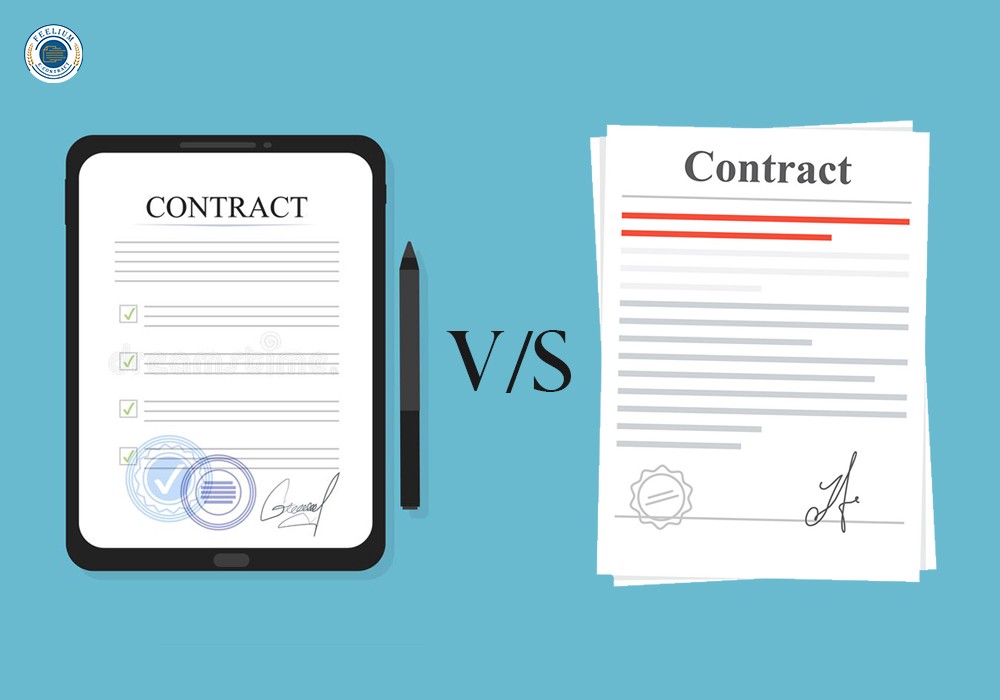
Nobody else can automate a process like you can with the Ironclad. Sharing access to the main contract document with your coworkers and counterparties is the only necessary step. Any modifications made after that point will be fully transparent to everyone, and each clause will need to be approved by each accountable party. It is straightforward and easy to collaborate on contracts when everyone is informed.
How using digital contracts can help you keep good vendor connections
Consider it in this manner. A team is working on a contract that calls for the vendor to deliver goods worth $5 million per month. Both sides’ legal staff will exercise extreme caution to make sure everything looks fine.
Every concerned department, save Legal, must voice its opinion. Every aspect of the day-to-day operations, including Finance, Product Management, and Accounts, has a voice in the decision.
Imagine conducting the entire discussion by email, with each party delivering a unique soft copy that has undergone a variety of modifications. Nobody is collaborating on the same document if there is a day’s wait. The logistics are a mess.
Fortunately, a platform has been developed where a contract management system can handle each of these in one location in real time. Teams from both companies can collaborate and work concurrently on the same document.
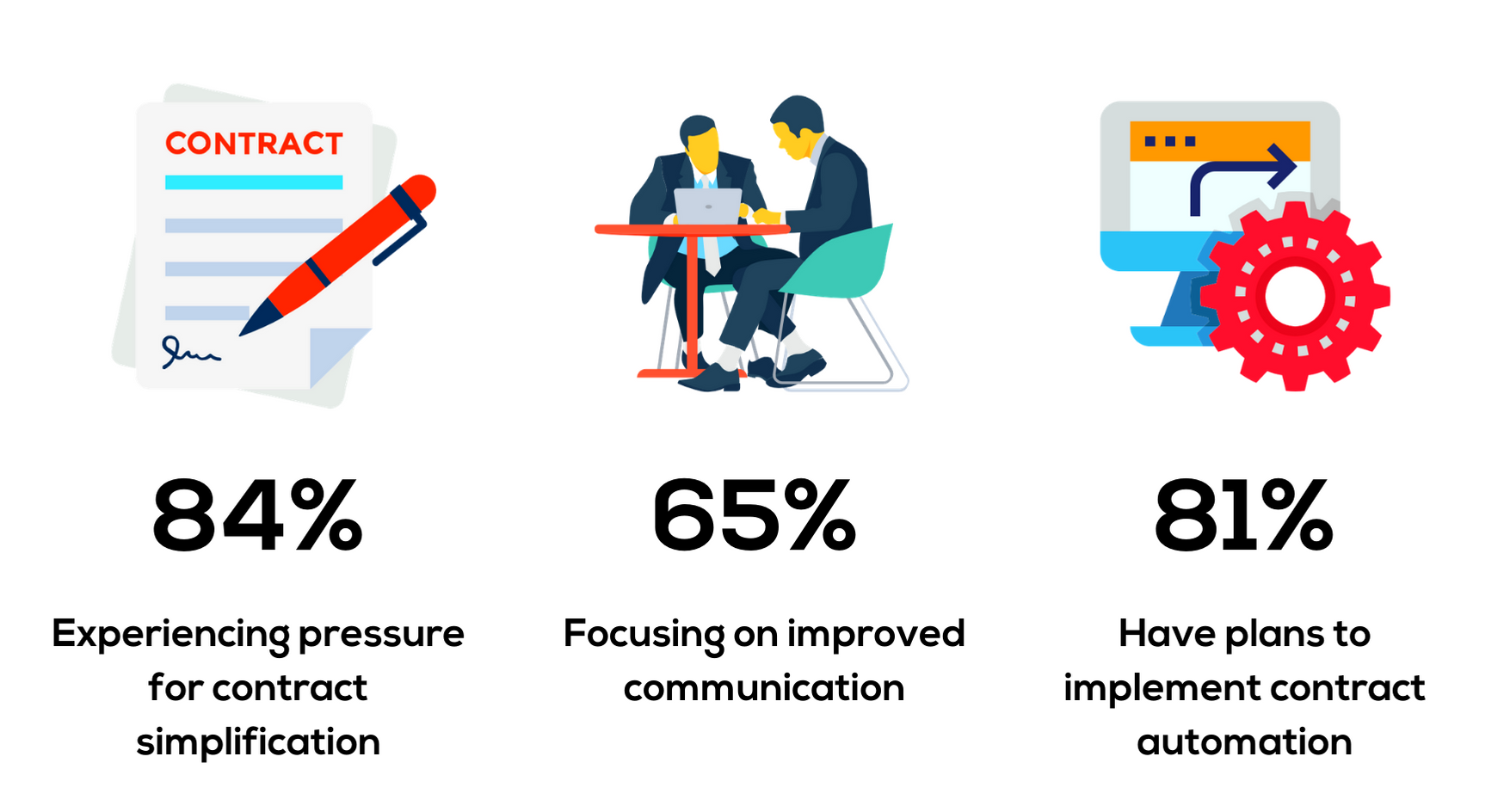
Source: Dock365
Anyone can ask for another user’s input and directly tag them, and all of these actions will be fully traceable. All teams concerned may see and understand the redlining in its entirety. This is the reason contract management software has taken the role of emails.
Digital contracting streamlines and greatly improves the vendor negotiation process, or any time you’re negotiating contracts with suppliers, as opposed to the past, when creating a contract could take weeks or even months. You don’t need to spend all day looking through paper trails and write three emails to make a few changes.
This maintains a good rapport between you and your vendor. The redlining procedure becomes less stressful, the negotiation as a whole becomes less hostile, and mutually advantageous terms are reached.

When entering into a vendor contract, take into account these 5 factors
Contract termination clauses are a topic I get asked about a lot. Unfortunately, depending on how much consideration was given to the termination wording when the contract was being created, your alternatives may be restricted if you decide you “want out” while in the middle of an existing arrangement. Let’s examine the kind of factors you should take into account before signing a contract.
The 5 Vendor Contract Items to Consider
If you’ve been following our information for the past year or two, you are aware of my frequent assertion that entering into a new contract while hoping to get out is difficult.
However, I frequently compare it to the safety briefing you receive on a flight because, although the likelihood that you will need to employ the safety measures is quite remote, it is still crucial to be aware of them. You must be able to leave right away if necessary.

When thinking about a contract, the same holds true
1. Make sure that both your institution and the third party have a solid understanding of what each other’s responsibilities are from a contractual standpoint. Include termination steps and what happens to your confidential information after the contract ends. Don’t just accept the off-the-shelf, or “we have everyone sign this” contract.
2. Define carefully what the notification period will be if you choose not to renew the contract.
3. Define what steps may be in order if you need to quickly exit the contract. A couple of common example situations are in the case of some sort of contractual breach by the third party, such as a failure to live up to the standards in the contract, or an imminent financial failure of the third party.
4. A well-written and negotiated contract is a “win/win” for both parties with mutual responsibilities and protections. Neither party should feel trapped by the contract. At the same time, if things go poorly or if you simply don’t want to renew, you should have clearly articulated the steps that need to be taken, in what order they should occur, the appropriate time frames established and the costs associated (if any) with terminating the agreement.
5. Get a contract expert (e.g., attorney, paralegal, expert contract administrator, whomever you can call upon) to review all elements of the contract to make sure that it is accurate and enforceable.
By carefully drafting agreements that protect you and your vendor from both a legal and business perspective, contract management done right may be a significant benefit to your organization.

Audit Rights and Their Importance in Vendor Contracts
The greatest approach to make sure that vendors comply is with well-written contracts. Transparency is essential throughout the whole relationship when a vendor is crucial to your business. Your vendors must provide data and report to your company upon request if your contract includes a right to audit clause.
This information may be sought at any stage of the lifecycle of third-party risk management, although it is typically needed for vendor due diligence and continuing monitoring. A right to audit clause gives your company the right to see the output and reporting from your vendor, including self-evaluations, outside audits, and other official papers outlining the effectiveness of internal systems and controls.
Commonly Reviewed Vendor Data and Reporting
Let’s review what types of data and reporting are commonly reviewed under a right to audit clause:
1. SOC Reports. Otherwise known as Service and Operating Controls, these reports give an expert evaluation of the control environment and any weaknesses discovered through independent third-party audits.
There are three types of SOC reporting:
– SOC 1: Examines the effectiveness of internal financial controls at a service organization. As mandated by SSAE 18, SOC 1 audits a third-party vendor’s accounting and financial controls.
– SOC 2: This evaluates a vendor’s internal controls on one or more of the Trust Services Criteria (Security, Availability, Processing Integrity, Confidentiality, and Privacy). Type I confirms that controls are in place and Type II confirms that the controls are in place and working.
– SOC 3: A SOC 3 report is a public option that can be freely distributed but is less detailed than a SOC 1 or SOC 2 which can only be read by the direct users of an organization’s services.
2. SLA Reports. Service level agreements (SLAs) are the agreed-upon upper and lower bounds of service or quality in a contract. When certain SLAs aren’t met, the vendor usually faces some type of penalty. The vendor must deliver reporting that supports the appropriate level of performance in order to verify that SLAs are being met.
3. Compliance Reporting. This may include overall compliance policies, such as a compliance training policy, fair lending or Equal Credit Opportunity Act (ECOA) policy or Telephone Consumer Protection Act (TCPA) policy, which only applies to vendors making phone calls or sending texts. Also, consider a marketing/CAN-SPAM policy, which only applies to vendors involved in marketing activities and the Fair Debt Collections Practices Act (FDCPA), which only applies to collections vendors.
4. Data Privacy and Confidentiality Policy. This may need to be requested separately if not provided with compliance or information security documentation.
5. Payment Card Industry (PCI) Compliance Reports. PCI compliance reporting can include data such as vulnerability scans or other methods used to validate compliance.
6. Financial Statements. Audited financials, internally prepared financials and the organization’s annual tax filing can be important components in a right to audit clause.
7. Insurance. Current insurance certificates and policy references should be thoroughly reviewed and may include general liability, professional errors and omissions or cybersecurity coverage types.
8. Business Continuity and Disaster Recovery Reports. All plans, testing scenarios, test results and mitigation plans are essential to review to ensure that your critical vendors are prepared for a business impacting event. Plans should include the following:
• Departments included in the program and their RTO
• Business continuity exercise types, scenarios and findings
• Report of the last activation outside of a drill with root cause analysis
• Emergency management documentation that basic OSHA requirements are met (annual fire drill, etc.)
• Facility (location) risk/hazard assessment
• Evacuation & shelter in place procedures
• Active threat plan
9. Information security. Attestations/certifications for controls around security, processing integrity, confidentiality and privacy of a system, including but not limited to:
• SSAE 18 SOC reporting (type II reports should be included in the ’03 – independent third-party audits’ document request)
• ISO/IEC27001 certification
• PCI ROC and/or penetration test reports
• Technical and procedural measures for network protection through a firewall
• Secure server configuration
• Vulnerability identification and patching reports
• Physical and logical access controls
• Data security policy (See elements of documentation below):
– Data classification and encryption methodologies, data loss prevention, password hashing, data retention and destruction
• Documented incident response policy, standards and processes (See elements of documentation below):
– Data security and confidentiality protections against threats or hazards
• Data privacy and confidentiality policy
• Facility (location) risk/hazard assessment
• Disaster recovery exercise scope and schedule
• Report of the last activation outside of a drill with root cause analysis
10. Fourth parties. Your fourth party’s third-party risk management policy, risk rating methodologies, vendor inventory, critical vendor list, due diligence documents, ongoing monitoring schedule and critical contracts should all be reviewed.
11. On-Site Audit. To make sure a vendor is following its stated policies and practices regarding the client’s customers, an on-site audit is often conducted on a vendor providing vital services to the client. These audits typically look at the vendor’s internal controls, information systems, and security, business resumption, and adherence to internal policies and procedures, as well as financial and operational activity. Although the majority of this audit is done on site, it can also be done remotely.
12. Billing Audit. Many clients will want the right to audit the vendor’s billing statements – especially when the vendor is providing transaction services. The contract could include some language to assess penalties if any billing errors, specifically overcharging, are discovered.
13. Subcontractor Audit. For any or all of the audit rights that is included in the contract for the vendor, a client could also require the same audit of any subcontractor performing activities on the vendor’s behalf in support of the client.
14. Other Miscellaneous Audits. An audit clause might also require the vendor to perform regular testing or monitoring of other significant security controls such as application and network penetration testing, non-intrusive network audits or more intrusive network and physical audits, and to audit for compliance with applicable laws and regulations.
Critical vendors play an important role within your organization, so make sure to include a right to audit clause within your contracts so you can continually monitor your vendors’ and their subcontractors’ performance and identify any issues that need to be addressed.

Why Honesty Is the Best Policy
Although it’s very essential for the wellbeing of both firms, buyers and sellers aren’t always the most straightforward relationships to handle. While suppliers want to be compensated fairly for their services, buyers may depend on fast service delivery. Negotiating an exchange of the two ought to be simple enough, but this isn’t always the case.
Dishonesty on the side of one or both parties can damage business ties and sour the prospects for new business. Here’s why being truthful with suppliers and customers is always the best course of action:
Honesty Leads to Longer-Term Relationships:
A new business connection always carries some risk for both parties. Vendors want to know that they will receive payment as soon as the work is finished, and buyers want to trust their project to a supplier that will deliver a quality service and meet deadlines. Therefore, it should go without saying that long-term relationships are advantageous on all fronts, and the durability of such an union is greatly influenced by honesty.
Buyers should be forthright about the pricing they anticipate to pay from the start, and vendors should be entirely transparent with their clients about feasible lead times. This creates the foundation for a fruitful long-term partnership that meets everyone’s business needs by making both sides aware of one another’s expectations.
How do you negotiate with a SaaS provider for a cheaper price without upsetting them during the purchase?
One strategy for businesses to lower costs, boost cash flow, and expand margins is through negotiation. Suppliers usually seek to expand their margins, while buyers always want to lower expenses while preserving the quality of the services provided.
Your best alternatives as a buyer will be to achieve a balance or agree on a discount without upsetting the sellers given the conflicting objectives. But how can you bargain given that you have a limited budget without upsetting your sellers? Here, we fill you in on every detail.
What conditions should you consider while negotiating a lower price?
The first step in making sure your company receives high-quality service is to negotiate a SaaS contract. Cost-effectiveness, a shortened setup period, an easy-to-use user interface, and increased performance are all advantages of a SaaS contract.
However, you should have a clear objective and adhere to a standard operating method when negotiating a contract (SOP). Set a personalized pricing plan in place, ideally for the long run. Be mindful of any potential hidden expenses.
With regard to service features, begin with a simple plan. You have the option to make changes afterwards. Additionally, find out if the vendor gives you the choice to lower your spending in the event of a recession. Make sure your data security is adequate overall and that you have access to regular backups of your data.
Include a termination provision in the agreement. Imagine that after utilizing the provider’s service for a while, you don’t like it. Can you then choose to cancel the agreement? You’ll need this freedom to be able to switch to another SaaS provider that will provide you with high-quality services. Even in some contracts, there may be a fine if the desired services are not rendered.
How can you make your purchase without offending the vendor or SaaS provider?
You must protect the interests of your own company while keeping in mind those of other businesses. The interests of the two parties frequently diverge: the buyer wants to spend less, while the seller wants to make more money. Only mutual respect and appreciation of each party’s limitations can be the foundation of an effective and long-lasting cooperation.
Know how to talk to the vendor
Want to get the respect of a supplier? Here are some pointers. Recognize the terms. Understanding industry-specific lingo can be challenging at first, but once you do, the negotiation process becomes much easier because everyone is speaking the same language. Additionally, being respectful in your opposition will help you succeed. For instance, “I didn’t anticipate this sum to be this high. This question can go much further than “This pricing is absolutely outrageous. Is there any way to change the plan so I can stay within the budget. Reduce it, or I’ll find another store.
Don’t be arrogant or condescending
The negotiation may lead to a tense situation. Never lose your temper, and refrain from offending anyone. It’s important to demonstrate your expertise and bargaining prowess, but you also need to avoid patronizing the sellers or coming across as a snob. You are positioning yourself for success by keeping a composed, assured, and pleasant manner.
During the negotiation, establish clear terms
When laying out the details of your counteroffer to the supplier, it’s crucial to sound professional. This makes it possible for them to fully understand your stance without feeling threatened. Here are some more pointers. Try to convince them, for instance, that you need a discount in order to buy their good or service. It is frequently advantageous to clarify your words in an apology-style. This makes it easier for you to demonstrate interest in the product.

How can I make a fair offer to the SaaS provider?
Your SaaS provider may decide to cease working with you or reduce their investment if you place too many demands on them, which may eventually cost you. Making excessive pricing demands compared to the market does not result in a good bargain.
Identify the goals you have for the contract
The secret to a good negotiation is specificity. Never place yourself in a position where you want to look around and decide what you want right away before engaging in extensive negotiation. Before you enter into a negotiation, know exactly what you want in terms of the pricing structure, the features, and other specifics.
Having a clear idea of what you want can help you make wise choices during the bargaining process. Additionally, it exudes a sense of assurance and knowledge that can tempt the sellers to make a cheaper offer.
Find out the product’s retail price
Verify the cost of your desired item with various market vendors. Establish a reasonable target valuation range using this information. Aiming for a 10–30% cost reduction is reasonable. The likelihood of receiving a 70% discount varies based on the vendor.
You must also be aware of quality discrepancies because most vendors will argue that superior quality justifies paying more for a product or service. For the majority of vendors, maintaining current clients is less expensive than acquiring new ones. A provider may be more inclined to cut their prices if they fear losing your business. You can benefit from knowing how much new and existing consumers cost them when negotiating a deal.
Compare prices from different SaaS providers
A contractor’s best buddy is a price that is competitive. As a result, before entering into negotiations, always request at least one more estimate from vendors in the market.
Make a list of all the working conditions and additional services you require, for instance, when buying software. Give other SaaS providers this list so they can quote. then consider the cost. Using this method, you may determine what pricing is more reasonable and whether a dealer is offering you a lower or higher price.
An offer that is too “cheap” might occasionally be offensive to a seller. In fact, he might decide to avoid you in the future as a result. The size of your first offer must therefore strike a compromise between getting the best deal on the property and making a respectable offer that won’t anger the sellers.
In truth, when it comes to drafting business contracts, honesty and openness are ideal practices. Inform the vendor that bids from rival companies have been solicited; the best offer will win the job. If everything goes as planned, the vendor will lower the initial cost mentioned, provide better terms, or return with another type of incentive.
Before the deal, establish a price cap
Before you go to close the sale, try to set your price restriction after receiving at least one estimate from a SaaS provider as a customer. Setting a limit before the negotiation will enable you to be more exact. Your arguments will also be logically sound and supported by prior research.
As a buyer, your price cap is the most you’re willing to shell out for a product. Don’t go over it! Make your initial offer below €15k if you intend to purchase for that amount.
When might a negotiation strengthen or weaken a vendor-company relationship?
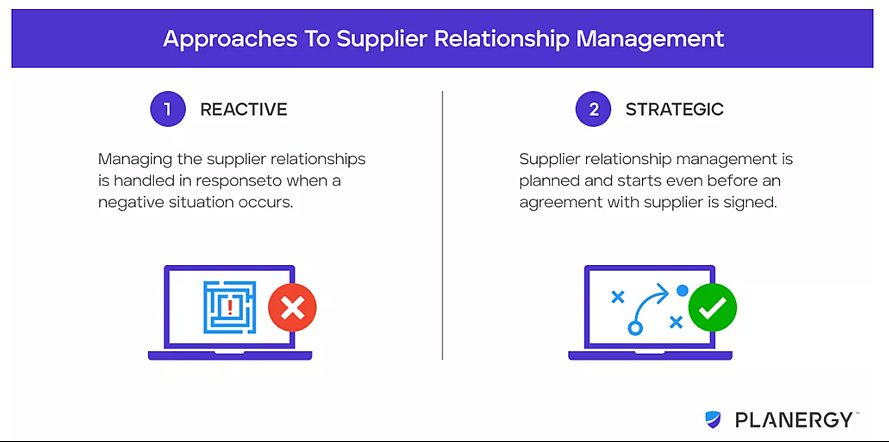
To avoid over-negotiating is the key. This can occur for a number of different reasons, including providing a list of “requirements” that fundamentally alter the nature of the contract, delaying the introduction of a new condition or other operating terms, as might be the case with software purchases, or simply responding too frequently with a low bid.
In fact, it can be a sign that you over-negotiated if the vendor just walks away from the contract or tells you that they believe another vendor would be a better “match.” In rare circumstances of last-minute discussions, the vendor can be forced to accept your offer if it was depending on your business to reach its sales targets.
There is always a “wound” that follows; if you created a new circumstance or intervened at the last minute, he might never forget the predicament you put him in. He might decide not to sign contracts with you in the future as a result.

Case Study: Why honesty and sincerity are a vital part of vendor contract negotiation
Actual Case:
The golden donut chain, a Philippine-based company, has faced difficulty in negotiating with its labor union. The donut chain and the labor union have talks regarding their problem.
When the donut chain’s management team arrived late with the said talks, the labor union stormed out in protest to show great dismay over their delay in the negotiation.
In order to continue their talks with the labor union, the management team of the donut chain has sent a letter that includes an apology.
However, from the perspective of the labor union, the apology is insufficient to forgive the inconvenience that the donut chain has caused. The labor union refused to meet for talks and continue with their strikes.
This case study has focused on how to convey your sincerity when apologizing in a negotiation. How can one deliver their sincerest apology that the other party will accept?
Final Deal:
The case with the golden donut chain and the labor union has ended in a bad way. Due to the lack of concession due to the insufficient apology from the donut chain, the labor Union has brought it into court.
When both parties brought it to the courts, it took years before a party was compensated. In this case, the labor union has won the case against the donut chain.
What can we learn from it?
Professor Edward Tomlinson and Professor Roy Lewicki from Carroll and Ohio University have found out that people view apologies to be sincere when it includes internal attributions of harm. This simply means that people will see your apologies as sincere when you own up to your mistakes.
The credibility of a person has a significant factor in making apologies sincere from the perspective of the other party.
A study showed that unfulfilled promises, deception, and breaking the trust of the other party are some factors that a negotiator cannot work out in giving their sincerest apology. Moreover, giving assurance even if you cannot attain or fulfill it is counterproductive in a negotiation.
Many negotiators advance their case by persuading the other party or listening to their side. But sometimes, the greatest thing you can do in a negotiation is to straightforwardly admit your mistake.
Many apologies have failed to achieve their aim—to be forgiven. The delivery of some people is usually the culprit why apologies are not accepted.
The importance of an apology in a heated argument or negotiation cannot be overstated enough. When the other party thinks that your apology is not sincere enough to make amends, the heat in the negotiation will rise further—leaving both disliking each other.
The power of apology in negotiation and dispute resolution is significant to fixing relations between parties. It is important to apologize and own up to your mistakes to make the other party feel that you are sincere.
We must remember that if we cannot fulfill or attain our promise, we must not push it further to the other party. Doing so will only aggravate the emotions of the other party. Because we all know that no one wants to be left hanging—so do not promise during a negotiation that you cannot follow through.
Executive Summary
Chapter 1: Prepare for Contract Negotiation
Prepare for the Negotiation with Research
Long before you sit down at the figurative bargaining table, the process of negotiating a contract starts. Establishing a thorough understanding of the other party’s viewpoint and business objectives is necessary to successfully persuade them. Complete background research about the firm, its products, and the specific person you will be negotiating with will help you get ready for the discussion. In order to evaluate the conditions they specified in these deals, how effectively they complied with these terms, and the caliber of commercial ties they build with other firms, you should examine their company website, news announcements, and any articles about their prior partnerships.
You can better understand the dynamics of a deal by doing thorough research prior to negotiation. This knowledge includes the other party’s interests, needs, and desired outcome as well as their strengths and weaknesses, any financial or time-based constraints that may affect the deal, and any competing interests. Additionally, it reveals vital details about who has the biggest leverage and, thus, who needs the agreement the most. With adequate planning, you may begin the contract negotiation from a knowledgeable, strategic position and confidently anticipate the opposing party’s moves. To avoid spending your time attempting to persuade the wrong person, be sure you are dealing with the actual decision-maker who has the power to make accommodations or agree to your demands.
A crucial aspect of work life is negotiating. Everyone has to engage in negotiation at some point, whether they are closing agreements for their company or for themselves.
Vendor negotiation: What Is It?
The strategic process of coming to an arrangement that is advantageous to both your organization and its third parties is called vendor negotiation. It might entail a number of discussions, mutual concessions, and the application of the soft skills we cover in this essay.
3 Essential points for Vendor Contract Negotiations
Three important things to keep in mind when negotiating a vendor contract if you lack knowledge or confidence are as follows:
• There’s a set of core principles and processes that can be learned and applied to negotiating, which will make you more successful at it
• There’s no single style or approach that you have to adopt to be a successful negotiator.
• Negotiation rarely takes place at a single, scheduled event. It’s a process that can begin from the moment you first engage with a potential counterparty. EVERY interaction is an opportunity to either negotiate or lay the groundwork.

You might be relieved to learn that being a skilled negotiator doesn’t require you to become overly pushy and confrontational. In fact, in 99% of situations, doing this will not result in a positive outcome.
The fundamental, overarching rule is that negotiations shouldn’t be combative. Parties to a negotiation should see one another as partners in pursuit of a mutually beneficial result.
Lets Review this sentence’s two essential components in the context of a contract negotiation:
• Collaboration is key. If you’re reached the negotiation stage with a potential vendor then it’s highly likely that both parties believe there is a deal to be done and benefit to be gained. Having a mindset of working together to achieve this will go a long way to making sure the negotiation is successful.
• Ensuring the contract is “mutually agreeable” is vital. There’s little point in forcing a potential vendor to accept significantly worse terms than they would usually work to. Over time, this can breed resentment and a lack of motivation, creating potential contract breaches.

Chapter 2: Set Negotiation Objectives
Good contract negotiations lead to good contracts, which necessitate a clear comprehension of and focus on, a company’s primary goals in drafting the contract. The achievement of the company’s most crucial objectives for the engagement throughout the negotiation determines if a contract is “excellent.”
Securing the company’s main goals must come first in any attempt to negotiate contract conditions. This course manual contains useful advice for anyone asking how to bargain a contract while keeping those goals in mind.
How to Establish Contract Objectives
We will start by going through the key topics that are typically covered during contract negotiations. Contracts can be categorized as involving a connection, such as an employment contract, or a transaction, such as a sale or purchase. Both kinds of contracts demand that the parties reach an understanding regarding the goods or services to be delivered, the payment, the date, and the place of performance, as well as a myriad of ancillary issues including confidentiality, dispute resolution, and occasionally non-compete clauses. While transactions are frequently one-and-done, relationship contracts frequently have clauses known as win-win provisions that urge the parties to keep cooperating. Many agreements contain both.
A corporation has a better chance of achieving its goals the more clearly it states what it really wants from a contract. The term “SMART” is sometimes used by legal professionals to refer to the accuracy needed while setting objectives. This abbreviation means “specific, measurable, achievable, relevant, and timely” (meaning within a particular timeframe).
A firm typically enters negotiations with a number of goals in mind. But in a certain transaction, not all of these will be given the same weight. Priorities will vary depending on the parties. Prior to starting contract discussions, it’s crucial for each party to consider the most crucial outcomes it wants to achieve from the deal. These should be given high priority as they are the company’s main goals. A handful of these goals are necessary for the deal to move forward. The party will leave if they can’t be agreed upon. These difficulties might be contrasted with other goals that, if agreed upon, would be preferable but which are not necessarily necessary for the specific trade.

Chapter 3: Negotiation Strategies
A crucial aspect of work life is negotiating. Everyone has to engage in negotiation at some point, whether they are closing agreements for their company or for themselves.
What Is Vendor Negotiation?
The strategic process of coming to an arrangement that is advantageous to both your organization and its third parties is called vendor negotiation. It might entail a number of discussions, mutual concessions, and the application of the soft skills we cover in this course manual.
Key Points About Negotiating Vendor Contracts
Three important things to keep in mind when negotiating a vendor contract if you lack knowledge or confidence are as follows:
• There’s a set of core principles and processes that can be learned and applied to negotiating, which will make you more successful at it
• There’s no single style or approach that you have to adopt to be a successful negotiator.
• Negotiation rarely takes place at a single, scheduled event. It’s a process that can begin from the moment you first engage with a potential counterparty. EVERY interaction is an opportunity to either negotiate or lay the groundwork.
You might be relieved to learn that being a skilled negotiator doesn’t require you to become overly pushy and confrontational. In fact, in 99% of situations, doing this will not result in a positive outcome.
We’ve chosen the example of negotiating a vendor contract to demonstrate the concepts in this course manual. However, these concepts are also applicable in other circumstances and will support your vendor negotiation tactics.
The fundamental, overarching rule is that negotiations shouldn’t be combative.
Parties to a negotiation should see one another as partners in pursuit of a mutually beneficial result.
Reviewing this sentence’s two essential components in the context of a contract negotiation:
• Collaboration is key. If you’re reached the negotiation stage with a potential vendor then it’s highly likely that both parties believe there is a deal to be done and benefit to be gained. Having a mindset of working together to achieve this will go a long way to making sure the negotiation is successful.
• Ensuring the contract is “mutually agreeable” is vital. There’s little point in forcing a potential vendor to accept significantly worse terms than they would usually work to. Over time, this can breed resentment and a lack of motivation, creating potential contract breaches.
Vendor Negotiation Strategies
When negotiating with vendors, you should pay particular attention to the following five points:
1. Know your position
2. Know what the other side wants
3. Communicate clearly
4. Build empathy
5. Get personal
6. Avoid Fatigue
We go into great detail about each of these vendor negotiation techniques in this course manual.

Chapter 4: Request for Proposal (RFP)
What Is a Request for Proposal (RFP)?
An RFP is a business document that outlines a project, requests proposals for its completion from competent contractors, and announces the project. RFPs are the preferred method of project initiation by the majority of organizations, including many governments.
When employing an RFP, the organization asking for bids is in charge of assessing the viability of the offers received, the financial standing of the companies submitting bids, and each bidder’s capacity to carry out the project.
Understanding a Request for Proposal (RFP)
RFPs are utilized for challenging projects that frequently call for a large number of subcontractors. They give information on the company issuing the RFP, the project’s scope, and the standards for judging submissions. They also describe the bidders’ process and the conditions of the contract.
The requests include a statement of work outlining the duties expected of the successful bidder and the deadline for completion.
RFPs often provide bidders with preparation instructions, including detailed instructions on the format and presentation of the bids. They often provide guidelines for what data the bidder must submit and the preferred format.
The proposal shouldn’t be overly specific or too ambiguous so that the contractor is left scratching their heads.
Governmental entities and other public sector businesses typically issue RFPs. Generally speaking, they are necessary to neutralize the process and increase competition among private businesses. The agencies want to make sure they receive the cheapest and most aggressive offer.
However, any corporate or public body is permitted to issue an RFP in order to receive numerous offers and a range of viewpoints on the project.
For instance, a company that wishes to go from a paper-based to a computer-based reporting process can submit a request for proposals for the hardware, software, and user training program needed to set up and integrate the new system within the company. A competitive bidding process might provide them with more information about the available options.
Requirements for a RFP
Requests for proposals may be issued by government agencies or other organizations in order to promote full and transparent competition and reduce the price of a solution. Accepting a proposal that is most in line with the requirements may not always equate to accepting the lowest offer.
The outcome of the solution depends on how well the call for proposals is put together. The bidder may not be able to create and implement an effective solution to the problem if the specifications are too ambiguous. The bidders’ ability to innovate may be constrained if the standards are overly specific and rigid.
Writing a request for proposals is the first step in the RFP procedure. The solicitation is read by bidders, who then offer suggestions for improvement. The last request for proposals is released after taking input into account. Then, the bidders submit their offers.
The customer negotiates the price and the technical specifications after reducing the field of candidates to a small number of bidders. Before selecting a winner, the customer may request that the last remaining bidders make their best and final offer. The business offering the best resolution to the problem is subsequently given the contract.

Chapter 5: Due Diligence Checklist
Vendor Due Diligence: What You Need To Know
When a business looks to acquire, collaborate with, or establish a business partnership with another business, vendor due diligence (VDD) is conducted. Vendor due diligence is a crucial part of AML/CFT, serving to reassure prospective purchasers that their prospects are financially stable and present acceptable levels of money laundering risk. This process is similar to the customer due diligence process.
Firms must comprehend the information needed to prove financial soundness and how it should be gathered in order to carry out the vendor due diligence process properly.
What is Vendor Due Diligence?
Prior to a transaction or partnership, a target company performs vendor due diligence. Vendor due diligence provides the same kind of information about companies, verifying the nature of their business and their risk of involvement in financial crime. It serves the same purpose as customer due diligence in helping financial institutions determine that their customers are being truthful about their identities and determine the level of money laundering risk that they present.
The following actions are included in vendor due diligence on a high level:
• The vendor (target company) engages a third party to conduct the due diligence process in the form of an audit. The third party should be independent, impartial and qualified to conduct the audit.
• The third party conducts their audit on the vendor prior to the commencement of the sale or partnership arrangement.
• The third party produces a draft vendor due diligence report on behalf of the target company which is shown to all prospective buyers or partners.
• After the sale or partnership arrangement is complete, the buyer receives a final version of the vendor due diligence report.
What Does Vendor Due Diligence Involve?
Vendor due diligence involves a variety of essential business concerns, including those unique to AML/CFT, and imposes obligations on both the target organization and the third-party auditor. The vendor due diligence process calls for the following procedures and data:
• General target company information, such as geographic location, taxpayer number, operational capacity, incorporation documents, and legal status.
• Beneficial ownership of the target company.
• The target company’s historical financial information.
• The target company’s cash flow, including expenditure on assets.
• An evaluation of business risk and projected growth.
• The target company’s debt, contingencies and other liabilities.
• The target company’s operational compliance performance.
More specific AML-related due diligence might include:
• Screening for risks specific to the company or the industry in which it operates, such as third-party relationships or the regulatory environment.
• Screening for sanctions, watch lists and other restrictions placed against the company by governments and international authorities.
• Screening for political connections that may expose the target company to a higher risk of money laundering.
• Screening for negative news media against the target company.
In terms of AML, vendor due diligence may call for third-party auditors to visit the site in order to confirm that specific AML policies and safeguards are in place. In a similar vein, verifying the reliability of a company’s third-party partnerships, clients, and consumers by speaking with them directly is an important stage in the due diligence process and helps to confirm the risk of money laundering.
In order to clarify or verify particular areas of the audit, vendors may occasionally be asked to complete a due diligence questionnaire about their business.
What are the Objectives of Vendor Due Diligence?
Vendor due diligence can assist suppliers in better understanding the risks that their organizations are exposed to while also facilitating the effective sale (or partnership) of businesses and their assets. The following are specific examples of vendor due diligence goals:
• Providing buyers and partners with certainty over the financial health of the target company and the nature of its cash flow.
• Supporting facts, figures and other data offered in the sales memorandum.
• Helping vendors make appropriate pricing decisions about their business and its assets.
• Reducing disruption during the sales process.
• Identifying significant risk issues and other liabilities.
• Helping all involved parties execute the sales process or partnership arrangement with speed and efficiency.
Vendor Due Diligence Best Practice
When planning for the vendor due diligence process or hiring a third-party organization to conduct an audit, businesses must take into account a number of crucial factors, such as:
• Data collection: The vendor due diligence process will require the collection and management of large amounts of information.
• Monitoring: Certain due diligence screening processes, such as negative news media screening, require ongoing monitoring tools capable of capturing a range of data points.
• Verification: Information generated and collected during vendor due diligence must be reliably checked for accuracy.
Vendor due diligence should be a continuous activity, just as customer due diligence. In order to make sure that a company’s risk profile has not changed over the sales process or a subsequent business engagement, checks must be made periodically.

Chapter 6: Check References
Business leaders now need to be adept at selecting the best technology vendor partners. Companies look to technology providers to help bolster their teams when they wish to digitally alter their business but discover that they lack the knowledge and personnel to do so. However, how can you choose the best vendor? Furthermore, how can you be certain that what you hear during the sales presentation is what you will receive once you sign the contract and the sales team leaves?
There is no easy solution. It is important to approach choosing the ideal technological partner with (nearly) as much consideration and care as choosing a marriage. The proper decision can position you to acquire a strategic competitive edge, whereas the wrong one might produce disappointing, expensive, and subpar consequences. More importantly, making the incorrect decision could significantly hinder the pace of your IT change. It’s crucial to follow a careful, methodical process. You could at the very least make scorecards, look up evaluations online, and mainly rely on your own intuition.
However, how can you be certain that you’re choosing the proper vendor? You couldn’t, of course, but there is one phase in the due diligence procedure that can give you a hint as to how life will be once you sign that contract: references. Vendors will almost always give fantastic testimonials from customers who they know will sing their praises forever. Predict it. But resist accepting it as the whole truth. If you ask the correct questions, you can delve further and get references to talk about challenges they wish they had avoided or how the vendor facilitated difficult resolutions. Even in the midst of rave reviews, the pearls of wisdom in this course manual can be quite helpful in choosing your vendors and negotiating contracts.
Your purpose must be to determine if the vendor is:
• Honest and Trustworthy
• Reliable
• Appropriately priced
• Easy to work with
• Performs well
• Supportive
If possible you should always ask for former clients as references.
They will likely be more honest about their relationship and reasons they are no longer clients can be insightful.
It’s important to first start at a high level, then drill down into the specific services or products that you are looking to implement.
Questions to Ask:
(You will customize these questions to fit your specific needs). In this course manual, we will look at specific questions to ask during your software vendor reference check and discuss them in more detail.
1. Introduction
• Tell me about your company and relationship to the vendor?
• What other vendors did you consider?
• Why did you choose this vendor?
• What did you bring this vendor in to do?
• What products or services did you use?
• Did they deliver on time? Were you satisfied?
• Did the vendor fulfill promises?
2. Implementation?
• How long did the implementation take?
• What sort of resources did the implementation take?
• What would you do differently next time?
• Was the vendor responsive to your needs?
• After implementation how was the ongoing support?
3. What do you like?
• Does the product or service perform as expected/required?
• How easy is it to use?
• How has it performed?
• What impresses you the most about product / service?
4. What do you dislike?
• What are the major friction points?
• What are the limitations?
• Are these easy to work around?
• How supportive is the vendor when you have issues, questions or concerns?
5. Training & Support
• Is training required?
• How long does it take for an individual to become proficient?
• Does the Vendor provide training? If so is it adequate?
• How expensive is it to train new employees?
• How knowledgeable are the support staff?
• Was the vendor willing to go the extra mile to help?
6. Conclusion
• What kind of results have you seen from using product?
• What surprises did you encounter?
• What advice do you have?
• Would you recommend this vendor (for our needs)?
You must first thoroughly research any potential association technology vendors before you finish the system selection process. To decide whether to proceed with a proposed business agreement, you must conduct due diligence, which is the gathering and analysis of background information.
Verifying the references the vendor has provided is a step in this due diligence procedure. You have the opportunity to discuss your experiences with this vendor and their technology with association/nonprofit staff, who may share your opinions, difficulties, and objectives.

Chapter 7: Exit Strategy
Ending vendor contracts
Vendor contracts may be terminated voluntarily or involuntarily and for a variety of reasons. If you have a contract with a vendor, breaking that contract early could be quite risky for your company’s finances and operations.
Reasons for terminating vendor relationships
Typical justifications for severing a relationship with a vendor include:
• Their inability to provide you with the goods or services as promised under the contract
• The providing of subpar or flawed goods or services
• Recurring delivery problems
• The availability of cheaper (or more dependable) services elsewhere; vendor bankruptcy, acquisition, or significant management change
The majority of the time, a vendor’s and customer’s connection is contractual, or founded on a business contract. If you end this agreement early and without good reason, your company can be subject to fines.
Important things to think about before terminating vendor contracts
It could be worthwhile to speak with a vendor first if you’re thinking about canceling a contract due of their subpar service or exorbitant pricing. In an effort to win your business, they might promise to fix the problems or lower the price.
However, if you are set on ending the relationship, it is imperative that you:
Review the contract and termination clauses. Evaluate all potential hazards to your company. Consider a departure strategy that will minimize the possibility of interruption. Document the vendor’s errors and omissions.
Prior to terminating your relationship with your current vendor, it’s crucial to find a replacement method of obtaining the products or services your company needs. It could take some time to build up new processes if you don’t already have a replacement vendor lined up, which could cause problems with operations.
Termination clauses.
A service level agreement (SLA) that outlines mutual obligations, expected service standards, and termination terms should be a part of your vendor contract.
Exit or termination provisions should expressly state:
When may a contract be terminated? How much notice is required? Are there any fees associated with early contract termination?
The amount of time you must give to end a contract will normally be specified in the contract. You must adhere to the specified notice process. The seller may claim that you have broken the terms of the contract if you fail to offer sufficient and timely notice.
The law will require you to give “reasonable” notice if the contract has no termination clause or no written contract at all. The definition of “fair” will vary depending on the particulars of your vendor agreement. For instance:
The length of your partnership, the formality of the agreement, market trends, and the length of the termination negotiations, among other factors
Penalty for terminating vendor contracts early
Early vendor relationship termination might cost you a lot of money. You should review the contract to see if early termination fees apply and whether a termination clause can lower your obligations. For instance, if a vendor performs poorly, you might be entitled to get service expenses reimbursed.
A contract with overly large exit fees should be avoided. Serious penalties could essentially tether you to that vendor. Your business can be negatively impacted if their efficacy and quality decline.
How to handle the termination of the vendor relationship
Establish policies for how you will handle terminating a vendor contract. Following best practices and negotiating a mutually advantageous and amicable end to the relationship might open the door to the prospect of future collaboration.
The following points should be brought up and agreed upon with the vendor:
Stock held in their warehouses or distribution centers; assets or equipment that they or you must return; subcontractor agreements or contracts with third parties; disputed or unpaid invoices; use or return of confidential information; intellectual property rights; stock held in their warehouses or distribution centers.
Make sure the current vendor provides you with all the information you require to facilitate the transfer when negotiating the leave. If at all possible, make arrangements for them to be in charge of managing the transition to a new vendor, including the handover of goods.

Chapter 8: Mitigating Contract Risks
Strong third-party vendor partnerships are built on well-written vendor contracts. A vendor contract is a binding agreement that spells out the precise obligations of each party over a given period of time. As a result, there are some risks involved if the contract is drafted or carried out improperly. While there are many other concerns, we’ll focus on three that we think are particularly problematic for vendor contracts.
3 Risks of Poorly Written or Implemented Vendor Contracts
Non-compliance:
Most third-party risk management (TPRM) operations, particularly contract management, are driven by regulatory compliance. In order to avoid enforcement measures, such as severe fines from your regulator, managing your vendor contracts is a crucial step.
Managing contracts in the following ways may put you at risk of regulatory action:
• Undocumented vendor vetting and risk assessment: Regulators want to see that your organization has taken the proper steps to assess multiple third-party vendors BEFORE making a vendor selection and signing the contract. This is a crucial step of the TPRM lifecycle that gives more insight into the possible risks that could arise if the selected vendor failed to perform as expected. By jumping into a contract without documenting the vendor’s risk and comparing the risks to the other vendors that were vetted, you’ll be setting yourself up for some potentially serious consequences.
• Inconsistent contract tracking: Don’t make the mistake of thinking that signing the contract is the final step of the process. It’s important to keep your vendor contracts in a centralized repository so that you can easily monitor and review your contracts throughout the lifespan to ensure they consistently meet your expectations and remain compliant. Tracking auto-renewals and expiration dates are also an important step to avoid renewing a contract that you might otherwise have wanted to terminate after its expiration.
• Inadequate information security and confidentiality provisions: Protecting sensitive information from data breaches and other cybersecurity incidents is not only an important practice for your organization, but also for your vendors. The contract should clearly define your vendor’s responsibility to adhere to policies and procedures that safeguard against events like accidental exposure or unauthorized access of non-public personal information (NPPI).
Financial Liabilities:
It is expected that both sides will want to make sure the financial conditions are clear and equitable before signing a vendor contract. However, poor contract management might expose you to costs for expensive rework or early termination penalties.
Take into account the following factors that could impact your bottom line:
• Unclear termination rights: If your termination rights aren’t clearly defined in your vendor contract, it’s unlikely that your organization will be able to break the contract because of issues like vendor performance, breaches or other non-compliance issues. Thorough and concise termination language in your vendor contracts will help ensure your organization can end the contract without facing early termination fees or litigation.
• Undefined service level agreements: Service level agreements (SLAs) are a crucial component of a critical vendor contract. The SLAs allow your organization to clarify the expected standards for the delivery of the products and services, while also establishing consequences (penalties) for non-performance. For example, if penalties, including exit language for non-performance, are not included in the contract, you might be forced to remain with that vendor while also bringing on a new vendor who can actually provide the product or service as expected. This is just one example of potential increased costs due to inadequate contract management, as you could be paying two vendors for the same product or service.
• Missed renewals: It’s easy to lose track of expiring contracts and their required notification dates. Having a solid contract management process should help avoid these unwanted renewals which also include unwanted expenses.
Operational Risks:
In managing vendor contracts, regulatory actions and financial risks are undoubtedly crucial factors to take into account, but operational risks can also hurt your company’s operations.
Uncertainty in your contracts might cause ineffective procedures and time wastage in the following ways:
• Misidentified roles and responsibilities: Without clearly identifying the roles within your TPRM program and within your vendor relationships, you’ll probably run into time consuming issues down the line. Individuals should be aware of their roles and responsibilities so any emerging problems can be quickly addressed.
• Decentralized and manual process: Contract management can be one of the most time-consuming portions of TPRM. It’s important to have automated processes in place that are centralized and continuously reviewed addressing all of the stages of contract management (i.e., vetting, drafting, negotiating, approving and executing). When this is done in a decentralized or manual manner, processes are generally duplicated or not followed. A decentralized process also means too little control over contractual terms.
• Poor contract visibility: The lack of appropriate visibility of all vendor contracts can lead to several issues such as lost revenue or added costs. It can also be a potential reputation risk concern – if you aren’t aware of a contract, you probably aren’t aware of the vendor and its reputation.
• Ineffective reporting: Reporting to senior management and the board is a regulatory requirement for many industries. Having an inadequate contract management process lends itself to inadequate reporting where vendor vulnerabilities might go unnoticed until becoming a bigger, more costly issue.
As you can see, developing and maintaining a vendor contract is an essential procedure within third-party risk management, which has a variety of effects on a business. To help shield your company from some of these dangers, be careful to analyze your vendor contract with the assistance of your legal team and other pertinent departments.

Chapter 9: Contract Review & Next Steps
What is contract review?
Before accepting a contract’s terms, it is important to carefully read and comprehend it. This is known as contract review. Either manually or with the use of contract automation tools, it can be done.
During contract review, the document will be examined to ensure that it contains all necessary contract elements, that everything is stated clearly and accurately, without any mistakes or discrepancies, without any potential conflicts, and, most importantly, that it contains acceptable terms to prevent the parties from being forced into an unfavorable agreement.
Despite the fact that contract review may require a time and resource commitment (depending on the type and value of the contract), it is typically significantly less expensive than fighting against a claim of breach of contract.
Why is a contract review necessary?
A contract review’s goal is to make sure that contracts and the provisions in them are strong and that the amount of legal and financial risk is as low as possible to safeguard your company’s interests.
Have you ever signed something without having read it first? The majority of us do, not to mention how many policies we simply click through and accept without even reading them (readable privacy policy, anyone?).
When someone requests your signature on a contract, they are basically requesting that you formally commit yourself or your company to the terms stated in the agreement. Contract review is an essential step in any contracting process since it often lowers total risk, raises the likelihood that all parties will profit from the agreement, and gives both parties the chance to comprehend everything before signing anything.
A thorough review of the contract can:
Avoid misconceptions, highlight opportunities for development, and expose dangers that could negatively shift risk between the parties by exposing unclear or outdated clauses.
If the contract review process is skipped through or left unfinished, one or both parties run the risk of making promises they won’t be able to keep, which could harm their reputations and cost them time and money to settle.
Who ought to examine contracts?
Depending on the parties engaged in the contract itself, the contract review procedure frequently involves a number of people.
The sales person may construct the first contract and choose the main values after using the template’s basic phrases as a guide. Before sending the agreement to the counterparty and the legal team, this individual should carefully evaluate the entire document to ensure its accuracy.
The proposed agreement will be examined by the counterparty to ensure that it meets their needs in terms of risk, law, and business. It is regarded as best practice to have a contract reviewed by a contract expert or legal counsel after each round of discussions and before the parties sign it.
Before signing, the parties have one final opportunity to identify and seek changes during the contract review. After a contract is executed, obligation management becomes a concern. To prevent being caught off guard by approaching important dates and deadlines, parties look to anticipate certain contracting events like re-negotiation or opt-out windows.
The role of each reviewer affects how a contract is examined. A compromise that is acceptable to both parties will be considered as the counterparty reads the contract line by line, accepting some changes and recommending others. Usually, they’ll send it back with revisions. In contrast, just the portions that were altered or rejected will need to be reviewed by the drafting party.
Curriculum
Leading IT Transformation – Workshop 14 – Contract Negotiation
- Prepare for Contract Negotiation
- Set Negotiation Objectives
- Negotiation Strategies
- Request for Proposal (RFP)
- Due Diligence Checklist
- Check References
- Exit Strategy
- Mitigating Contract Risks
- Contract Review & Next Steps
Distance Learning
Introduction
Welcome to Appleton Greene and thank you for enrolling on the Leading IT Transformation corporate training program. You will be learning through our unique facilitation via distance-learning method, which will enable you to practically implement everything that you learn academically. The methods and materials used in your program have been designed and developed to ensure that you derive the maximum benefits and enjoyment possible. We hope that you find the program challenging and fun to do. However, if you have never been a distance-learner before, you may be experiencing some trepidation at the task before you. So we will get you started by giving you some basic information and guidance on how you can make the best use of the modules, how you should manage the materials and what you should be doing as you work through them. This guide is designed to point you in the right direction and help you to become an effective distance-learner. Take a few hours or so to study this guide and your guide to tutorial support for students, while making notes, before you start to study in earnest.
Study environment
You will need to locate a quiet and private place to study, preferably a room where you can easily be isolated from external disturbances or distractions. Make sure the room is well-lit and incorporates a relaxed, pleasant feel. If you can spoil yourself within your study environment, you will have much more of a chance to ensure that you are always in the right frame of mind when you do devote time to study. For example, a nice fire, the ability to play soft soothing background music, soft but effective lighting, perhaps a nice view if possible and a good size desk with a comfortable chair. Make sure that your family know when you are studying and understand your study rules. Your study environment is very important. The ideal situation, if at all possible, is to have a separate study, which can be devoted to you. If this is not possible then you will need to pay a lot more attention to developing and managing your study schedule, because it will affect other people as well as yourself. The better your study environment, the more productive you will be.
Study tools & rules
Try and make sure that your study tools are sufficient and in good working order. You will need to have access to a computer, scanner and printer, with access to the internet. You will need a very comfortable chair, which supports your lower back, and you will need a good filing system. It can be very frustrating if you are spending valuable study time trying to fix study tools that are unreliable, or unsuitable for the task. Make sure that your study tools are up to date. You will also need to consider some study rules. Some of these rules will apply to you and will be intended to help you to be more disciplined about when and how you study. This distance-learning guide will help you and after you have read it you can put some thought into what your study rules should be. You will also need to negotiate some study rules for your family, friends or anyone who lives with you. They too will need to be disciplined in order to ensure that they can support you while you study. It is important to ensure that your family and friends are an integral part of your study team. Having their support and encouragement can prove to be a crucial contribution to your successful completion of the program. Involve them in as much as you can.
Successful distance-learning
Distance-learners are freed from the necessity of attending regular classes or workshops, since they can study in their own way, at their own pace and for their own purposes. But unlike traditional internal training courses, it is the student’s responsibility, with a distance-learning program, to ensure that they manage their own study contribution. This requires strong self-discipline and self-motivation skills and there must be a clear will to succeed. Those students who are used to managing themselves, are good at managing others and who enjoy working in isolation, are more likely to be good distance-learners. It is also important to be aware of the main reasons why you are studying and of the main objectives that you are hoping to achieve as a result. You will need to remind yourself of these objectives at times when you need to motivate yourself. Never lose sight of your long-term goals and your short-term objectives. There is nobody available here to pamper you, or to look after you, or to spoon-feed you with information, so you will need to find ways to encourage and appreciate yourself while you are studying. Make sure that you chart your study progress, so that you can be sure of your achievements and re-evaluate your goals and objectives regularly.
Self-assessment
Appleton Greene training programs are in all cases post-graduate programs. Consequently, you should already have obtained a business-related degree and be an experienced learner. You should therefore already be aware of your study strengths and weaknesses. For example, which time of the day are you at your most productive? Are you a lark or an owl? What study methods do you respond to the most? Are you a consistent learner? How do you discipline yourself? How do you ensure that you enjoy yourself while studying? It is important to understand yourself as a learner and so some self-assessment early on will be necessary if you are to apply yourself correctly. Perform a SWOT analysis on yourself as a student. List your internal strengths and weaknesses as a student and your external opportunities and threats. This will help you later on when you are creating a study plan. You can then incorporate features within your study plan that can ensure that you are playing to your strengths, while compensating for your weaknesses. You can also ensure that you make the most of your opportunities, while avoiding the potential threats to your success.
Accepting responsibility as a student
Training programs invariably require a significant investment, both in terms of what they cost and in the time that you need to contribute to study and the responsibility for successful completion of training programs rests entirely with the student. This is never more apparent than when a student is learning via distance-learning. Accepting responsibility as a student is an important step towards ensuring that you can successfully complete your training program. It is easy to instantly blame other people or factors when things go wrong. But the fact of the matter is that if a failure is your failure, then you have the power to do something about it, it is entirely in your own hands. If it is always someone else’s failure, then you are powerless to do anything about it. All students study in entirely different ways, this is because we are all individuals and what is right for one student, is not necessarily right for another. In order to succeed, you will have to accept personal responsibility for finding a way to plan, implement and manage a personal study plan that works for you. If you do not succeed, you only have yourself to blame.
Planning
By far the most critical contribution to stress, is the feeling of not being in control. In the absence of planning we tend to be reactive and can stumble from pillar to post in the hope that things will turn out fine in the end. Invariably they don’t! In order to be in control, we need to have firm ideas about how and when we want to do things. We also need to consider as many possible eventualities as we can, so that we are prepared for them when they happen. Prescriptive Change, is far easier to manage and control, than Emergent Change. The same is true with distance-learning. It is much easier and much more enjoyable, if you feel that you are in control and that things are going to plan. Even when things do go wrong, you are prepared for them and can act accordingly without any unnecessary stress. It is important therefore that you do take time to plan your studies properly.
Management
Once you have developed a clear study plan, it is of equal importance to ensure that you manage the implementation of it. Most of us usually enjoy planning, but it is usually during implementation when things go wrong. Targets are not met and we do not understand why. Sometimes we do not even know if targets are being met. It is not enough for us to conclude that the study plan just failed. If it is failing, you will need to understand what you can do about it. Similarly if your study plan is succeeding, it is still important to understand why, so that you can improve upon your success. You therefore need to have guidelines for self-assessment so that you can be consistent with performance improvement throughout the program. If you manage things correctly, then your performance should constantly improve throughout the program.
Study objectives & tasks
The first place to start is developing your program objectives. These should feature your reasons for undertaking the training program in order of priority. Keep them succinct and to the point in order to avoid confusion. Do not just write the first things that come into your head because they are likely to be too similar to each other. Make a list of possible departmental headings, such as: Customer Service; E-business; Finance; Globalization; Human Resources; Technology; Legal; Management; Marketing and Production. Then brainstorm for ideas by listing as many things that you want to achieve under each heading and later re-arrange these things in order of priority. Finally, select the top item from each department heading and choose these as your program objectives. Try and restrict yourself to five because it will enable you to focus clearly. It is likely that the other things that you listed will be achieved if each of the top objectives are achieved. If this does not prove to be the case, then simply work through the process again.
Study forecast
As a guide, the Appleton Greene Leading IT Transformation corporate training program should take 12-18 months to complete, depending upon your availability and current commitments. The reason why there is such a variance in time estimates is because every student is an individual, with differing productivity levels and different commitments. These differentiations are then exaggerated by the fact that this is a distance-learning program, which incorporates the practical integration of academic theory as an as a part of the training program. Consequently all of the project studies are real, which means that important decisions and compromises need to be made. You will want to get things right and will need to be patient with your expectations in order to ensure that they are. We would always recommend that you are prudent with your own task and time forecasts, but you still need to develop them and have a clear indication of what are realistic expectations in your case. With reference to your time planning: consider the time that you can realistically dedicate towards study with the program every week; calculate how long it should take you to complete the program, using the guidelines featured here; then break the program down into logical modules and allocate a suitable proportion of time to each of them, these will be your milestones; you can create a time plan by using a spreadsheet on your computer, or a personal organizer such as MS Outlook, you could also use a financial forecasting software; break your time forecasts down into manageable chunks of time, the more specific you can be, the more productive and accurate your time management will be; finally, use formulas where possible to do your time calculations for you, because this will help later on when your forecasts need to change in line with actual performance. With reference to your task planning: refer to your list of tasks that need to be undertaken in order to achieve your program objectives; with reference to your time plan, calculate when each task should be implemented; remember that you are not estimating when your objectives will be achieved, but when you will need to focus upon implementing the corresponding tasks; you also need to ensure that each task is implemented in conjunction with the associated training modules which are relevant; then break each single task down into a list of specific to do’s, say approximately ten to do’s for each task and enter these into your study plan; once again you could use MS Outlook to incorporate both your time and task planning and this could constitute your study plan; you could also use a project management software like MS Project. You should now have a clear and realistic forecast detailing when you can expect to be able to do something about undertaking the tasks to achieve your program objectives.
Performance management
It is one thing to develop your study forecast, it is quite another to monitor your progress. Ultimately it is less important whether you achieve your original study forecast and more important that you update it so that it constantly remains realistic in line with your performance. As you begin to work through the program, you will begin to have more of an idea about your own personal performance and productivity levels as a distance-learner. Once you have completed your first study module, you should re-evaluate your study forecast for both time and tasks, so that they reflect your actual performance level achieved. In order to achieve this you must first time yourself while training by using an alarm clock. Set the alarm for hourly intervals and make a note of how far you have come within that time. You can then make a note of your actual performance on your study plan and then compare your performance against your forecast. Then consider the reasons that have contributed towards your performance level, whether they are positive or negative and make a considered adjustment to your future forecasts as a result. Given time, you should start achieving your forecasts regularly.
With reference to time management: time yourself while you are studying and make a note of the actual time taken in your study plan; consider your successes with time-efficiency and the reasons for the success in each case and take this into consideration when reviewing future time planning; consider your failures with time-efficiency and the reasons for the failures in each case and take this into consideration when reviewing future time planning; re-evaluate your study forecast in relation to time planning for the remainder of your training program to ensure that you continue to be realistic about your time expectations. You need to be consistent with your time management, otherwise you will never complete your studies. This will either be because you are not contributing enough time to your studies, or you will become less efficient with the time that you do allocate to your studies. Remember, if you are not in control of your studies, they can just become yet another cause of stress for you.
With reference to your task management: time yourself while you are studying and make a note of the actual tasks that you have undertaken in your study plan; consider your successes with task-efficiency and the reasons for the success in each case; take this into consideration when reviewing future task planning; consider your failures with task-efficiency and the reasons for the failures in each case and take this into consideration when reviewing future task planning; re-evaluate your study forecast in relation to task planning for the remainder of your training program to ensure that you continue to be realistic about your task expectations. You need to be consistent with your task management, otherwise you will never know whether you are achieving your program objectives or not.
Keeping in touch
You will have access to qualified and experienced professors and tutors who are responsible for providing tutorial support for your particular training program. So don’t be shy about letting them know how you are getting on. We keep electronic records of all tutorial support emails so that professors and tutors can review previous correspondence before considering an individual response. It also means that there is a record of all communications between you and your professors and tutors and this helps to avoid any unnecessary duplication, misunderstanding, or misinterpretation. If you have a problem relating to the program, share it with them via email. It is likely that they have come across the same problem before and are usually able to make helpful suggestions and steer you in the right direction. To learn more about when and how to use tutorial support, please refer to the Tutorial Support section of this student information guide. This will help you to ensure that you are making the most of tutorial support that is available to you and will ultimately contribute towards your success and enjoyment with your training program.
Work colleagues and family
You should certainly discuss your program study progress with your colleagues, friends and your family. Appleton Greene training programs are very practical. They require you to seek information from other people, to plan, develop and implement processes with other people and to achieve feedback from other people in relation to viability and productivity. You will therefore have plenty of opportunities to test your ideas and enlist the views of others. People tend to be sympathetic towards distance-learners, so don’t bottle it all up in yourself. Get out there and share it! It is also likely that your family and colleagues are going to benefit from your labors with the program, so they are likely to be much more interested in being involved than you might think. Be bold about delegating work to those who might benefit themselves. This is a great way to achieve understanding and commitment from people who you may later rely upon for process implementation. Share your experiences with your friends and family.
Making it relevant
The key to successful learning is to make it relevant to your own individual circumstances. At all times you should be trying to make bridges between the content of the program and your own situation. Whether you achieve this through quiet reflection or through interactive discussion with your colleagues, client partners or your family, remember that it is the most important and rewarding aspect of translating your studies into real self-improvement. You should be clear about how you want the program to benefit you. This involves setting clear study objectives in relation to the content of the course in terms of understanding, concepts, completing research or reviewing activities and relating the content of the modules to your own situation. Your objectives may understandably change as you work through the program, in which case you should enter the revised objectives on your study plan so that you have a permanent reminder of what you are trying to achieve, when and why.
Distance-learning check-list
Prepare your study environment, your study tools and rules.
Undertake detailed self-assessment in terms of your ability as a learner.
Create a format for your study plan.
Consider your study objectives and tasks.
Create a study forecast.
Assess your study performance.
Re-evaluate your study forecast.
Be consistent when managing your study plan.
Use your Appleton Greene Certified Learning Provider (CLP) for tutorial support.
Make sure you keep in touch with those around you.

Tutorial Support
Programs
Appleton Greene uses standard and bespoke corporate training programs as vessels to transfer business process improvement knowledge into the heart of our clients’ organizations. Each individual program focuses upon the implementation of a specific business process, which enables clients to easily quantify their return on investment. There are hundreds of established Appleton Greene corporate training products now available to clients within customer services, e-business, finance, globalization, human resources, information technology, legal, management, marketing and production. It does not matter whether a client’s employees are located within one office, or an unlimited number of international offices, we can still bring them together to learn and implement specific business processes collectively. Our approach to global localization enables us to provide clients with a truly international service with that all important personal touch. Appleton Greene corporate training programs can be provided virtually or locally and they are all unique in that they individually focus upon a specific business function. They are implemented over a sustainable period of time and professional support is consistently provided by qualified learning providers and specialist consultants.
Support available
You will have a designated Certified Learning Provider (CLP) and an Accredited Consultant and we encourage you to communicate with them as much as possible. In all cases tutorial support is provided online because we can then keep a record of all communications to ensure that tutorial support remains consistent. You would also be forwarding your work to the tutorial support unit for evaluation and assessment. You will receive individual feedback on all of the work that you undertake on a one-to-one basis, together with specific recommendations for anything that may need to be changed in order to achieve a pass with merit or a pass with distinction and you then have as many opportunities as you may need to re-submit project studies until they meet with the required standard. Consequently the only reason that you should really fail (CLP) is if you do not do the work. It makes no difference to us whether a student takes 12 months or 18 months to complete the program, what matters is that in all cases the same quality standard will have been achieved.
Support Process
Please forward all of your future emails to the designated (CLP) Tutorial Support Unit email address that has been provided and please do not duplicate or copy your emails to other AGC email accounts as this will just cause unnecessary administration. Please note that emails are always answered as quickly as possible but you will need to allow a period of up to 20 business days for responses to general tutorial support emails during busy periods, because emails are answered strictly within the order in which they are received. You will also need to allow a period of up to 30 business days for the evaluation and assessment of project studies. This does not include weekends or public holidays. Please therefore kindly allow for this within your time planning. All communications are managed online via email because it enables tutorial service support managers to review other communications which have been received before responding and it ensures that there is a copy of all communications retained on file for future reference. All communications will be stored within your personal (CLP) study file here at Appleton Greene throughout your designated study period. If you need any assistance or clarification at any time, please do not hesitate to contact us by forwarding an email and remember that we are here to help. If you have any questions, please list and number your questions succinctly and you can then be sure of receiving specific answers to each and every query.
Time Management
It takes approximately 1 Year to complete the Leading IT Transformation corporate training program, incorporating 12 x 6-hour monthly workshops. Each student will also need to contribute approximately 4 hours per week over 1 Year of their personal time. Students can study from home or work at their own pace and are responsible for managing their own study plan. There are no formal examinations and students are evaluated and assessed based upon their project study submissions, together with the quality of their internal analysis and supporting documents. They can contribute more time towards study when they have the time to do so and can contribute less time when they are busy. All students tend to be in full time employment while studying and the Leading IT Transformation program is purposely designed to accommodate this, so there is plenty of flexibility in terms of time management. It makes no difference to us at Appleton Greene, whether individuals take 12-18 months to complete this program. What matters is that in all cases the same standard of quality will have been achieved with the standard and bespoke programs that have been developed.
Distance Learning Guide
The distance learning guide should be your first port of call when starting your training program. It will help you when you are planning how and when to study, how to create the right environment and how to establish the right frame of mind. If you can lay the foundations properly during the planning stage, then it will contribute to your enjoyment and productivity while training later. The guide helps to change your lifestyle in order to accommodate time for study and to cultivate good study habits. It helps you to chart your progress so that you can measure your performance and achieve your goals. It explains the tools that you will need for study and how to make them work. It also explains how to translate academic theory into practical reality. Spend some time now working through your distance learning guide and make sure that you have firm foundations in place so that you can make the most of your distance learning program. There is no requirement for you to attend training workshops or classes at Appleton Greene offices. The entire program is undertaken online, program course manuals and project studies are administered via the Appleton Greene web site and via email, so you are able to study at your own pace and in the comfort of your own home or office as long as you have a computer and access to the internet.
How To Study
The how to study guide provides students with a clear understanding of the Appleton Greene facilitation via distance learning training methods and enables students to obtain a clear overview of the training program content. It enables students to understand the step-by-step training methods used by Appleton Greene and how course manuals are integrated with project studies. It explains the research and development that is required and the need to provide evidence and references to support your statements. It also enables students to understand precisely what will be required of them in order to achieve a pass with merit and a pass with distinction for individual project studies and provides useful guidance on how to be innovative and creative when developing your Unique Program Proposition (UPP).
Tutorial Support
Tutorial support for the Appleton Greene Leading IT Transformation corporate training program is provided online either through the Appleton Greene Client Support Portal (CSP), or via email. All tutorial support requests are facilitated by a designated Program Administration Manager (PAM). They are responsible for deciding which professor or tutor is the most appropriate option relating to the support required and then the tutorial support request is forwarded onto them. Once the professor or tutor has completed the tutorial support request and answered any questions that have been asked, this communication is then returned to the student via email by the designated Program Administration Manager (PAM). This enables all tutorial support, between students, professors and tutors, to be facilitated by the designated Program Administration Manager (PAM) efficiently and securely through the email account. You will therefore need to allow a period of up to 20 business days for responses to general support queries and up to 30 business days for the evaluation and assessment of project studies, because all tutorial support requests are answered strictly within the order in which they are received. This does not include weekends or public holidays. Consequently you need to put some thought into the management of your tutorial support procedure in order to ensure that your study plan is feasible and to obtain the maximum possible benefit from tutorial support during your period of study. Please retain copies of your tutorial support emails for future reference. Please ensure that ALL of your tutorial support emails are set out using the format as suggested within your guide to tutorial support. Your tutorial support emails need to be referenced clearly to the specific part of the course manual or project study which you are working on at any given time. You also need to list and number any questions that you would like to ask, up to a maximum of five questions within each tutorial support email. Remember the more specific you can be with your questions the more specific your answers will be too and this will help you to avoid any unnecessary misunderstanding, misinterpretation, or duplication. The guide to tutorial support is intended to help you to understand how and when to use support in order to ensure that you get the most out of your training program. Appleton Greene training programs are designed to enable you to do things for yourself. They provide you with a structure or a framework and we use tutorial support to facilitate students while they practically implement what they learn. In other words, we are enabling students to do things for themselves. The benefits of distance learning via facilitation are considerable and are much more sustainable in the long-term than traditional short-term knowledge sharing programs. Consequently you should learn how and when to use tutorial support so that you can maximize the benefits from your learning experience with Appleton Greene. This guide describes the purpose of each training function and how to use them and how to use tutorial support in relation to each aspect of the training program. It also provides useful tips and guidance with regard to best practice.
Tutorial Support Tips
Students are often unsure about how and when to use tutorial support with Appleton Greene. This Tip List will help you to understand more about how to achieve the most from using tutorial support. Refer to it regularly to ensure that you are continuing to use the service properly. Tutorial support is critical to the success of your training experience, but it is important to understand when and how to use it in order to maximize the benefit that you receive. It is no coincidence that those students who succeed are those that learn how to be positive, proactive and productive when using tutorial support.
Be positive and friendly with your tutorial support emails
Remember that if you forward an email to the tutorial support unit, you are dealing with real people. “Do unto others as you would expect others to do unto you”. If you are positive, complimentary and generally friendly in your emails, you will generate a similar response in return. This will be more enjoyable, productive and rewarding for you in the long-term.
Think about the impression that you want to create
Every time that you communicate, you create an impression, which can be either positive or negative, so put some thought into the impression that you want to create. Remember that copies of all tutorial support emails are stored electronically and tutors will always refer to prior correspondence before responding to any current emails. Over a period of time, a general opinion will be arrived at in relation to your character, attitude and ability. Try to manage your own frustrations, mood swings and temperament professionally, without involving the tutorial support team. Demonstrating frustration or a lack of patience is a weakness and will be interpreted as such. The good thing about communicating in writing, is that you will have the time to consider your content carefully, you can review it and proof-read it before sending your email to Appleton Greene and this should help you to communicate more professionally, consistently and to avoid any unnecessary knee-jerk reactions to individual situations as and when they may arise. Please also remember that the CLP Tutorial Support Unit will not just be responsible for evaluating and assessing the quality of your work, they will also be responsible for providing recommendations to other learning providers and to client contacts within the Appleton Greene global client network, so do be in control of your own emotions and try to create a good impression.
Remember that quality is preferred to quantity
Please remember that when you send an email to the tutorial support team, you are not using Twitter or Text Messaging. Try not to forward an email every time that you have a thought. This will not prove to be productive either for you or for the tutorial support team. Take time to prepare your communications properly, as if you were writing a professional letter to a business colleague and make a list of queries that you are likely to have and then incorporate them within one email, say once every month, so that the tutorial support team can understand more about context, application and your methodology for study. Get yourself into a consistent routine with your tutorial support requests and use the tutorial support template provided with ALL of your emails. The (CLP) Tutorial Support Unit will not spoon-feed you with information. They need to be able to evaluate and assess your tutorial support requests carefully and professionally.
Be specific about your questions in order to receive specific answers
Try not to write essays by thinking as you are writing tutorial support emails. The tutorial support unit can be unclear about what in fact you are asking, or what you are looking to achieve. Be specific about asking questions that you want answers to. Number your questions. You will then receive specific answers to each and every question. This is the main purpose of tutorial support via email.
Keep a record of your tutorial support emails
It is important that you keep a record of all tutorial support emails that are forwarded to you. You can then refer to them when necessary and it avoids any unnecessary duplication, misunderstanding, or misinterpretation.
Individual training workshops or telephone support
Please be advised that Appleton Greene does not provide separate or individual tutorial support meetings, workshops, or provide telephone support for individual students. Appleton Greene is an equal opportunities learning and service provider and we are therefore understandably bound to treat all students equally. We cannot therefore broker special financial or study arrangements with individual students regardless of the circumstances. All tutorial support is provided online and this enables Appleton Greene to keep a record of all communications between students, professors and tutors on file for future reference, in accordance with our quality management procedure and your terms and conditions of enrolment. All tutorial support is provided online via email because it enables us to have time to consider support content carefully, it ensures that you receive a considered and detailed response to your queries. You can number questions that you would like to ask, which relate to things that you do not understand or where clarification may be required. You can then be sure of receiving specific answers to each individual query. You will also then have a record of these communications and of all tutorial support, which has been provided to you. This makes tutorial support administration more productive by avoiding any unnecessary duplication, misunderstanding, or misinterpretation.
Tutorial Support Email Format
You should use this tutorial support format if you need to request clarification or assistance while studying with your training program. Please note that ALL of your tutorial support request emails should use the same format. You should therefore set up a standard email template, which you can then use as and when you need to. Emails that are forwarded to Appleton Greene, which do not use the following format, may be rejected and returned to you by the (CLP) Program Administration Manager. A detailed response will then be forwarded to you via email usually within 20 business days of receipt for general support queries and 30 business days for the evaluation and assessment of project studies. This does not include weekends or public holidays. Your tutorial support request, together with the corresponding TSU reply, will then be saved and stored within your electronic TSU file at Appleton Greene for future reference.
Subject line of your email
Please insert: Appleton Greene (CLP) Tutorial Support Request: (Your Full Name) (Date), within the subject line of your email.
Main body of your email
Please insert:
1. Appleton Greene Certified Learning Provider (CLP) Tutorial Support Request
2. Your Full Name
3. Date of TS request
4. Preferred email address
5. Backup email address
6. Course manual page name or number (reference)
7. Project study page name or number (reference)
Subject of enquiry
Please insert a maximum of 50 words (please be succinct)
Briefly outline the subject matter of your inquiry, or what your questions relate to.
Question 1
Maximum of 50 words (please be succinct)
Maximum of 50 words (please be succinct)
Question 3
Maximum of 50 words (please be succinct)
Question 4
Maximum of 50 words (please be succinct)
Question 5
Maximum of 50 words (please be succinct)
Please note that a maximum of 5 questions is permitted with each individual tutorial support request email.
Procedure
* List the questions that you want to ask first, then re-arrange them in order of priority. Make sure that you reference them, where necessary, to the course manuals or project studies.
* Make sure that you are specific about your questions and number them. Try to plan the content within your emails to make sure that it is relevant.
* Make sure that your tutorial support emails are set out correctly, using the Tutorial Support Email Format provided here.
* Save a copy of your email and incorporate the date sent after the subject title. Keep your tutorial support emails within the same file and in date order for easy reference.
* Allow up to 20 business days for a response to general tutorial support emails and up to 30 business days for the evaluation and assessment of project studies, because detailed individual responses will be made in all cases and tutorial support emails are answered strictly within the order in which they are received.
* Emails can and do get lost. So if you have not received a reply within the appropriate time, forward another copy or a reminder to the tutorial support unit to be sure that it has been received but do not forward reminders unless the appropriate time has elapsed.
* When you receive a reply, save it immediately featuring the date of receipt after the subject heading for easy reference. In most cases the tutorial support unit replies to your questions individually, so you will have a record of the questions that you asked as well as the answers offered. With project studies however, separate emails are usually forwarded by the tutorial support unit, so do keep a record of your own original emails as well.
* Remember to be positive and friendly in your emails. You are dealing with real people who will respond to the same things that you respond to.
* Try not to repeat questions that have already been asked in previous emails. If this happens the tutorial support unit will probably just refer you to the appropriate answers that have already been provided within previous emails.
* If you lose your tutorial support email records you can write to Appleton Greene to receive a copy of your tutorial support file, but a separate administration charge may be levied for this service.

How To Study
Your Certified Learning Provider (CLP) and Accredited Consultant can help you to plan a task list for getting started so that you can be clear about your direction and your priorities in relation to your training program. It is also a good way to introduce yourself to the tutorial support team.
Planning your study environment
Your study conditions are of great importance and will have a direct effect on how much you enjoy your training program. Consider how much space you will have, whether it is comfortable and private and whether you are likely to be disturbed. The study tools and facilities at your disposal are also important to the success of your distance-learning experience. Your tutorial support unit can help with useful tips and guidance, regardless of your starting position. It is important to get this right before you start working on your training program.
Planning your program objectives
It is important that you have a clear list of study objectives, in order of priority, before you start working on your training program. Your tutorial support unit can offer assistance here to ensure that your study objectives have been afforded due consideration and priority.
Planning how and when to study
Distance-learners are freed from the necessity of attending regular classes, since they can study in their own way, at their own pace and for their own purposes. This approach is designed to let you study efficiently away from the traditional classroom environment. It is important however, that you plan how and when to study, so that you are making the most of your natural attributes, strengths and opportunities. Your tutorial support unit can offer assistance and useful tips to ensure that you are playing to your strengths.
Planning your study tasks
You should have a clear understanding of the study tasks that you should be undertaking and the priority associated with each task. These tasks should also be integrated with your program objectives. The distance learning guide and the guide to tutorial support for students should help you here, but if you need any clarification or assistance, please contact your tutorial support unit.
Planning your time
You will need to allocate specific times during your calendar when you intend to study if you are to have a realistic chance of completing your program on time. You are responsible for planning and managing your own study time, so it is important that you are successful with this. Your tutorial support unit can help you with this if your time plan is not working.
Keeping in touch
Consistency is the key here. If you communicate too frequently in short bursts, or too infrequently with no pattern, then your management ability with your studies will be questioned, both by you and by your tutorial support unit. It is obvious when a student is in control and when one is not and this will depend how able you are at sticking with your study plan. Inconsistency invariably leads to in-completion.
Charting your progress
Your tutorial support team can help you to chart your own study progress. Refer to your distance learning guide for further details.
Making it work
To succeed, all that you will need to do is apply yourself to undertaking your training program and interpreting it correctly. Success or failure lies in your hands and your hands alone, so be sure that you have a strategy for making it work. Your Certified Learning Provider (CLP) and Accredited Consultant can guide you through the process of program planning, development and implementation.
Reading methods
Interpretation is often unique to the individual but it can be improved and even quantified by implementing consistent interpretation methods. Interpretation can be affected by outside interference such as family members, TV, or the Internet, or simply by other thoughts which are demanding priority in our minds. One thing that can improve our productivity is using recognized reading methods. This helps us to focus and to be more structured when reading information for reasons of importance, rather than relaxation.
Speed reading
When reading through course manuals for the first time, subconsciously set your reading speed to be just fast enough that you cannot dwell on individual words or tables. With practice, you should be able to read an A4 sheet of paper in one minute. You will not achieve much in the way of a detailed understanding, but your brain will retain a useful overview. This overview will be important later on and will enable you to keep individual issues in perspective with a more generic picture because speed reading appeals to the memory part of the brain. Do not worry about what you do or do not remember at this stage.
Content reading
Once you have speed read everything, you can then start work in earnest. You now need to read a particular section of your course manual thoroughly, by making detailed notes while you read. This process is called Content Reading and it will help to consolidate your understanding and interpretation of the information that has been provided.
Making structured notes on the course manuals
When you are content reading, you should be making detailed notes, which are both structured and informative. Make these notes in a MS Word document on your computer, because you can then amend and update these as and when you deem it to be necessary. List your notes under three headings: 1. Interpretation – 2. Questions – 3. Tasks. The purpose of the 1st section is to clarify your interpretation by writing it down. The purpose of the 2nd section is to list any questions that the issue raises for you. The purpose of the 3rd section is to list any tasks that you should undertake as a result. Anyone who has graduated with a business-related degree should already be familiar with this process.
Organizing structured notes separately
You should then transfer your notes to a separate study notebook, preferably one that enables easy referencing, such as a MS Word Document, a MS Excel Spreadsheet, a MS Access Database, or a personal organizer on your cell phone. Transferring your notes allows you to have the opportunity of cross-checking and verifying them, which assists considerably with understanding and interpretation. You will also find that the better you are at doing this, the more chance you will have of ensuring that you achieve your study objectives.
Question your understanding
Do challenge your understanding. Explain things to yourself in your own words by writing things down.
Clarifying your understanding
If you are at all unsure, forward an email to your tutorial support unit and they will help to clarify your understanding.
Question your interpretation
Do challenge your interpretation. Qualify your interpretation by writing it down.
Clarifying your interpretation
If you are at all unsure, forward an email to your tutorial support unit and they will help to clarify your interpretation.
Qualification Requirements
The student will need to successfully complete the project study and all of the exercises relating to the Leading IT Transformation corporate training program, achieving a pass with merit or distinction in each case, in order to qualify as an Accredited Leading IT Transformation Specialist (ALITTS). All monthly workshops need to be tried and tested within your company. These project studies can be completed in your own time and at your own pace and in the comfort of your own home or office. There are no formal examinations, assessment is based upon the successful completion of the project studies. They are called project studies because, unlike case studies, these projects are not theoretical, they incorporate real program processes that need to be properly researched and developed. The project studies assist us in measuring your understanding and interpretation of the training program and enable us to assess qualification merits. All of the project studies are based entirely upon the content within the training program and they enable you to integrate what you have learnt into your corporate training practice.
Leading IT Transformation – Grading Contribution
Project Study – Grading Contribution
Customer Service – 10%
E-business – 05%
Finance – 10%
Globalization – 10%
Human Resources – 10%
Information Technology – 10%
Legal – 05%
Management – 10%
Marketing – 10%
Production – 10%
Education – 05%
Logistics – 05%
TOTAL GRADING – 100%
Qualification grades
A mark of 90% = Pass with Distinction.
A mark of 75% = Pass with Merit.
A mark of less than 75% = Fail.
If you fail to achieve a mark of 75% with a project study, you will receive detailed feedback from the Certified Learning Provider (CLP) and/or Accredited Consultant, together with a list of tasks which you will need to complete, in order to ensure that your project study meets with the minimum quality standard that is required by Appleton Greene. You can then re-submit your project study for further evaluation and assessment. Indeed you can re-submit as many drafts of your project studies as you need to, until such a time as they eventually meet with the required standard by Appleton Greene, so you need not worry about this, it is all part of the learning process.
When marking project studies, Appleton Greene is looking for sufficient evidence of the following:
Pass with merit
A satisfactory level of program understanding
A satisfactory level of program interpretation
A satisfactory level of project study content presentation
A satisfactory level of Unique Program Proposition (UPP) quality
A satisfactory level of the practical integration of academic theory
Pass with distinction
An exceptional level of program understanding
An exceptional level of program interpretation
An exceptional level of project study content presentation
An exceptional level of Unique Program Proposition (UPP) quality
An exceptional level of the practical integration of academic theory
Preliminary Analysis
Online Article
Gartner.com
“5 Ways to Optimize Vendor Negotiation Strategies Amid IT Contract Inflation
In short:
• Inflationary times add complexity when negotiating with vendors over pricing of IT contracts and renewals.
• CIOs and their teams need a negotiation strategy and playbook to optimize deals and must insist on price transparency.
• Use cost modeling to add rigor and power to your negotiating position as inflation hits IT contracts.
Have you received a vendor proposal in the past six months? If so, it might have demanded a price increase of 10%, maybe even 30%, for an IT contract that typically rises 3% to 5% a year. When senior management asks if that’s really warranted, it may be difficult to tell. You need a sound process for diagnosing the cause of price hikes and a strategy for (re)negotiating terms.
Rising inflation has obscured visibility into costs just as organizations are looking to deploy technology to reduce the cost of doing business and create a competitive advantage.
Beef up your vendor negotiating position
Vendor negotiations are a key part of IT cost optimization strategies and can be challenging even in the most favorable economic conditions; however, today’s high levels of inflation make it even harder to tell if your vendors are tying price increases to their costs or are simply trying to maintain their margins.
“You can decipher whether seemingly exorbitant price hikes and excessive renewal costs are fair and in line with economic indicators,” says JoAnn Rosenberger Distinguished VP, Advisory, at Gartner. “But you need transparency and cost models to bolster your bargaining position.”
Your negotiation strategy and playbook should include the following five activities:
No. 1 Understand the root cause of IT contract price hikes
Require your vendor sales teams to provide root cause cost details when renewal pricing is excessive and proposals appear overpriced. Don’t settle for vague explanations, such as “due to inflation/economic uncertainty/supply chain delays.” Require sufficient detail to explain or justify the fairness of unexpected increases that result in hefty budget overruns.
Build enough time into the process to engage vendors in fact-finding discussions for both new technology acquisitions and contract renewals.
No. 2 Leverage data points from economic indicators for IT contract cost modeling
Price and cost indexes such as the consumer price index (CPI), producer price index and employment cost index (ECI) are available from public sources. Monitor them to help you estimate vendor pricing and forecast future price changes. Building such data into your cost models also bolsters credibility in your negotiating position (see No. 3).
No. 3 Include cost models in your negotiation playbook
Rigorous cost modeling that includes publicly available information can help you in negotiating a fair price increase.
Imagine an application maintenance service provider sends an annual renewal statement of work with an 18% increase in the maintenance and support fees, stating that the increase is due to labor shortages driving up internal staffing costs.
Your analysis, however, shows the local ECI rose just 4% in the prior year. Using this as a “should cost” model can help you counteroffer for a fairer renewal price.
No. 4 Tailor your negotiation playbook to be vendor- and deal-specific
Identify additional tactics that are vendor- and deal-specific to further improve your negotiating position.
You can, for example, time the negotiation to align with the vendor’s quarter- and/or fiscal-year end date or consider lower-cost alternatives, such as offshore providers with decreased labor rates. Perhaps incentivize your vendor sales team by letting them know that if your counteroffer is accepted, you would be open to evaluating an option for a multiyear deal.
No. 5 Ensure your negotiation playbook includes IT contract terms and conditions
Once you get a vendor to agree to your counteroffer, don’t sign too quickly. Every negotiation is an opportunity to capture concessions and improve terms and conditions. For the application maintenance service provider in No. 3, for example, you could cap future price increases to ensure you’re not back where you started in a year’s time, facing the same 18% (if not higher) renewal price increase.
Adding the right price protection language to your IT contract protects you when economic conditions are unfavorable — and it gives you a cost benefit when they return to normal.
For example, if CPI is the index most applicable for your IT contract, add provisos like “whichever is less” so your contract language (with legal counsel approval) is similar to: ‘In the event you (customer) elect to renew, increases will not exceed CPI or 3% (whichever is less) over the pricing referenced in (Appendix X, Table Y).’ ”
To access the original article, please visit: www.gartner.com

Online Article
Juro.com
“What is contract negotiation? How to negotiate a contract effectively
Contract negotiation is about much more than reaching an agreement. Contract negotiation is an opportunity to add to the economic value of the relationship, shore up supply chain vulnerabilities, and protect your organisation against risk.
Unfortunately, companies often still rely on outdated manual contract negotiation processes that detract from these goals.
This article explores how businesses can simplify and speed up the contract negotiation process. It also explains how legal can enable business teams to negotiate contracts confidently, without losing control over the most important provisions.
Learn how in-browser contract negotiation features can help legal and business teams save time and identify more opportunities to create shared value.
If you’d like to find out more about what these in-browser negotiation features are, hit the button below. Otherwise, read on.
What is contract negotiation?
Contract negotiation is the process through which two or more parties deliberate over the contents of a contract to reach a legally binding agreement on the terms of their relationship.
The main goal of contract negotiations is for each party to be satisfied with the rights and obligations assigned to them. Business negotiations also help to ensure that the terms set out are as favourable as possible for both parties, with as little risk as possible.
If you’re negotiating a contract with a vendor, you’ll likely want to advance your company’s interests by trying to negotiate more lenient termination rights. However, the vendor will probably want to achieve the opposite.
However, by coming together to negotiate contract terms, both parties can often compromise and reach an agreement on terms that are mutually beneficial.
Why is contract negotiation important?
Contract negotiation is important as it ensures that a contract is mutually beneficial for both parties, and that new business relationships are free from conflict and confusion.
Negotiating also gives all parties the opportunity to establish terms that work for them, rather than one party keeping all of the bargaining power and setting unfair terms in a business contract.
The negotiation stage is a critical stage of the contract lifecycle, as effective negotiation can be the difference between a contract getting signed or not. It’s also an opportunity for each business to demonstrate their priorities and outline what they expect from the counterparty.
When to negotiate a contract
The person drafting a contract is responsible for ensuring that the relevant internal stakeholders review and approve a contract before it is sent out for negotiation.
If contracts are created using templates, then this text might be locked down, minimizing the risk of error.
During initial drafting and review stages, each party works toward its own objectives surrounding issues such as risks, liabilities, and potential outcomes. The contract moves to the negotiation phase when a party is unhappy with the terms offered, or if the language doesn’t support all their objectives. Errors, contradictory terms, and outdated clauses also spark negotiations.
Who is responsible for negotiating contracts?
Lawyers often review and negotiate contracts. However, other departments do manage business negotiations on their own, or become involved when requested revisions require their input.
For example, sales teams use order forms and NDAs when closing deals. People and talent teams send employment contracts to new hires and negotiate salary. Finance teams monitor agreements to track spend and forecast revenue.
For more complex and high value contracts, businesses may even consider using a deal desk to involve various departments in negotiations.
When business teams need help interpreting a contract’s language, they turn to the company’s legal counsel for guidance. This often happens when they want to approve risk-shifting terms (such as indemnification and limits of liability) or push back on unfavorable language in a draft contract.
This means that negotiating can often involve a lot of different stakeholders. Without a centralized digital contracting platform, in-browser, this can further complicate an already confusing contract negotiation process.
The contract negotiation process
In Word
Tracking revisions is critical during contract negotiation. Before the modern era, negotiators wrote revision requests and comments in red ink on paper. In the 1990s, MS Word and email allowed negotiators to swap their red pens for digital “redlines.”
In a process that continues to this day, the contract originator emails a draft contract to a counterparty as a Word document. The counterparty typically saves the document to their local drive and turns on Word’s “track changes” feature. Their suggested revisions then appear in red on the screen, and comments show up in boxes on the side.
Once they’ve flagged their concerns and suggestions, the counterparty then emails the “redlined” document back to the contract owner. Now there are two versions of the same contract – one saved in the creator’s drive and a redlined contract stored in the counterparty’s drive.
The contract creator then responds to the counterparty’s comments and revision requests and makes suggested revisions in a third version of the contract. This copy is then sent to the counterparty once again, who creates the fourth version in response. This back-and-forth negotiation process can drag on for months, particularly when dealing with complex contracts.
Unsurprisingly, it becomes almost impossible to track the various versions and determine who made what revisions and why. It’s easy to lose track of essential attachments, and negotiators often lose track of the contract’s progress.
This lack of control and visibility can lead companies into lopsided and unfavorable agreements that later cost thousands of dollars in contract leakage and missed opportunities.
In Google Docs
Fortunately, Google Docs offers some improvement. However, the platform allows counterparties to watch your team’s internal dialogue play out live in the comments. This makes it impossible to discuss certain propositions privately without moving to a different platform.
You must also share access to your company’s cloud storage and, as with MS Word and email, you’ll need a separate electronic signature tool to get contracts signed.
The more software tools you use to negotiate contracts, the more friction and security risks added.
Because it isn’t easy to integrate MS Word, Google, or PDF documents with your CRM software, all contract details such as names, addresses, dollar amounts, and dates must be extracted, entered, and tracked manually. This makes it hard to capture the data contained in your contracts efficiently.”
To to continue reading this article, please visit: www.juro.com

Online Article
Procurious.com
“7 Supplier Negotiation Fails We’ve All Experienced
Every procurement professional knows that supplier negotiations aren’t always plain sailing – and we’re sure you’ll relate to these seven scenarios.
It’s happened to even the best negotiators. Leaving a negotiation with less than desired results might even be called a rite of passage for procurement professionals. It’s frustrating and time consuming but there are learnings to gain from every disappointing negotiation.
Giuseppe Conti, Founder and Managing Partner of Conti Advanced Business Learning, interviewed seven procurement leaders to find out their most notable negotiation fails.
1. Pushing too hard
Using competition to push your advantage and lock it into a contract can be counterproductive. I recall a negotiation performed for a global IT project, during which we closed what looked like a great deal secured by a complete and detailed contract. Once the project began, the vendor quickly started to lose money. Having no leverage and way out from the contract, he eventually decided to stop the project. Ultimately, to continue our working relationship, we had to sit down together, find solutions and find fair compromises to make the project a success. Olivier Cachat, Chief Procurement Officer, IWG
2. Internal alignment
Involving executive leadership into a critical negotiation can be a very powerful ‘tool’, when done in a very concerted way. Our main objective was to secure supply for this material and ideally get a price concession when allocating more volume to this supplier. We briefed the President of our BU and explained the situation. We also explained in much detail that anything beyond a three per cent price reduction is very unlikely and that this supplier would rather threaten us to stop supply. While the first part of the actual negotiation was going well, our president decided to our complete surprise to become very aggressive with our supplier by threatening him to move to a different supplier if they would not reduce pricing by at least -15 per cent. Not only was that very insulting to our supplier, but it was also a complete bluff and our supplier knew that we were not able to move away within any reasonable/manageable timeframe. As a consequence, our supplier stood up and left the meeting, stating that we have one week to think about his offer to raise pricing by +5 per cent as they would otherwise stop supplying us. It took me two months to ‘repair’ the relationship and to convince them to continue supplying us at a flat price. Furthermore, I had to make additional concessions which we would not have made if our colleague would have stayed with our plan. Matthias Manegold, Head of Global Indirect Procurement, Liberty Global
3. Clarity on agreed terms
Make sure the final terms of a negotiation are clear for both parties. I had the surprise, for a new supply agreement (over 35M Euro), to discover that we were not aligned regarding the product specifications. Our yearly demand had been multiplied by 10 and obviously, during the negotiation, the supplier did not dare confess not having the capacity to deliver our needs. We needed to rediscuss and revaluate this challenge and find a way forward to solve the issue. It demonstrates the importance of always re-confirming the terms you reached. Christophe Schmitt, Head of Strategic Supplies, Omya
4. Safety in small numbers
At times I have walked into a room and seen more than ten people around the table. In such a situation, it is very unlikely that any significant flexibility will be shown during the following hours. By nature, most people will not want to lose ground in public. As a general guide, I find the best agreements are made in smaller meetings with participants who have been briefed in advance. Unless related to celebrations, nobody likes surprises!Jon Hatfield, Director Global Supply Management, PPG
5. Stubborn suppliers
Sometimes even if you have evidence that you could get a better price for same quality the supplier will not move. This can happen especially in the Pharma world where changing supplier is time, money, and resource consuming. I also think this behaviour by the incumbent supplier is wrong. Ultimately pressure on prices will prevail and the new cheaper supplier will be a better fit. Romain Roulette, EMEA Procurement Director, Bausch Health
6. Changing protocol
Overcoming counter-productive pre-existing relationships of suppliers can derail negotiations. My corporation acquired a company that had strong links with the local supply base. The local suppliers were working with this company for decades and had developed ineffective habits that were hard to change. When we requested the existing supply base to apply standard requirements, we were confronted with resistance and opposition from these suppliers. A few negotiations went well, however we had to change all of the other suppliers. Francesco Lucchetta, Director Strategic Supply, Pentair
7. Lack of alternatives
It was a single source supply situation. Over ten years ago, I was renegotiating an IT outsourcing agreement that was expiring. Benchmarking data indicated that our prices were well above market. On the other side, the supplier knew that we had no other alternatives and they enjoyed a strong relationship with the CIO. In spite of our efforts, we only received a very minor price decrease. The next step was to start developing an alternative supplier to be in a stronger position at the next contract renewal.”
To access the full article, please visit: www.procurious.com
Course Manuals 1-9
Course Manual 1: Prepare for Contract Negotiation
Large organizations acquire their software through a procedure that can and should take several months of planning and negotiation, whereas individual users may purchase one or two licenses from a provider or possibly from the Internet.
This is true for any particular software needed for your business or industry as well as for all Microsoft, IBM, Oracle, and SAP products used across your entire organization. Depending on how much planning, strategy, and planning you do before engaging in talks with software vendors, you might literally save or lose millions of dollars.
Ultimately, there is at least one issue that both your business and the software vendor must come to an agreement on. However, it is ultimately up to you, not the vendor, to determine how beneficial that deal will be for your business.
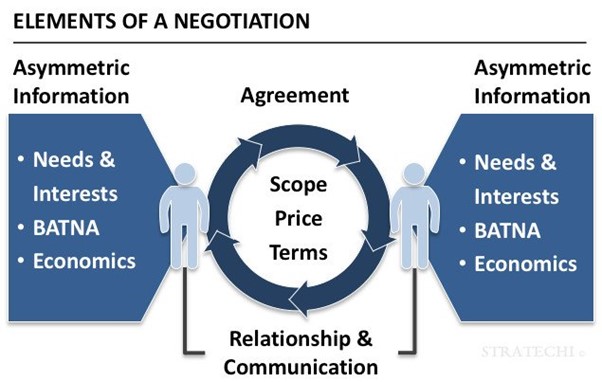
Source: https://www.stratechi.com/negotiation-strategy/
Before you enter the bargaining stages, consider the following advice:
Prepare Thoroughly
Coming to the discussions unprepared is one of the most elementary blunders you can make when negotiating. It’s crucial to realize that the negotiation process doesn’t actually start when your team sits down with the vendor team across from you at the negotiation table, but rather several months earlier. The majority of the time, you will discover that your efforts prior to starting the negotiation process are just as crucial and play a bigger part in getting a favorable result than the actual time you spend meeting and discussing terms with the vendor’s personnel.
Organizations (really, individuals, since humans conduct all negotiations) do not devote enough effort to three crucial pre-negotiation steps:
• Compiling the necessary internal data.
• Examining the data.
• Examining prospective plans.
• Outlining the negotiation’s ideal result.
• Understanding the objectives of the opposition.
Neglecting these problems will inevitably lead to unsuccessful negotiations. Similar to this, a software licensing agreement that saves your business money and/or includes more or better software licenses is an unavoidable result of careful planning, investigation, strategizing, and negotiating.
Set Clear Goals.
A good negotiation depends on setting objectives that are both attainable and reasonable. A clear set of objectives will guide your strategy and tactics, let you gauge your progress and identify your “red lines” or reservation spots (what is unacceptable).
You or your business may accept terms that are less favorable than you anticipated and that you may regret in the future if these constraints are not upfront identified.
Establish your BATNA
The phrase “Best Alternative to a Negotiated Agreement” is denoted by this abbreviation (Fisher, Ury and Patton, 1991). To put it simply, the technique is to have at least two or three backup plans in case your original plan doesn’t work out. This entails deciding whether you’re ready to walk away from a negotiation or when you’re willing to accept terms that are more favorable than what you initially sought.
These are viable alternatives to take into account, not the objectives you set out to attain during the negotiation process.
Know how the software vendor operates
You must decide your own objectives, reservation points, and BATNA, and you must do the same for the software provider. You can better comprehend the challenges you’ll likely face during negotiations by understanding the software vendor’s interests and objectives.
A variety of sources, including informal conversations with the Account Manager of your software vendor, can be used to gather this information. Account Managers are often required to raise license revenue from your previous or current deal by between 15-20%, which is a fairly high bar that the vendor sets for them. Making a list of the decision-makers on the vendor side and figuring out who has the authority to accept concessions should be part of your preparation. Each vendor uses a defined process for contract negotiations that includes laying out guidelines for when and who can provide concessions at various organizational levels.

Determining When to Negotiate
The acknowledged ideal is during the end of the year, when businesses are attempting to meet their sales targets. The end of the fiscal year may occasionally differ from the conclusion of the calendar year. For instance, the fiscal year for Microsoft ends on June 30. As a result, around April or May, a series of promotions are released in an effort to boost sales. The thirty-day grace period that was previously available for renewing an enterprise agreement has been eliminated, so you must account for this change when determining when to contact Microsoft. Beyond the date of agreement renewal, discounts that are currently outlined in your licensing agreement won’t be honored.
Account Managers will exert more pressure to conclude the negotiation cycle as the deadline approaches since they are aware that they would be penalized if their account agreements are not renewed on time. Check whether a particular promotion is applicable to your location when you start to weigh your alternatives; frequently, promotions are restricted to certain nations (this information can be obtained from your Reseller). Once you’ve decided when you want to start negotiating, you need to block out more time for pre-negotiation planning and research. You may miss the chance to determine when to bargain if you wait until the software provider approaches you. The less time you have and the more pressure you will feel, both from the vendor and from within your organization, the closer the renewal deadline approaches.
Understanding what to negotiate
Sometimes it’s more crucial to know where not to put your time and energy than it is to choose a specific area. There are some compromises that are simpler to negotiate than others, while some are predetermined by the program manufacturer. The pricing, product mix, length of the agreement, payment conditions, and other negotiable matters will be the focus of savvy negotiators.
Get Everything in Writing
Have the software licensing agreement’s comprehensive list of official declarations, which includes all agreements regarding concessions, special terms, and conditions, formalized into a document.
There is no legal standing for local subsidiary letters, sent notes, or verbal commitments, therefore do not accept them. Record all suggestions made during the conversation and confirm they are included in the final agreement before signing. Too frequently, throughout the negotiation process, parties provide extra perks that do not end up in the final contract. The discrepancy is not discovered by the corporation until much later, by which time it is too late. According to the law and the seller, if it is not stated in the agreement, it does not exist.

Important negotiating points to consider
1. Always begin with a draft!
Having a contract to negotiate is the most crucial step in being ready for a contract negotiation. Sounds easy, don’t you think?
You’d be shocked at how frequently parties attempt to discuss an agreement’s parameters in advance without first having the document in writing. This usually occurs when the distinctions between sales conversations and contract negotiations are lost.
The process of discussing the specifics of a potential connection is significantly more productive when there is a formal contract in place to capture all of the pertinent parameters, despite the temptation to get right into a detailed negotiation.
If you don’t, you’ll either have to go through the negotiation process again after a contract has been formed, or worse, you’ll sign a contract without genuinely agreeing to all of its conditions.
Using automatic contract templates is the greatest approach to make sure that you always begin contract negotiations with a draft. There is no justification for not having a contract draft on hand because automating contracts using a technology like Juro makes making contract drafts simple.
2. Know who you are negotiating with.
Knowing who will be on the other side of the table and what they could want from any revisions is one of the finest methods to get ready for a contract negotiation. Having this knowledge before the negotiation will offer you the chance to develop a stronger argument that is suited to that person’s requirements and desires.
It’s also a fantastic method to convey respect and professionalism. Understanding the other party in advance of a negotiation allows you to spend less time trying to comprehend each other’s points of view during the negotiation and more time updating the terms that are most crucial.
3. Brush up on your skills.
It may seem apparent, but practicing your negotiation techniques is another great method to get ready for a contract discussion. You could achieve this by finishing a course on contract negotiations or being acquainted with the most effective contract negotiating tactics.
Even better, practice the negotiation with a coworker to hone your negotiating abilities. This can help you anticipate any potential conflicts and improve your ability to deal with objections.
4. Draw on past experience.
Contract talks don’t typically go perfectly every time. There are both successful and unsuccessful bargaining sessions, as the majority of seasoned attorneys will attest to.
Fortunately, one of the best ways to get ready for a contract negotiation is to have these experiences. It offers you the ideal chance to determine what functions well in particular situations and what doesn’t.
Analyzing past contracts and the contract information contained in them is another excellent piece of advice. This may be done rapidly with the use of a contract repository or contract storage system, and it’s a useful technique to identify the clauses that have previously caused disputes between the parties.
5. Examine the contract in advance.
No of how many contracts you’ve handled over your career, waiting until the very last minute to analyze a contract is never a good idea.
Before starting the negotiating stage of the contract lifecycle, it’s crucial to give oneself adequate time and mental space to thoroughly analyze the contract. This time gives you the opportunity to develop stronger arguments, reduce risk, and negotiate with greater assurance.
6. Get your concessions ready (and non-negotiables).
Knowing your position inside and out is one of the most crucial negotiation preparation advices. Choosing what you’re willing to accept and where your objections are will help you achieve this.
You’re more prone to make hasty conclusions if you go into a negotiating exercise without knowing what your compromises and non-negotiables are. More concerningly, you might make decisions that haven’t been sanctioned by the pertinent business stakeholders.
Discussing your willingness to make concessions in advance with other teams engaged in the contract’s implementation is the best method to get ready for these conversations. By removing the requirement to acquire contract permissions in the middle of a negotiation, this can avoid additional delays.
7. Recognize the real purpose of the negotiation.
Legal teams frequently grow preoccupied with the idea of “winning” a negotiation. But is this truly what contract discussions are aiming for?
One of the most crucial things to keep in mind before starting any kind of negotiation is that there doesn’t always have to be a winner and a loser. In fact, when both sides succeed, at least somewhat, it’s frequently better for the relationship’s health.
You can concentrate on the disputes that are most important to your organization and not just your desire to “win” by adopting the mentality that negotiations can be collaborative processes rather than competitive ones.
8. Create an agenda.
Going into a negotiation without a predetermined agenda is one contract management error that companies frequently commit.
Too frequently, parties enter into discussions intending to go over the entirety of the contract’s provisions in the order they were written. Although this is a thorough strategy for bargaining, is it practical?
Sincerely, no. Attorneys are quite busy. They do not have the time or resources to negotiate every single clause in a contract. They need just talk about the murky or disputed clauses that cause conflict.
Making an agenda for a negotiating meeting in advance is a wonderful method to identify these places of friction and rank them appropriately. A good technique to make sure you’ve addressed everything that needs both sides’ attention is to lay out a clear structure before the meeting.
9. Take contract management software into account.
Creating the ideal climate for these conversations is one method to make them go as smoothly as possible. Traditionally, this setting would be a calm office where parties would speak face-to-face about the details of a contract.
Contracts are rarely agreed upon in this manner today, though. The majority of contracts are negotiated online and remotely. This presents a number of challenges, such as a lack of version control and challenging Word redlining procedures.
Fortunately, contract management software eliminates this complication, allowing business and legal teams to conduct online contract negotiations more quickly and easily. Using tools like this can change future negotiations and guarantee that you get the most out of your contracts.

Case Study: Price negotiation between Amazon and Whole Foods
Actual case:
The case study is based on a real-life price negotiation between Amazon.com and Whole Foods Market.
Whole Foods Market has been declining in performance in the market for the last two years. Due to this, the activist hedge fund that owns almost 9% of the common stock is pressuring the former.
The activist hedge fund is eyeing the reform of the management style of the executive officers as it asserted that they are the ones responsible for the poor results achieved by the Whole Foods Market. In other words, the CEO of the Whole Foods Market is in trouble of losing his position.
In light of the pressure that comes from the activist hedge fund, four different equity firms send separate inquiries to Whole Foods Market. One of the equity firms offered a share cash price of $36.00. This is in line with the historical share price of Whole Foods Market. Private investment in public equity (PIPE) is the shortcut for companies that are in need.
However, pursuing this will put Whole Foods Market at numerous disadvantages. The result of the buy-out might make shareholders quickly sell their stocks. If a large number of stocks are sold at a lower price, the private equity firm may pressure the company. Additionally, it may claim ownership of the company.
Amazon’s CEO reached out to Whole Foods Market. It was expected as many news outlets reported that Amazon is interested in acquiring the latter for opportunities in the retail sector.
The reason why the Whole Foods Market is a good candidate for Amazon to acquire is its attractive value and strategic deal. Amazon expects that it can guarantee a substantial premium. The first signal of commitment by Amazon is the face-to-face meeting with the Whole Foods Market’s CEO. Moreover, Amazon just launched a new service called AmazonFresh that fits perfectly with what Whole Foods Market has developed which is the local-based fresh-goods delivery system.
Before the prospect of acquiring Whole Foods Market, Amazon has another candidate which is Silvia’s Market. The strategy of this company is focused to become the best supermarket that a middle-class family can trust. However, looking at the collaborative opportunity of the two parties, you will start to have some doubts. This is because Silvia’s Market’s mission is too far away from the core value of Amazon which is Innovation.
That is why the most attractive option is to choose Whole Foods Market rather than Sylvia’s Market because the synergies between Amazon and Whole Foods Market are the best option.
One core aspect of Amazon is high-velocity decision-making. However, this strategy does not line up with Whole Foods Market. That is why Whole Foods Market suggested the decisional strategy of disagreeing and committing.
Most negotiators face challenges within themselves thinking about what to offer, what is the reasonable agreement to accept, and the real interest in the negotiation. For this, you would need high-velocity decision-making because time is important in negotiations and the time you will need to decide is crucial.
Whole Foods Market needs to know that Amazon is not used to long bidding wars. It needs to be interested in Amazon’s proposal exclusively or else Amazon will find another company for opportunities in the retail sector.
In the negotiation, Amazon has the upper hand as it has the capability to inflict damage on Whole Foods Market by not pursuing the negotiation. The threats looming the Whole Foods Market will cease if it collaborates with Amazon.
Additionally, Amazon demands secrecy. Any leakage will force Amazon to terminate the negotiation. In bidding situations, secrecy is important. Any leak of confidentiality will have disastrous outcomes regarding the agreements. A non-disclosure will allow Amazon to have steadiness, speed, and information symmetries in the negotiation.
Final Deal:
The limits of the offering price for each party are laid out in the agreement which makes them able to compute their reservation price (RP).
When Amazon first bid, it evaluated the historical value per share of Whole Foods Market which is about $35.00 per share. At first glance, the $42.00 per share bidding price of Amazon seems too high. However, the calculations of Amazon were totally inclined with the prospect of growth of Whole Foods Market in the case of an acquisition.
The Whole Foods Market’s attempt to counter-offering the bid with $45.00 per share was just to hold onto the financial resources of Amazon. Although we must take note that Whole Foods Market does not expect Amazon to be willing to bid at a higher price. Simultaneously, Amazon expects Whole Foods Market to accept its high offer. The expectations of both parties have coincided with one another which makes the negotiation reasonable and advantageous for both parties.
Additionally, a profitable outcome depends on how negotiators deal and discuss during the negotiation process. Being an active listener and discussing issues is pivotal in the negotiation to be successful.
Finally, after rigorous research and consideration between one another, Whole Foods Market approved the deal with Amazon which acquired the former for $42.00 per share which amounts to $13.7 billion including its debt.
What can we learn from it?
We learn from this case study that both parties must fully prepare and make an effort to retrieve data from both sides to quantify and evaluate the outcome of every possible solution.
Another is that a good negotiator can anchor the positioning battle around the other party’s reservation price. It is important to consider the other party’s perspective to take action in their situation rather than our own.
This will help negotiators to obtain information and interest with the other party while also building trust and a fruitful negotiation process management.
Lastly, we can learn from their negotiation that a final outcome can be reached once both parties meet on the same ground or terms. Both sides must be convinced that there is no use to retreat when the outcome will be good and that the negotiation is about to end.

Course Manual 2: Set Negotiation Objectives
For a contract negotiation to be effective, objectives must be set that are both clear and attainable.
Early goal-setting will help you determine your negotiation strategy, tactics, and reservation point, or the highest price you’re willing to pay the provider for their goods or services. As a result, you may be able to avoid agreeing to less advantageous terms throughout the talks.
How to set objectives for supplier contract negotiations
Your primary goal in negotiating a contract is to procure products and services that your business needs. Negotiations typically serve to determine things like:
• price and payment terms
• delivery and production times
• quality standards
• levels of service
Depending on your business needs, you may want to set different objectives. For example:
• value for money
• after-sales service
• maintenance arrangements
• length of warranty
• life-time costs of a product or service
• importance of product or service to your business
• length of agreement
• cancellation terms
Make a list of the factors that are most essential to you before you begin negotiating. Determine what you are and are not willing to give up by ranking them in order of priority.
For instance, you might want to look for a vendor that would give you a discount if you’re acquiring tech software in large quantities. Or, if you’re spending money on a difficult piece of computer software, you might want to ensure that training is included in the price.
Setting the best and the least acceptable target for each of the goals may be helpful.
After defining the negotiation’s goals, you might also wish to prepare for the possibility that a suitable agreement won’t be reached.

Goals are Important in Vendor Negotiations
You must have a distinct idea of the result you desire from the negotiation for it to be successful. You are unlikely to leave discussions with the result that is ideal for your company if you don’t have clear goals in mind. You are in a stronger position if you go into a negotiation with defined objectives and an awareness of your next best course of action.
Be SMART
Set SMART goals whenever you can—they should be precise, measurable, attainable, relevant, and time-bound. Your chances of success increase as you get more specific about your objectives. For instance, a 1% price decrease would theoretically accomplish your aims if you were aiming for something general like “I want my vendor to lower his rates,” but it might not be sufficient for your bottom line. On the other hand, getting the vendor to halve his price is probably out of the question. Prepare for negotiations by doing your research to determine a realistic estimate of what you can get.

Prioritize Your Objectives
In many talks, both sides of the table have many goals in mind. For instance, if you’re discussing terms with a vendor, your main concerns can be lowering expenses and improving responsiveness rather than particular payment conditions. More than a pay increase, your vendor might prefer to receive a larger portion of the contract money up advance. Setting priorities enables you to identify your top priorities and areas where you can make concessions.
Tangible vs. Intangible
Goals that can be measured, such as those produced by the SMART goal framework, are where negotiations begin. That maintains the emphasis on what is best for the company. However, persons taking part in a negotiation could also have illogical objectives. For instance, if a manager has received criticism for “losing” deals with a union in the past, he can start discussions with the elusive aim of coming out on top. Even if an early offer would otherwise be to his liking, this could persuade him to strike a combative attitude. Even if it means striking a deal with the local government that is less advantageous overall, a business with a bad reputation for endangering the environment may do so in an effort to improve its reputation.
Determine Opponents Goals
It’s normal to concentrate on your own objectives, but it’s also important to consider those of your adversary. Finding win-win solutions will be simpler if this is the case and finding common ground. If it isn’t possible, at least that will help you understand what the other side wants to happen. Making two or three proposals that are roughly equivalent in value to yourself and highlight various facets of the proposal might help you figure out what the other party actually wants. Then, you can see which offer appeals to them the most. It’s important to be aware of your vendor’s apparent preference for obtaining more money up front rather than a larger quantity distributed over a longer period of time.
Know Your BATNA
BATNA, or the Best Alternative To a Negotiated Agreement, is essentially what you will do if the negotiations are unsuccessful in reaching a settlement. If discussions fail, knowing your best alternative to a deal will help you choose a different path. Additionally, it increases your bargaining power and aids in outlining your negotiation “red lines.”
Even if you anticipate a positive conclusion from the negotiations, you should be aware of your BATNA before starting. Although it’s not always necessary, it sometimes helps to let the potential supplier know what your BATNA is. They might be forced to match it or make a greater offer if they know you have a superior option in order to get your business.
This aids you in determining how firmly you can adhere to your goals and how aggressively you should set them. Strike a hard bargain if your BATNA is acceptable, such as when another interested seller is prepared to commit at an alluring price. On the other hand, if your BATNA is weak, you might have to compromise on some of your lower-priority objectives in order to reach an agreement.
Find your ZOPA
Zone Of Potential Agreement is known as ZOPA. It is a region or range where the parties to a negotiation frequently find common ground. Each party’s expectations for an agreement overlap in this area. Everyone at the negotiating table needs to be aware of one another’s requirements, values, and interests in order to reach a good agreement.

What are the goals of contract management in the purchasing process?
To Ensure the Product/Service is Sold at an Agreed-Upon Price.
The conditions of the contract a company enters into with its suppliers may make all the difference in whether a product lasts on store shelves for years or progressively disappears. Vendors risk going bankrupt if they enter into a contract with a distributor who overcharges for their goods. On the other side, if a product’s price increases too dramatically, a seller can also start to have trouble.
The significance of contract management in procurement is obvious given the necessity for balance. These worries vanish after the price is agreed upon by both sides, enabling both businesses to make future plans.
To determine whether the good or service complies with the required standards of quality.
A crucial component of the procurement contract management cycle is quality assurance (QA). No company wants to feel constrained by a product that they cannot sell because customers think the quality is too low. Thankfully, the procurement contract management procedure aids in making sure that the good or service fulfills the criteria before any ink touches the line.
You may establish a stringent set of prequalification requirements that your vendors must meet before obtaining full payment, before your company finalizes any contract with a partner. All potential and future partners are able to grasp the standards they must satisfy in order to enhance sales or sign important contracts thanks to these requirements.
To Ensure the Product/Service is Delivered Timely, At the Right Place, and Correct Quantity.
Efficient delivery is one of the main problems that the procurement contract management process seeks to solve. Your vendors can comprehend the requirements they must meet by understanding the main points pertaining to distribution. If they don’t, you might find them in violation of the agreement, which might jeopardize future deals.
To Ensure that Vendor Management is Cost-Effective.
Vendor management generally refers to the activities that enable a company to implement methods for lowering risk and managing all expenses associated with sellers. Unfortunately, tracking this information can become difficult when your company starts working with several providers, which can cause things to quickly get out of hand.
By implementing a centralized vendor management system, effective contract management helps to keep the cost of managing your partners as low as feasible. This procedure keeps everyone on your team moving in the same direction, which increases productivity and cuts down on the time needed to create and manage vendor contracts.

Course Manual 3: Negotiation Strategies
Control the Negotiation Before It Begins
Numerous books and articles provide guidance that might assist negotiators avoid common pitfalls. However, some of the most expensive errors are made before negotiators even begin to talk about the details of the contract. That’s because individuals are susceptible to a seemingly valid—but ultimately incorrect—assumption about how deals are made. Negotiators frequently assume that if they bring a lot of value to the table and have enough leverage, they will be able to reach an excellent agreement. These things are crucial, but there are a lot of other things that affect how each side behaves.
In this course manual, we will talk about elements that can greatly affect the results of vendor negotiations.
Negotiate Process Before Substance
Two cofounders of a tech business entered a meeting with the CEO of a Fortune 100 corporation a few years ago with an agreement to invest $10 million with them. The parties had agreed on the investment amount and valuation a week before, so the meeting was more of a celebration than anything else. The presence of a group of attorneys and bankers astonished the co-founders as they approached the room. The CEO was present as well, but it became evident right away that he wasn’t going to take part.
The bankers on the other side began to renegotiate the transaction as soon as the co-founders sat down. The $10 million investment remained on the table, but they now requested a substantially lower valuation, which meant that the cofounders would have to forfeit a lot more stock. Nothing they did would convince them that an agreement had already been made.
What was happening? Had the co-founders’ interpretation of the prior meeting’s degree of commitment been incorrect? Had they missed any necessary procedures to seal the deal? Had the CEO always intended to back out, or had his team persuaded him that the terms of the transaction might be improved?
The cofounders quickly considered their choices after becoming upset and puzzled. They would suffer financially (and psychologically) if they accepted the new agreement, but they would receive the $10 million they required. On the other hand, doing so would seriously underestimate what they contributed. They made the decision to leave empty-handed. Before they left, they highlighted how eager they were to reach an agreement on the original terms and explained that doing so was both morally and economically right. They boarded a plane in a matter of hours, unsure of what would occur. The CEO contacted a few days later and agreed to the original arrangement.
The cofounders’ risky action paid off, although it would have been preferable to prevent things from going wrong in the first place. Their error was a frequent one: putting too much emphasis on the deal’s content and not enough on the negotiation process. The clauses that make up the final agreement are its substance. The path you will take to get from where you are to that agreement is called a process. To deal makers, I would advise: Process should be discussed before content.
Think of a different circumstance. You and the other party have been haggling for a while. The last few compromises you have to make will cost money, but they are necessary to seal the deal. When you concede with the goal in sight, the other side says, “This is fantastic. I value your adaptability on these matters. Let me discuss this with my employer to get her opinion. Unfortunately, you were unaware that your rival had a boss and assumed that he was the only person who could make decisions. You have nothing more to offer, yet it is evident that the negotiations are not finished.
You are less likely to make substantive errors the more commitment and understanding you have about the process. Discussing and influencing a variety of variables that will affect the deal’s result are part of the negotiation process. How much time will it take your company to close the deal, ask the opposite party? Who must travel with us? What elements could influence the process’ tempo? Are there important dates or milestones we need to be aware of? Always remember to ask basic questions like Who will be attending the meeting tomorrow? What will be on the schedule? When will we handle the topics that are important to us because we won’t be talking about them at the next meeting?
Naturally, you won’t always be able to acquire answers to your inquiries right away—and there are occasions when asking certain questions is unnecessary. To prevent becoming stuck on substance later, you should try to define and agree on as many process factors as you can as early as is reasonable.

Vendor Negotiation Strategies
1. Know Your Position
Although it seems simple, you’d be amazed at how frequently during negotiations comprehension gaps can be revealed, weakening your capacity to obtain the desired outcome.
Complex issues like how quickly your company can pay a provider can sometimes be resolved in simple ways. Do you know for sure whether your accounts department has the physical resources to make a payment as quickly as you would like if an agreed price depends on making a payment before month’s end?
Visualizing the negotiation process and what must follow in order for things to move forward is helpful.
Always keep in mind that a successful vendor negotiation is only a means to an end, not an end in and of itself.
Realizing the benefits covered by the vendor contract is your main objective while negotiating one. So remember them.
Over the course of a contract, less than 50% of negotiated savings are frequently realized.
During the vendor discussion, you might want to consider the following important questions:
• What’s my budget?
• What’s my hard deadline for having a deal done by?
• Who needs to sign this off and when are they available?
• What elements of the proposed deal are “must-haves” vs “nice to haves”
• What’s my alternative if I can’t get this deal done?
• Can I afford to walk away?
• If everything goes wrong later, what’s the process for contract dispute resolution or cancellation?
2. Know What The Other Side Wants (As Best As You Can)
The likelihood is that you will have a good understanding of what a potential counterparty wants if you are working collaboratively.
You should also take into account the knowledge you have in the following locations to support this and provide further context:
• A contract or proposal document
• Notes from previous meetings or phonecalls
• Past email conversations
• The vendor’s website, including recent news articles (potentially outlining personnel changes or strategic goals)
• Other clients of the vendor
All of these resources provide you with specific details and context about your prospective partner, which can improve your negotiating position.
3. Communicate Clearly
Establishing your expectations with a vendor and negotiating terms you are comfortable with depend on clear communication. By dealing with a single point of contact during the negotiation process, you can concentrate on developing a relationship based on openness, honesty, and trust.
You and the vendor can cooperate to get over any barriers standing in the way of an agreement if clear and effective communication has been established. The goal of effective communication is to keep a contract moving forward. Also important is timing.
You establish yourself as a capable partner for the future by timely and effectively responding to queries or ideas from your potential provider.

4. Build Empathy
By making sure that you concentrate on what the other party says you throughout the negotiation, you may expand on the research that you were able to conduct beforehand.
Effective listening is essential for developing empathy. It sounds easy once more. How challenging may it be to hear what the other person is saying?
The answer is “extremely,” particularly if you’re engaged in a difficult negotiation. While the other person is still speaking, it’s easy to find yourself formulating your next argument or a counterargument. Here, a straightforward strategy is to pay close attention while repeating back to the speaker the essential elements of what they just said in order to ensure that you comprehend them.
The other party will then appreciate that you listened to them, which starts a positive feedback loop.
5. Get Personal
The saying “it’s not personal, it’s business” seems to be all too common, despite the fact that it’s quite obviously rubbish. Perhaps this is the fault of the movies.
People conduct business, and the nature and quality of their interactions will have a significant impact on the results.
Think about who you will likely be bargaining with. What do you already know about them from previous conversations, and what further details can you find on their LinkedIn profile?
While you don’t have to become their best buddy, developing a rapport with them should ultimately work in your favor.
6. Avoid Fatigue
Aim to be prepared to be in it for the long run if your negotiation does come down to a single meeting.
As participants discover that the bargaining process is going longer than anticipated, fatigue may set in. If you are completely prepared, you can actually take advantage of this situation by getting others to start making concessions so that the process may be finished more quickly.
For instance, they might be under a light time constraint because they need to board pre-arranged transportation, or their first coffee’s initial caffeine rush may have gone off and not been replaced.
By taking these easy measures, you can position yourself for success:
• Expect the negotiation to last longer than the calendar invitation and factor in at least half the scheduled time again on top. Plan any booked travel accordingly.
• Make sure you have sufficient food/drink of your own to maintain the requisite energy for the whole period. Don’t assume it will be provided for you when you’d like it.
• Be aware if the venue feels too warm and, if possible, reduce the temperature or take regular breaks to keep your concentration levels high.
• Maintaining a calm temperament will burn less energy as well as helping to build trust and empathy
These tips may still be useful even if your vendor contract negotiation doesn’t entail a single summit-style gathering. For instance, if you don’t have to, hold off on responding to an email right away because doing so may result in errors or misunderstandings.
Additionally, you might want to avoid reading lengthy documents immediately at the conclusion of the workday when fatigue is more likely to play a role. Save it for the morning, then examine it with new eyes.
The worry that you might have to restart the process and hunt for different vendors if negotiations fail is related to tiredness. If you’ve invested a lot of effort into the process up until this point, that prospect could sound intimidating.
Commercial repercussions of lengthening the process should be evaluated against the possibility of reaching a less favorable agreement with this potential vendor.
The general recommendation is to avoid signing a subpar deal simply because it will take time to find a better one. You must decide for each situation whether “done” or “perfect” is preferable.
Food for thought
You probably observed from the list above that few of these actions, if any at all, call for special expertise. They primarily come from working hard to prepare and paying attention to what the counterparty is teaching you as you go.
The assurance you can get from careful planning can also help you perform better while engaging in vendor contract negotiations.
If you heed this advice, your chances of succeeding in your talks and gaining a complete grasp of the companies you have contracts with are greatly increased.
Then, throughout the contract’s duration and again at the time of renewal, this will be useful.

Win-Win Strategies to Negotiate with Powerful Vendors
Without clearly defined vendor negotiation techniques, the balance of power has drastically shifted from buyers to vendors in numerous industries. Vendors have occasionally driven out rivals by lowering prices or creating game-changing innovations. In other cases, the rapidly expanding demand for inputs has outpaced supply to the point where providers have been able to set their own prices. In still other cases, purchasers have consolidated demand, driven down vendor prices to the point where many suppliers withdrew from the market, giving the few that remain more sway. Whatever the cause, businesses that have found themselves in a precarious position with vendors need to take a calculated approach. They are no longer able to rely on difficult discussions with their procurement offices. We have proposed three approaches to deal with vendor bargaining to aid in the strategic reappraisal.
Let’s examine each tactic in greater depth.
Vendor Negotiation Strategies to Make the Right Deal
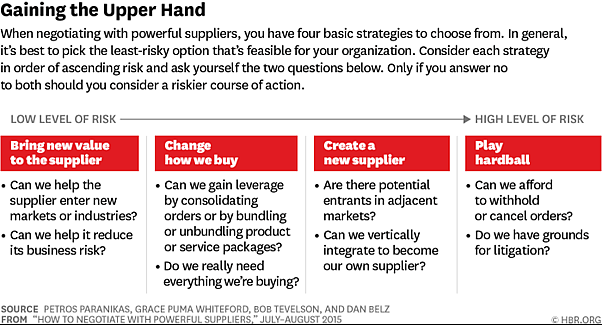
Win-win vendor negotiation strategy #1: Bring New Value to the Vendor
The simplest strategy is this one. Try to shift the balance of power to transform a simply business transaction with vendors into a strategic alliance. There are two ways for businesses to create additional value:
• Be a gateway to new markets
• Reducing the vendor’s risks
Win-win vendor negotiation strategy #2: Change How You Buy
Altering your demand pattern is your next best option. This method necessitates thorough coordination with any functions that might be impacted because it may have effects on other areas of your firm. There are three ways a business might alter its demand patterns, all of which might necessitate extensive data gathering and analysis:
• Consolidate purchase orders
• Rethink purchasing bundles
• Decrease purchase volume
Win-win vendor negotiation strategy #3 Create a New Vendor
This is a risky choice, but it has the potential to change a company’s future. This tactic is required in sectors where pricing wars have gotten so heated that the majority of vendors have shut down, thereby giving the survivors a monopoly. Businesses essentially follow two paths:
• Bring in a vendor from an adjacent market
• Vertically integrate to become their own vendor
A procurement specialist should learn to compromise as much as they can during the negotiation process. However, in order to come to a compromise that would prevent conflict and misunderstanding, one must be aware of where and how to make concessions.
In order to negotiate in a way that benefits both parties and satisfies their expectations, it is preferable for people to try to accommodate to each other. It is always preferable to analyze your contracts for negotiation with suppliers using a service vendor checklist.

5 Ways to Optimize Vendor Negotiation Strategies Amid IT Contract Inflation
Guarantee you have all the details when faced with inflated IT vendor proposals and renewals.
In short:
• Inflationary times add complexity when negotiating with vendors over pricing of IT contracts and renewals.
• CIOs and their teams need a negotiation strategy and playbook to optimize deals and must insist on price transparency.
• Use cost modeling to add rigor and power to your negotiating position as inflation hits IT contracts.
Have a vendor submitted a proposal to you in the last six months? If so, it might have sought a price increase for an IT contract that generally increases 3% to 5% annually of 10%, possibly even 30%. It could be challenging to determine if it is genuinely justified when senior management inquires. You require a sound procedure for determining the reason behind price increases as well as a plan for (re)negotiating the conditions.
Rising inflation has made it difficult for businesses to see costs clearly at a time when they are trying to use technology to cut costs and gain a competitive edge.
Beef up your vendor negotiating position
Even in the best economic times, vendor talks may be difficult. However, given today’s high rates of inflation, it is even more difficult to determine whether your vendors are tying price increases to their expenses or are only seeking to retain their profits.
According to JoAnn Rosenberger, Distinguished VP, Advisory at Gartner, “you can determine whether ostensibly outrageous price increases and excessive renewal charges are fair and in line with economic data.” But in order to strengthen your negotiating position, you need clarity and cost models.
The five actions listed below should be included in your negotiation playbook and strategy:

No. 1 Understand the root cause of IT contract price hikes
Request root cause cost information from your vendor sales teams when renewal pricing is exorbitant and proposals seem expensive. Never accept evasive justifications like “due to inflation/economic uncertainty/supply chain delays,” etc. require enough information to explain or defend the justice of unforeseen increases that significantly exceed the budget.
Give yourself adequate time to engage suppliers in fact-finding conversations for both contract renewals and the purchase of new technologies.
No. 2 Leverage data points from economic indicators for IT contract cost modeling
Public sources provide access to pricing and cost indexes such the employment cost index (ECI), producer price index, and consumer price index (CPI). Keep an eye on them to assist you in determining vendor pricing and predicting future price adjustments. Building such information into your cost models also strengthens your negotiation position’s legitimacy (see No. 3).
No. 3 Include cost models in your negotiation playbook
You can negotiate a fair price increase by using rigorous cost modeling that incorporates information that is readily available to the public.
Consider a scenario in which an application maintenance service provider notifies clients of an 18% increase in maintenance and support fees on an annual renewal statement of work and justifies the increase by citing rising internal staffing expenses brought on by labor shortages.
But according to your data, the local ECI only increased by 4% in the previous year. You can counteroffer for a more reasonable renewal price by using this as a “should cost” model.
No. 4 Tailor your negotiation playbook to be vendor- and deal-specific
Determine other vendor- and deal-specific bargaining strategies to strengthen your position.
Consider timing the discussion to coincide with the vendor’s fiscal year or quarter end date, or look at lower-cost options such offshore providers with cheaper labor rates. Telling your vendor sales staff that you would be willing to consider a multiyear option if your counteroffer is accepted could help motivate them.
No. 5 Ensure your negotiation playbook includes IT contract terms and conditions
When a merchant accepts your counteroffer, wait a few days before signing. Each negotiation presents a chance to gain concessions and enhance the terms and circumstances. If you wanted to avoid starting over in a year with the same 18% (or more) renewal price rise, you could cap future price increases for the application maintenance service provider in No. 3.
When you include the appropriate price protection language in your IT contract, you are protected against negative economic conditions and gain a cost advantage when things get back to normal.
To make your contract language more like this: “In the event you (customer) chose to renew, increases will not exceed CPI or 3% (whichever is less) over the pricing indicated in (Appendix X, Table Y),” for instance, if CPI is the index that applies to your IT contract the most.

Course Manual 4: Request for Proposal (RFP)
Benefits of a RFP
Part of an RFP is an advertisement. It lets capable candidates know that a project is moving forward and opens the door to them.
The RFP has been implemented in government as a means of ensuring that cronyism is eliminated as a factor in the awarding of contracts. Additionally, it invites competition, which is anticipated to keep project costs down.
An informal method requiring a project manager to look into and find possible vendors for a project is an alternative to an RFP. The number of possible answers may be constrained depending on how thorough the search is. The likelihood of discovering new suppliers and creative solutions may be reduced.
RFP vs. RFQ vs. RFI
Three different sorts of documents—a request for proposal (RFP), a request for quote (RFQ), and a request for information (RFI)—are used by companies and other organizations to ask the business community for potential suppliers or contractors.
• A request for proposal, as noted above, announces a specific project that is planned and solicits contractors capable of getting the job done.
• A request for quote (RFQ) is a solicitation sent to a number of suppliers seeking bids for a contract to supply specific products or services. The request must specify the quality and quantity needed, and the timing desired by the company or organization.
• A request for information (RFI) is a solicitation to suppliers for written information on the products and services that they can provide. It might be used to gather information for a database of suppliers for future reference.

Example of a RFP
Consider the scenario where the Federal Railroad Administration requests bids to fund, design, build, manage, and maintain a high-speed rail network.
Inquiring parties provide offers that adhere to the guidelines in the paper. The Department of Transportation creates commissions for additional review and development of the proposals based on those submitted by the deadline.
The proposal that best meets the DOT’s objectives is chosen, and the company is hired to complete the work.
The Bottom Line
The RFP outlines the project for both the firm issuing it and the businesses responding to it. A well-written RFP makes sure that the outcome will live up to expectations by clearly expressing the motivation for the proposal.
It also guarantees a transparent process. Ideally, several bidders will participate. This offers the company the chance to research several methods and costs before selecting the one that best suits their requirements.
You’ll probably need to complete an RFP at some point, whether you work for a small agency or a big marketing company.
You might need to compare prices if your organization needs to buy a good or service from somewhere else because it can’t do everything internally. Using an RFP, you can get quotes from several vendors and choose the one who best fits your needs in terms of expertise and price.
There is always a chance of problems when you outsource work to a supplier or vendor, such as misunderstandings about the job’s parameters and payment. A solid RFP removes any ambiguity so that all parties are clear on what needs to be provided, when, and for what price.
RFP Template
Here, we offer an RFP template you may use as a starting point for structure as well as an example RFP for more ideas. However, it is not universal; you must customize your RFP to clearly state the requirements of your business.
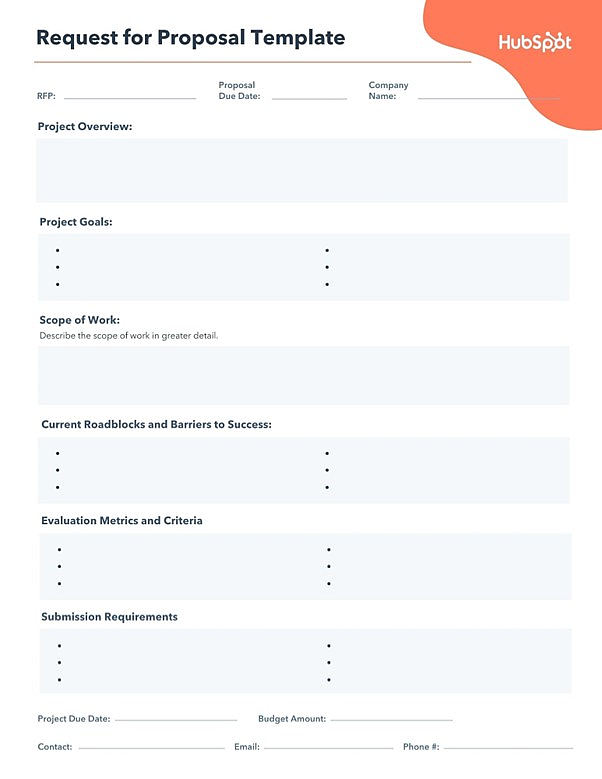
How to Write an RFP
1. Define your project, scope, and budget.
2. Provide background and introductory information.
3. Describe the services you’re looking for.
4. Detail your selection criteria and timelines.
5. Proofread your RFP and go live.
1. Define your project, scope, and budget.
Spend some time defining the project you want to execute, its scope, and your budget before releasing your RFP. This data gives your RFP structure and ensures that it achieves a balance between being too vague and being overly detailed.
2. Provide background and introductory information.
You can begin writing your RFP once you have the funding and scope in hand. While it may be tempting to go right to the facts, it’s a good idea to include some background information and an overview of your business. By giving them a sense of your existing market, business objectives, and present issues, this helps potential partners get a sense of the situation.
3. Describe the services you’re looking for.
It’s time to be more explicit about the services you require to assist you reach your objectives. For instance, if you’re creating a website, you might search for a business with expertise in both front-end and back-end development. Emphasize the necessity for specialized knowledge in the field if you’re developing a mobile app, such as proficiency in responsive design and developing applications for several mobile platforms.
4. Detail your selection criteria and timelines.
The project’s selection criteria and deadlines will be discussed next. Here, you can emphasize the qualifications needed for consideration in terms of talents, services, and market knowledge. Now is the moment to be more precise: Clear explanations of the selection criteria will lessen the likelihood that you will have to wade through numerous RFPs that don’t fit your requirements.
Additionally, it’s crucial to be honest about your deadlines. Provide potential partners with a deadline for RFP submission, a date for final decision-making, and a detailed project timeline so they can adjust their proposals.
5. Proofread your RFP and go live.
But never the least, Your request for proposals should be proofread twice. Why? Because even minor errors could cause project schedules to fall behind. Think of a missing zero in your budget estimates or a misunderstanding of the deadlines for submissions and selections; both could necessitate a repeat of the entire RFP procedure and lose valuable time.
It’s time to go live if you’re confident that everything on your RFP is correct and comprehensive. To begin the process of locating your ideal provider, send emails and publish links on your website. Consider using proposal management software to publish and manage the RFP answers to simplify this process.
You can create your own template and then fill it out so that you can start accepting bids now that you are aware of the fundamentals of preparing an RFP. The fictional corporation Caroline’s Websites, Inc. will be used to demonstrate precisely how each element must be completed.
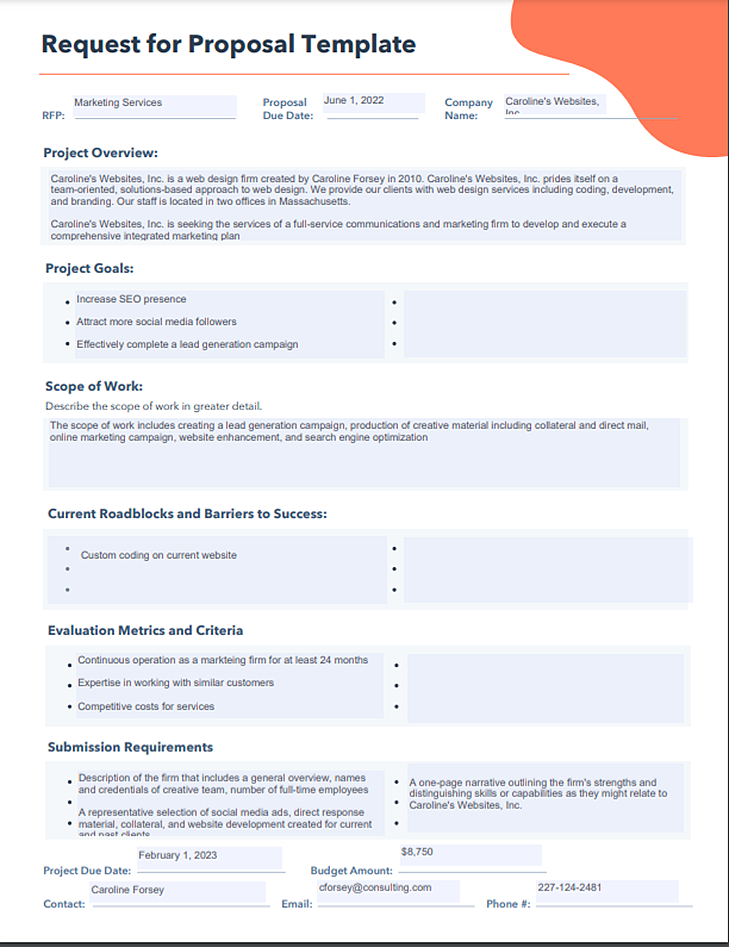
Project Name or Description: Marketing Services
Company Name: Caroline’s Websites, Inc.
Address: 302 Inbound Ave.
City, State, Zip Code: Boston, MA 29814
Procurement Contact Person: Caroline Forsey
Telephone Number of PCP: 227-124-2481
Email Address of PCP: cforsey@consulting.com
Fax Number: N/A
We’ll then examine each of the RFP’s component parts using data from the same hypothetical organization.
1. Write your background and introduction.
You should provide relevant background information about your business in your introduction, such as who started it, the type of goods or services it provides, how it differs from rivals, and its location. Any vendor who is serious about doing business with you will require this information before proceeding.
Example
Caroline’s Websites, Inc. is a web design firm created by Caroline Forsey in 2010. Caroline’s Websites, Inc. prides itself on a team-oriented, solutions-based approach to web design. We provide our clients with web design services including coding, development, and branding. Our staff is located in two offices in Massachusetts.
2. Define your project goals and scope of services.
The project you must finish and the objectives you hope to achieve from the project should then be described in detail. It’s crucial that you be as specific as you can, especially defining the specific jobs and requirements. You should use language like “The award will be given to X firm,” where “X” denotes the criteria you’ll use to select the winning applicant.
Example
Caroline’s Websites, Inc. is seeking the services of a full-service communications and marketing firm to develop and execute a comprehensive integrated marketing plan that increases our SEO presence; attracts more social media followers; and effectively completes a lead generation campaign. The award will be made to a responsive and responsible firm based on the best value and professional capability.
The selected firm will be responsible for the development and implementation of a comprehensive and cost-effective marketing plan.
Tasks include but may not be limited to the following criteria:
• Lead generation campaign
• Paid media strategy
• Production of creative material including collateral and direct mail
• Online marketing campaign
• Website enhancement
• Search engine optimization
• General account management
• Other communications and/or marketing-related assistance as required
3. Detail your anticipated selection schedule.
You must provide a thorough plan so that providers may determine whether they can meet your deadlines. Additionally, you must give vendors a window of time during which they might inquire about your project.
Example
The Request for Proposal timeline is as follows:
Request for RFP: June 1, 20XX
Deadline for Bidders to Submit Questions: July 5, 20XX[Company Name] Responds to Bidder Questions: July 20, 20XX
Selection of Top Bidders / Notification to Unsuccessful Bidders: July 31, 20XX
Start of Negotiation: August 5, 20XX
Contract Award / Notification to Unsuccessful Bidders: August 31, 20XX

4. Describe the time and place for the submission of proposals.
Similar to paragraph #3, it’s critical information that you make explicit so that vendors are aware of how and where to apply for consideration.
Example
The RFP will be posted on our website, Carolinewebsites.com, and can be downloaded from there directly as of 10 a.m. on June 1, 20XX.
Respondents to this RFP must submit one original and five copies of their proposal. Responses must be received no later than July 25, 20XX. Responses should be clearly marked “RFP-MarketingServices” and mailed or delivered to the contact person listed above.
5. Clearly define your timeline.
You can remove any vendor that can’t meet your deadlines by putting a time frame in your RFP. You may say something like, “Our company hopes to accomplish the project within six months, but we’re open to negotiation for the appropriate candidate,” if you’re flexible with your timeline.
Example
Caroline’s Websites, Inc. needs the project completed within 8 months.
6. Specify the key elements of a proposal.
You can’t necessarily hold bidders accountable if you don’t make it obvious and detailed what you want them to include in their proposal. You must specify a checklist so that suppliers are aware of the components you require. A vendor’s ability to execute all of the components of your proposal is a solid indication of their ability to handle your expectations; if they can’t, you shouldn’t trust them to complete your project either.
Example
A submission must, at a minimum, include the following elements:
• Description of the firm that includes a general overview, names and credentials of creative team, number of full-time employees.
• A one-page narrative outlining the firm’s strengths and distinguishing skills or capabilities as they might relate to Caroline’s Websites, Inc.
• A representative selection of social media ads, direct response material, collateral, and website development created for current and past clients.
7. Make your evaluation criteria clear.
You can weed out vendors who don’t live up to your expectations by outlining them. You should perform some brainstorming with your team to come up with a required list of qualities that you believe are the finest indicators of excellent prospects for this segment. Examples of prior work, a track record of success with businesses in related fields, the knowledge and technical ability to satisfy your needs, and service costs that fall within your budget are all things you might put on your list.
Example
The successful respondent will have:
• Experience working as a marketing agency for a minimum of 24 months and possess full-service, in-house capabilities for marketing, creative services, production, media planning and placement, direct response, and research.
• The education, experience, knowledge, skills, and qualifications of the firm and the individuals who will be available to provide these services.
• The competitive cost of services.
• The expertise of the firm in working with similar customers.
8. Describe any possible roadblocks.
Here, you should list any obstacles that would hinder specific vendors from effectively completing the project, like a lack of resources or a unique website. This enables you to remove unacceptable bidders and will assist you in identifying which vendors possess the knowledge and experience necessary to address those difficulties.
Example
At this time, Caroline’s Websites, Inc. currently has custom coding on our website, of which bidders should be aware.
9. State your budget for the project.
Before submitting a proposal, any vendor has to know how much you can afford to pay for their services.
Example
Caroline’s Websites, Inc.’s budget for the project is $8,750.00.
These elements were written in a way to clarify the scope of the project that Caroline’s Websites, Inc. wants completed so that suppliers know whether or not to make a bid. Defining the project allows the bidder to determine if they’re a good fit and how much they’d likely charge. Being as transparent as possible serves to benefit (and even protect) both parties in the long run.

RFP vs RFI
An RFP often comes first in a chain of requests for information (RFI). RFPs assist businesses in making decisions, whilst RFIs are intended to identify possible vendors.
RFIs are used to gather information, as the name implies. Companies utilize them to gain a sense of what solutions are available and how the providers of those solutions might be able to assist in resolving important issues or completing important tasks. RFIs demand information from businesses about what they do, what they have to offer, and how they might assist in achieving particular objectives.
RFIs are followed by RFPs. Companies create RFPs that specify precisely what they’re seeking for, how much money they want to spend, and how bidders will be chosen using the information acquired from RFIs. In practice, RFIs help RFPs focus their scope in order to speed up the selection process.
It is noteworthy? Another choice exists if you are certain of the goods or services you need: Demand for quote (RFQ). An RFQ is about cost as opposed to an RFP, which requests proposals from possible partners based on their knowledge and experience: You want to know how much it would cost a specific vendor to provide “X” service or solution in “Y” time frame under “Z” circumstances.
Realizing Best Results for Your RPF
Your RPF creates the framework for businesses to submit bids for projects that fall outside the purview of your internal competencies but are yet essential to the success of your company.
To assist discover the right partner for your project, make sure your RFP is crystal clear, succinct, and captures the essential information about your needs.

Course Manual 5: Due Diligence Checklist
Effective Vendor Due Diligence Best Practices
Vendors are becoming important assets for many organizations’ daily operations across all industries. However, it’s crucial to remember that when a firm chooses to collaborate with or buy a vendor, they are choosing to accept responsibility for any risks or disadvantages that the company may pose, as well as its digital operations.
Since dangers to an organization’s cybersecurity are becoming more prevalent and potentially expensive, it is important to identify these threats at the outset of the due diligence process. The appropriate programs can then be implemented to lessen them. While conducting effective vendor due diligence is specific to each firm, there are some general best practices to bear in mind.
How is vendor due diligence conducted?
In-depth questionnaires that serve as a comprehensive audit of a vendor’s environment are frequently used to conduct vendor due diligence. Utilizing questionnaires and surveys, possible dangers to the business’s finances, reputation, cybersecurity system, and other organizational assets are found. The procedure should be exhaustive so that any issues may be resolved before working with a vendor or so that, if necessary, rates and contracts can be renegotiated. Depending on each organization’s access to information and how important that information is to carrying out company activities, different requirements for a thorough process will apply.
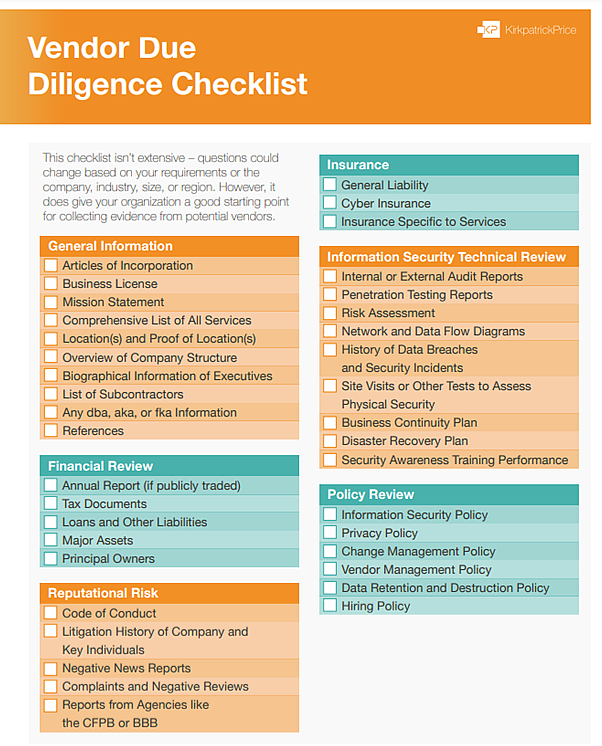
Creating a Vendor Due Diligence Checklist
It’s time to reconsider and develop your vendor due diligence process, whether vendor management is still carried out in-house or as an outsourced service. Start with these five suggestions:
Prioritize Vendors by Risk
All vendors should be given due diligence, but not to the same extent. The amount of due diligence performed by far too many organizations on each vendor is uniform, which probably leads to insufficient due diligence on higher-risk vendors and excessive due diligence on lower-risk vendors. That is an inadequate and ineffective proposition that will result in loss.
This issue can be resolved by employing a risk-based vendor due diligence strategy. It concentrates your efforts on the areas that will yield the greatest rewards, which also happen to be those that are highlighted by regulatory advice. The four main steps of a risk-based vendor due diligence checklist are as follows:
1. Pull the most recent list of all your vendors
2. Classify them by definitive “risk-based” categories:
• General vendors: vendors who do not have access to your network or your data. These account for the majority of vendors.
• Confidential/Sensitive Data vendors: your sensitive and/or confidential data and information is in their hands
• Strategic vendors: you cannot do business without them.
3. Perform the appropriate level of due diligence as described below for those risk categories.
4. Repeat the due diligence at appropriate intervals (for strategic vendors, no less than annually).
General Vendor Due Diligence: Quick and Painless
Every time you get into a contract with an outside vendor, look into the following aspects and make sure all related paperwork is kept in a secure location, such as a dedicated vendor management repository:
• Business Impact Analysis: Ask yourself: what happens to your organization if something happens to this vendor, i.e., they go out of business or lose a key subcontractor?
• Business Type and Status: Determine if the vendor is a legal entity, and of what type: corporation, LLC or sole proprietorship.
• Insurance: Confirm the vendor has general liability insurance and if any specialty insurance is needed.
• Contract: Develop a written, enforceable agreement.
• Service Level Agreements: Ensure that both parties have agreed on how performance will be measured.
• Relationship Owner: Identify the employee who will own this relationship and monitor performance.
• Confidentiality Statements: This typically occurs when proprietary information will be shared with the vendor, i.e., details about an upcoming product launch shared with a graphic designer or freelance writer.
For vendors in the General category, which probably makes up the majority of your vendor list, this amount of due diligence is adequate.
Confidential/Sensitive Data Vendor Due Diligence: Extra Cautious
Vendors should be listed under the Confidential/Sensitive Data category if they have access to your private information. You must complete the duties for General vendors as well as sufficient additional due diligence on these suppliers to determine whether they can safeguard your data to the standard demanded by the Gramm-Leach Bliley Act, such as:
• Third-party Audit: Determine if the vendor has a current, appropriate third-party audit on file and collect the corresponding SOC report. In the absence of an external audit, your organization may use an internal audit to determine if that gives you enough confidence about the vendor’s internal controls and ability to keep data secure.
• Additional Insurance: Confirm that, within the vendor’s general liability policy, it has specific Cybersecurity and Errors and Omissions (E&O) coverage.
• Bonding: In addition to insurance, confirm that the vendor is bonded.
• Specific Contract Language: Pay more attention to GLBA vendor contracts, incorporating specific language about your right to audit and their responsibility to safeguard confidential data.
• Confidentiality Agreements: While a confidentiality statement may not be required for all general vendors, your organization should draw up confidentiality agreements with all GLBA vendors because of their access to your confidential information.
• Information Security: In addition to contract agreements about information security, obtain a copy of the vendor’s Information Security Policy.
• Business Continuity and Disaster Recovery: Review the vendor’s Business Continuity Plan, including all test results to gain reasonable confidence that they can protect your data in the event of a disaster and have accounted for all foreseeable disasters. Does the plan give you reasonable confidence that they can continue to offer services in the event of a disaster or other business interruption? While many vendors will not share their entire plan due to the ensitive information contained, a summary should be available for review.
• Employee Background Checks: Understand the vendor’s hiring protocol, including whether they complete background checks for functions that will be responsible for your data.
• Additional Questions: Additional questions may be necessary depending on the access to data or systems granted to the vendor and the work performed by the vendor. This may include questions about their information security or systems protocols, procedures for breach notification, etc.
• Vendor’s Own Due Diligence: Find out if the vendor is conducting adequate due diligence on subcontractors used to perform services.
Even while these extra processes will take more time, keep in mind that only a limited number of vendors require this level of due research.

Strategic Vendor Due Diligence: Ensure Your Business Viability and Continuity
These are the suppliers who are essential to the operation of your institution. They carry out a crucial technological, operational, product, or channel function. The strategic category typically has the fewest vendors, producing an inverted relationship: the fewest vendors demand the greatest amount of due diligence. Along with the above-mentioned confidential/sensitive data and general information, you should also gather the following:
• Financial Soundness: Review of the company’s financial statements, conducted by someone with extensive finance and accounting experience.
• Ownership of the Company: Determine who owns the company, and whether it’s a domestic or foreign entity. In many cases, it will be important to research beneficial owners who may not be legal owners.
• Contract Protections: Use detailed language that ensures the continuity of the vendor’s critical function.
• Continuous Relationship Monitoring: Identify how (manually, systemically or both) the vendor’s performance will be monitored, and by whom.
• Capacity: Determine the vendor’s capacity. How many other entities does it serve? Are you confident in the vendor’s ability to continuously provide the function you need?
• Legal and Compliance Issues: Check to see if the vendor has any pending lawsuits or compliance violations and review their past history of the same.
• Mergers or Acquisitions: Be aware of any news regarding mergers or acquisitions with the vendor. Make sure your contract protects you in any of these events.
• Corporate Image, News and Social Media: Follow their brand in traditional and social media in order to intercept any hints of trouble for the vendor.
• Alternative Vendor on Deck: Identify another viable vendor who could take over in the event this vendor can no longer perform their critical function.
That’s a lot of effort, but for the majority of enterprises, just one or two vendors—and very rarely five—need to have this done.
Don’t Go Overboard with Vendor Due Diligence Policies
Making the application impossible to manage is one of the most frequent blunders in vendor management. This frequently results in unreasonable and unsustainable expectations because of a misunderstanding of what is anticipated, which lowers the effectiveness of a vendor management program. Recognize the “why” behind each document request and inquiry made. Ask only the questions that are pertinent to your due diligence methods, as opposed to using cookie-cutter lists of hundreds of inquiries.
Comprehensive Vendor Management is Achievable—and Necessary
Even if it takes time, it’s in your institution’s best interest to make sure that general vendors have undergone the necessary due diligence, confidential/sensitive data vendors can safeguard your sensitive data, and strategic vendors can carry out their vital tasks. If not, the fine might be in the form of both lost business and compliance issues, which would be a double blow for any company.

8 effective vendor due diligence best practices
Although the process of vendor due diligence is not “one-size-fits-all,” there are some universal pieces of knowledge that may be used to build a strong understanding of an organization’s risk profile.
When evaluating a vendor, keep these 8 best practices in mind:
1. Collect business information
In order to establish the validity of the corporation and make sure that all compliance needs and standards are being met, start the process by gathering basic corporate information. Refer to reliable sources from those offered by the company as well as any information that is available to the public that could affect your organization’s capacity to hire or collaborate with a certain vendor. This is also an opportunity to assess how well employees understand cyber threats and how to behave in order to find any potential weak points that could be exploited by careless or displeased workers.
2. Review financial information
Reviewing an organization’s financial records is crucial before dealing with a vendor to make sure it is financially sound and current on any applicable licensing fees or taxes. Furthermore, being fully aware of an organization’s growth history might be useful in estimating long-term expenditures associated with dealing with third- and fourth-party vendors.
3. Note operational risks
Your company will also take responsibility for any priceless consumer information that may have been compromised as a result of a breach at a vendor in your supply chain. This is why every firm in your network needs to have a business continuity and disaster preparedness plan in place in case there is a data breach.
This strategy defines the methods an organization will employ to restore regular business operations and guarantee effective and open communication with the appropriate parties. It’s crucial to take into account the vendor’s function inside your company so you can fully comprehend the operational effects of a third-party data breach and make the necessary preparations.
4. Assess legal risk
Certain third-party vendors will have access to very private data about your business, customers, and workers. Therefore, evaluating the legal risk that a company poses in great detail is an essential element in the due diligence process. Your company will be responsible for mitigating the legal and reputational harm if a third-party vendor encounters a data breach or controversy. Assuring compliance and identifying any potential legal concerns at the outset of the process is crucial for this reason.
5. Evaluate cybersecurity risk
The 2019 Cost of a Data Breach Report from Ponemon estimates that third-party-related breaches can cost on average more than $370,000. To prevent breaches from happening, it’s crucial to manage the cybersecurity risk posed by partners, suppliers, and vendors. The vendor’s cybersecurity posture, compliance status, and attack response programs should all be examined by organizations.
6. Prioritize risk profiles
As was already said, some third-party providers will have greater access to the network of your company than others, necessitating more monitoring. Prioritize suppliers or prospective targets for mergers and acquisitions depending on their level of access, the information that is exchanged with them, and the significance of the service or good that the company is offering. This will serve as a roadmap for the remainder of the due diligence procedure and inform IT security as to which vulnerabilities require quick attention in order to have the most impact on risk reduction.
7. Continuously monitor vendor risk
The continuing strategy of third-party vendor risk management extends beyond the due diligence procedure. As the digital transition continues, businesses are continuing to expand their networks while the threat landscape is always shifting. The vendor’s cybersecurity network should be regularly checked for changes in risks as part of an efficient third-party risk management program.
8. Automate the questionnaire process
The process of filling out a due diligence questionnaire can be time-consuming and need a lot of resources, time that would be better used on other crucial activities by IT security teams. Determining the following procedures for risk mitigation can take many hours of back-and-forth dialogue. The procedure can be automated to speed up operations, guarantee consistency, and give complete visibility into a vendor’s cybersecurity network with the correct third-party risk management software.

Choosing a Compliant Vendor
You might be in one of the following positions once your potential vendors have submitted all of their responses from the due diligence checklist:
• A potential vendor is not willing to answer all of your questions. Depending on the nature of your question, you may have the right to be suspicious of their processes and determine that they do not understand your standards.
• A potential vendor answers all of your questions but their evidence proves they pose a significant risk to your company, and it is unreasonable to try and mitigate. Cross them off your list!
• A potential vendor doesn’t quite meet your standards, but the risk they pose isn’t significant, and they are willing to improve their information security practices in exchange for your business. Now it’s up to you to determine what you require of them to change – more frequent pen testing? A SOC 1 Type II report? The inclusion of new Trust Services Criteria in their SOC 2 audit? Better policy documentation?
• You have more questions based on a potential vendor’s initial answers. Ask them! If they want your business badly enough, they will cooperate with your due diligence process.
• One potential vendor’s security processes stand out among the rest – your choice is easy!
Use this vendor due diligence checklist as a reference if you don’t already carry out vendor due diligence. Your business may be in trouble if you select a vendor without screening them, determining what kinds of vendor risk they pose, and determining whether the connection will help you reach your goals.

Course Manual 6: Check References
Questions to ask during an association technology vendor reference check
1. How do you make use of the supplier/technology?
Determine how much of the reference’s experience is relevant to your circumstance by asking this inquiry. Do they using the vendor’s services/technology in the same manner or to the same extent as you anticipate they will?
2. Why did you choose this vendor or technology above others?
Find out why the vendor was picked above the other suppliers the reference considered throughout their selection process and what benefits they brought to the table.
3. How effectively did the technology/vendor meet your needs and expectations?
Check to see if the technology/vendor meets the references’ expectations. Why did they fail, if so? How did they surpass expectations, if at all?
4. How successfully did the vendor adhere to the initial spending plan and delivery schedule?
Investigate further to determine the reason if the project didn’t stay inside the budget or schedule (s). Sometimes the customer, not the vendor, is to blame. The client might have altered the project’s scope or missed deadlines for certain tasks.
5. Describe your partnership with the vendor in item. Do you see them as a collaborator in your success? If not, why not?
You’re looking for a partnership, not a deal. The vendor and the client must both work to maintain a positive working relationship.

6. How well did they work with integration partners and other vendors?
The difficult task of maintaining vendor relations will be made easier if you know your vendor has a history of successful vendor collaboration.
7. Please share a time when a vendor or piece of technology did not perform up to par. How did they fix the problem?
You want to know how well the seller took responsibility for any errors and how well or soon they fixed the problem with this question.
8. Please provide an example when the vendor or technology was a perfect fit.
Give the reference a chance to highlight their best moments working with the vendor.
9. What is one tip you wish you had known before working with this vendor/technology?
Look for any potential obstacles that may be disguised and harm your forthcoming endeavor. Request specifics and examples.
10. Given what you know now, would you choose this vendor/technology again? If not, why not?
This inquiry probes the root of any issues the reference could have with the vendor or technology. Possibly dig a little here.
11. Was there anything I should have inquired about? If so, how?
There are times when the reference has a specific question for you yet it may not be on your list. Give them the chance to tell you whatever else they may have to say.
Consider the role of the reference
Consider the reference’s involvement in installing and utilizing the technology while posing these queries. Instead of the vendor’s reference in the membership department, you might need to speak with someone in the IT department if you want to learn more about integrations. The reference may not have the implementation or user experience necessary to supply you with the information you require, even though they are the one who signed the contract.
The provider will give you positive recommendations from satisfied clients. That’s a complete picture, right? Think considering getting opinions on the vendor from your network of association connections and other technological partners. Ask the vendor about the problem if you learn anything alarming, being sure to keep your source confidential if they speak with you.
Before spending time and money on any vendor or technology for your association, ask these questions to elicit both positive and negative feedback. It is preferable to plan for dangers than to be caught off guard by them.
You’ll spend some time studying criteria after you’re hard at work with your chosen provider. Keep your nerves from getting frayed.

Further example questions
These inquiries, which are directed toward client/case management systems, are perhaps more numerous than it would be appropriate or practicable to ask in a real-world situation, but they might be helpful when utilized selectively in other contexts.
Italics explain why a particular question is being asked.
Organizational questions about the referee
This information will help your organization understand the referee’s organization and situation and whether it aligns with your organization’s needs. Possible questions include:
• What does your organization do? How many staff members do you have? How many clients do you provide services to? How many and what services do you provide?
• How long have you been with the organization? What do you do within the organization? How do you use the system? (The view from an IT person will be different and have a different weight than from a CEO.)
• What system did your organization use before? (If it was a ‘poor’ system previously, any average system will seem wonderful now.)
• Why did your organization acquire this system? What was your organization hoping to achieve?
• How long has your organization been using the system? What is your organization using the system for? How many users does your organization have?
Quality of the software
This information should help you understand more about the software that your organization is considering. Possible questions include:
• What version of the software does your organization have now? (If different from what you are being offered, problems that the referee organization may have experienced may have been addressed in the interim.)
• Is the system reliable? Does it do what your organization expected it to do?
• Are there any workarounds that the users need to use that they did not know about beforehand? Is there any plan to address these?
• Are the configurable parts of the system easy to modify to meet your organization’s particular requirements?
Implementation and data migration
This will give you an indication of:
• how accurately the vendor understands a client’s particular requirements
• how accurately the vendor estimates the work required to meet the client’s needs
• the vendor’s team’s capability to scope and project manage an implementation, delivering to a timeline and a budget
• the amount of work the client needed to undertake – internal project management, user acceptance testing, user training, etc. For some systems, this can be a significant time and cost.
Much of this will also be applicable for any subsequent additions, changes or enhancements that may be requested.
Possible questions to ask include:
• How accurate was the proposal with respect to time and cost? If the proposal was inaccurate, what was the main cause?
• What was the implementation process like?
• Was there a written implementation plan with responsibilities, milestones and dates?
• What were your resource requirements for the implementation (e.g. time, people, etc)?
• Was the vendor’s implementation team on-site or available during the first reporting cycle? Did everything go as planned?
• Was the quality and amount of the training satisfactory?
• Did the vendor migrate data for you? How accurate was this process? What were the costs associated with data migration?
Quality of the vendor’s customer support
These questions give you a sense of the ongoing support that is being provided. Questions include:
• What is your relationship with the vendor like?
• How knowledgeable are the vendor’s customer support people?
• What are the response times for help or issue resolution and are you satisfied with these?
• How do the vendor’s customer support people treat your organization’s people?
• How does the vendor charge for support (e.g. fee for every question)?
Ongoing IT resources needed to support the system
It is important to have a good understanding of the amount and type of resource you will need to support your new system. This will help you understand how to get the best out of the system. Questions include:
• How much time does it take your organization to manage the system?
• What level of internal IT expertise is required to manage and maintain the system?
Flexibility and future use
This is to determine how flexible the system is. How has the system been able to adapt to the referee organization’s changing needs and the vendor’s response to those changes.
• Have you ever requested any enhancements?
• If so, did you get them? Were the estimates for time and cost accurate? How long did it take to get the enhancements?
Vendor’s commitment to your success
Systems involve a significant investment and these partnerships are generally long ones. These questions will help you to develop a sense of the values of the vendor organization. Questions include:
• Is the vendor fair and reasonable?
• Do you enjoy dealing with the vendor?
Closing question
• If you could do it again with what you know now, would you make the same decision?

Strategies for maximizing each reference call
Eventually in the procurement process, you will want to speak with clients of the finalist under consideration. Here are seven strategies for maximizing each reference call.
1. Be considerate of their time.
They have nothing to gain for the person who answers your call. The call is therefore a “favor” for both you and the deserving seller. If you’re not ready to shoot, no reference will buy you any extra time. Referral calls should make an effort to confirm your choice once you’ve made it. Contacting a reference should only be done to confirm information. The golden rule is relevant. Treat others well
2. Come prepared.
Everyone is occupied. So arrive on time. Keep an eye on the time. Limit phone conversations to 30 minutes and 20 questions. Send inquiries with your invitation so the other person can see them beforehand. If a reference is aware of what you plan to ask, they are more likely to accept your invitation. They might even prepare a more intelligent response or invite additional people on the call so they can answer the question more effectively.
3. Stay light on your feet.
If the reference is running late for the call or takes too long answering each question, keep your schedule free for 30 minutes following the call. (It does, in fact, happen.) Keep an eye on the time and, if necessary, skip any irrelevant questions. Finish on time. Only go back and finish what you missed if they’re kind enough to extend the call.
4. Qualify up front.
Ask the vendor for references of people who have P&L responsibilities and first-hand knowledge of their solution portfolio. Talking with references who are “still under development” is best avoided. Ask a few qualifying questions at the beginning of the reference call, such as, “Which of your online properties use the vendor’s solution? Do you oversee their P&Ls separately? How is your group set up? When did you initially introduce the vendor’s product? What recent significant update occurred?
5. Maintain an enthusiastic tone.
Every reference wishes to compliment someone. Immediately after the qualifying questions, stay upbeat. Find out the vendor’s advantages first. What are the one or two things the seller does well, for instance? This tactic is comforting and reassures the reference that you will treat them fairly if they decide to be open with you.
6. Provide a counterpoint by requesting that they “suggest improvements”.
A reference will be hesitant to claim that the vendor is terrible, even if they are. Do not anticipate a reference to discuss sensitive information. But it is acceptable to inquire about areas in which the vendor may excel. Asking tactfully, “How would you reply if the merchant asked your advise on areas they may improve?”
7. Pay close attention and restate for clarity.
Ask concise questions. Make the most of the reference’s available time. Listen carefully and speak slowly. Each response should be followed by a concise one-sentence summary before going on to the following question. If you responded, “I’d give them a 5, because,” then. So a 5 on that, is your reply.
8. Use a measuring stick.
Ask them to grade on a scale whenever it is feasible. For instance, “How satisfied are you with…on a scale of 1 to 5? How certain are you that…? How did they perform with…? Use metrics to ground each subsequent reaction. Do not inquire as to why they gave the best rating. Just keep going. Pay attention to everything that jumps out. If the results are 5, 5, 5, 5, 3, pause and dig a little further.
9. Look ahead.
The future should also be considered in the reference, not only the past. How confident are they about using the vendor in the future? I always inquire if they believe the provider will satisfy their demands in the following three to five years. If they hesitate to answer this query, it is a huge warning sign.
10. Conclude strongly.
Finally, I want to end with three crucial queries. (a) Would you refer this supplier to a friend who has comparable requirements? (a) Are there any crucial inquiries I missed asking? Is there anything else you wish you had known before hiring the vendor? (c) Would they be open to taking a call from you again if you had more queries?
By adhering to these best practices, you may reassure the sponsors of your own projects and be better prepared for the future. Additionally, you might be able to turn a business rival into a valuable resource you can use in the future. Simply adhere to the golden rule.

Course Manual 7: Exit Strategy
The Importance of an Exit Strategy in Vendor Management
Why do we want to go into a relationship thinking about the exit?
It does appear illogical. Before you even begin, you’re talking about the “what ifs” of how the book might finish, despite the fact that you’re enthused about this fantastic new third-party provider who is going to help address one of your major difficulties.
Think about the analogy that follows. Even if you know from the statistics that the flight will be safe, the flight attendant still takes the time to go through safety procedures and point out emergency exits as you board the plane. An exit plan is really no different than that: you plan for the worst-case scenario.
A Vendor Exit Strategy: What Is It?
Really, it’s extremely easy. An exit strategy involves planning for what would happen if the business you are working with suddenly ceased to exist. What do you do if a natural calamity strikes, they unexpectedly go out of business, or they are acquired?
Here are 5 crucial actions to take long before that occurs, ideally even before you sign a contract:
1. Have a conversation with your organization’s subject matter experts on the exit strategy. Sometimes the escape plan is as straightforward as switching vendors.
2. If something happened to the vendor that would have an impact on your operations, provide a clear timeline of what would need to happen to minimize the interruption to your business and your customers.
3. Take into account all of your options, whether they involve a gradual winding down or a speedy plan that can be implemented.
4. Have it examined, tested, and possibly even incorporated into the contract with your vendor.
5. Check the exit strategy’s accuracy and level of detail on a regular basis with the same subject matter experts.
After taking these precautions, you can usually hope for the best while preparing for the worst. Additionally, you are now well-versed in every potential issue that could interrupt your business or have an effect on your clients. You can now unwind because you have done your part. Ideally, you won’t need to use it, but if you do, you’ll be prepared.
Considerations for Vendor Exit Strategies.
As was already noted, it’s ideal to enter any kind of connection with an eye toward how it can end, but for commercial interactions, it’s simply a good idea. In the event that you need to end a business partnership, having an exit strategy is your best defense against any messy loose ends. However, exit plans frequently go overlooked, and without one in place, you run the danger of placing your company in a precarious situation.
Consider these issues for a second: What would happen if your vendor was unable to offer your company the service or the goods for whatever reason? What effects might there be? What effect would it have on the clients of your business?
Here’s another crucial query to think about: The last time you reviewed your business continuity management plan (BCMP), when was that? Each BCMP includes a business effect analysis (BIA). Every process in your company will be broken down by the BIA, who will then arrange them in the order that they must be restored following a catastrophe.
There should be a dedicated team looking out for the interests of your business for every vendor that supports a process within your organization. A third-party risk management company can help in this situation. They have a duty to ensure that there is more than one vendor who could reasonably be expected to deliver a given good or service for any process that the business deems important or high risk.
The third-party risk management team must also make sure that each critical or high-risk vendor is regularly watched over to ascertain whether and when the vendor might fail. You need to have the ability to anticipate critical vendor failure as soon as feasible.

Five things to think about to enhance your vendor exit strategy
You’ll want to be prepared in advance in case your vendor does fail or if your third-party risk management team identifies a vendor who needs to be replaced. Considerations for your departure strategy should always include the following:
1. Develop an early exit plan.
When choosing a vendor, create an exit plan for important and high-risk vendors… well before any official decision to stop doing business with any important or high-risk vendor. It’s critical to comprehend the benefits that the next best alternative can offer your company. Additionally, the vendor selection process is the ideal time to investigate any potential replacements. Keep the contact information for the vendor that came in second place in case they prove to be the finest alternative in the future. Continue looking for a suitable seller if your second choice isn’t good enough.
2. Adopt a challenger Vs champion strategy.
Every essential and high-risk vendor should be made aware that your company employs a Champion vs. Challenger strategy. This refers to a quick vendor selection procedure each time the contract with the vendor is up for renewal. In addition to being a wise business move, it informs the vendor that their performance is being assessed.
3. Determine your needs for continuous service.
Your organization’s service needs during the interim end of a vendor partnership should be specified in your exit strategy.
For instance, a few of these requirements might be:
• The vendor’s commitment to maintain particular performance standards throughout the adjustment period. (Note: Transition SLAs may not be the same as your regular SLAs.)
• Your vendor’s defined roles during the transition
• Offering concurrent services for a set amount of time during a switchover
• Additional guarantees about the privacy, accuracy, and accessibility of your data as you switch vendors.
4. Examine data privacy and security.
Even when switching from one vendor to another, it’s crucial to maintain data security and privacy. You’ll want to confirm that the following data security and privacy procedures are taken into account:
• Secure transmission of all organizational and customer data as well as any additional digital assets the vendor may have
• A method of data removal that is accepted by all parties
• Confirmation that the vendor has deleted and/or removed all sensitive data from its systems and that it hasn’t shared sensitive data with third- or fourth-party entities either knowingly or unknowingly.
5. Consider the deconversion expenses.
Before you sign the contract, you should think about the financial implications of any vendor cancellation. Costs for conversion or deconversion should be spelled out in the contract up front! Think about the following:
• Will there be any penalties for ending the contract early?
• Was the dismissal made “for cause”?
• How much will it cost specifically to switch from your existing vendor?
• How much would the conversion cost according to the new vendor?
• Are there any additional expenditures, transition fees, or base service fees that apply going forward?
• Are pre-paid costs for non-delivered services subject to return?

Should you revoke the vendor contract?
If you are about to end or terminate vendor contracts, be careful not to do it hastily. There is a loss (and even a cost) connected with terminating any contract with a vendor when you have a long-standing working relationship with them. Commercial agreements and conditions may even make it more complicated in some instances. Therefore, it is advisable to only cancel vendor contracts as a last resort rather than on a regular basis, and when you do, be certain of your legal standing.
Situations in which parting ways with a vendor makes sense.
• Noncompliance with contractual requirements and duties
• Modifications made by vendors, such as their inability to match demand or supply
• A persistent issue with receiving subpar products or services
• Modifications to business agreements that would not be in your best interest, such as price increases
• Subpar performance in terms of timely and high-quality delivery of goods and services
• Bankruptcy of the vendor, a merger-acquisition, or a significant management change
• The availability of alternate, more affordable (or dependable) services
No matter what, you should have a termination clause in your vendor contract that allows you to leave if the service is subpar as soon as possible. A service level agreement should be mentioned in your vendor contract (SLA). The SLA ought to outline the anticipated service standards, shared duties, and termination requirements.
How can I terminate vendor contracts while offboarding vendors?
Let’s say you considered all the factors and opted to cancel the agreement because of either uneven and subpar performance or expensive fees and poor quality. It can be beneficial to get in touch with them initially in that specific situation. There is a good likelihood that the suppliers may postpone the termination and provide solutions to fix the problems or lower the price to keep your business. In any case, if you are ending vendor contracts, offboard the vendor according to best practices.
Vendor offboarding best practices.
• Keep a record of the vendor’s errors and omissions.
• Examine the contract’s terms of termination and its evaluation
• Evaluate all potential dangers to your company and put in place risk mitigation measures.
• Take into account an exit strategy that will reduce the likelihood of interruption.
• Confirm the conditions under which a contract may be terminated, the amount of notice required, and any potential penalties for early termination.
• Discuss any disputed or overdue payments with your vendors and reach an agreement on how to resolve it.
• Ensure that intellectual property rights and confidential information are used and returned properly.
An endnote
Overall, ending a vendor relationship too soon could cost you a lot of money. Therefore, avoid entering agreements that include extremely large departure fees. When creating significant vendor contracts, think about getting legal counsel or use an intelligent contract management tool to handle the procedures. Never allow yourself to become a victim of a terrible bargain.
All things do, in fact, come to an end. Not all vendor relationships can be ended logically or amicably. It can become messy at times. Even when things are going well with a certain vendor, it’s occasionally necessary to switch up your vendor roster. Hope is not a plan, and you don’t want to leave anything to chance. Up until the point when you discover you actually need the plan, planning for failure seems absurd. You will without a doubt thank yourself later if you put in the effort now.

Course Manual 8: Mitigating Contract Risks
The contract lifecycle is the one constant you can follow throughout every organization and use to gauge how well a business is doing. A few poorly written clauses here and there can soon expose the company to a variety of contractual dangers.
It’s difficult, but not impossible, to get your contract perfect each time if you employ the proper methods and instruments. It calls for attentiveness, close attention to detail, and a streamlined procedure utilizing the most recent techniques for reducing contract risk.
You can traverse the uncharted waters of ongoing upheaval, innovation, and business agility with an efficient contract risk mitigation plan.
What is contract risk mitigation?
The process of determining, assessing, and reducing the exposure to risks across your firm is known as contract risk mitigation. It depends on a strategic evaluation of all the risks that a firm can encounter while conducting business.
Even though you might not be able to foresee or manage every risk, you can make plans for various contingencies to assist decrease their impact on the company. Any contract that your business enters into is subject to the same standard.
Every business agreement should prioritize risk mitigation as part of an efficient contract lifecycle management (CLM) process. According to analysts at KPMG and World Commerce and Contractual, firms can leak 9% of value without a proper risk mitigation strategy guiding your contracting process. By putting your CLM at the center of your digital transformation, you can use a collaborative approach to identify, evaluate, and mitigate risks.

How to manage contract risk effectively
The discipline of contract management has an impact on every aspect of your company. It controls practically every aspect of your company’s operations, including partnerships, supplier performance, and employee contracts. Legal advisors, contract managers, and procurement teams are aware of the dangers that are a given in every contract, but they are also aware that managing those risks efficiently slows down the contracting process.
A flexible organization that can adapt to changes is necessary for managing risk with each iteration of the contracting process.
Three essential elements are needed for dynamic risk management:
1. Improved risk detection – Developing an ability to predict, anticipate, and observe emerging threats using data points from inside and outside the business. Companies need to use these datasets to quantify the magnitude of risks, impact and duration, and the plan on how to respond to risks effectively.
2. Delimited risk appetites – Taking on additional risks dynamically using the organization’s growth strategy, current value, and risk-mitigation and control capabilities when possible. This approach lets every accountable resource know what the right amount of acceptable risk is and where to set the right threshold.
3. Evolving risk management strategies – Establishing a risk management approach in your organization that generates feedback and performance indicators to inform any changes in your strategy. This includes how to respond, undertake, or mitigate risks based on internal and external factors.
McKinsey & Company advises following five different steps to create a risk management framework that can adapt to changes successfully.
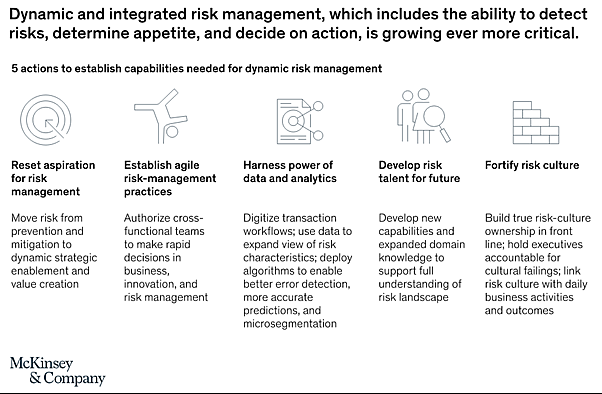
What are the common contract risk types you should look for?
Any adjustment to your strategy should take into account the following four contractual risk types during each phase of your CLM because contracts are one of the essential containers for transferring risks throughout the firm.
1. Regulatory and legal risks
The dangers associated with adhering to laws and regulations increase tremendously as modern enterprises venture outside of their core markets. These components typically include a contract violation that could result in legal consequences and litigation.
A violation of this kind may involve failures to comply with regulatory frameworks like:
• Service Organization Controls (SOC) 2 Type 2 – Reports and audits for all data security procedures, processes, and technologies
• Payment Card Industry Data Security Standard (PCI DSS) – Maintains credit card information privacy and security
• Federal Information Security Management Act (FISMA) – Governs data security at federal organizations
• Health Insurance Portability and Accountability Act of 1996 (HIPAA) – Protects personally identifiable information (PII)
• Health Information Technology for Economic and Clinical Health Act (HITECH Act) – Promotes the adoption of technologies for improving electronic health record (EHR) systems
• Occupational Safety and Health Act (OSHA) – Aims to provide safer work conditions for all employees
• Sarbanes-Oxley Act (SOX) – Governs financial record-keeping practices in publicly traded companies
The preceding list is not exhaustive because each organization’s exposure to legal and regulatory risk will vary depending on its operations and geographic reach. The new General Data Protection Regulation (GDPR) will also be applicable to businesses that operate in the European Union (EU). Similar circumstances apply to businesses that are based in Canada (PIPEDA) or states like California (CCPA).
The greatest dangers here are violating someone’s privacy or not protecting personally identifying information. Additional dangers include theft of intellectual property (IP), drafting provisions incorrectly, unauthorized disclosure of information, insufficient insurance or licensing procedures, and general legal problems.
2. Security risks
Many of the above-mentioned laws deal only with data privacy, but you should also take into account additional security threats while assessing your strategy. Any unintentional data deletion, unlawful access and information dissemination, or system breach can cause the organization a wide range of problems.
Contracts often contain this sensitive information, thus while enhancing your CLM, you should take this into account as one of the inherent dangers. When you consider how much correspondence and communication there is during the various contracting stages, there is a significant chance that this information will end up in the wrong hands.
If you use unsafe methods to exchange contractual information between parties, the danger multiplies dramatically. Inadequate training, weak data protection rules, or insufficient permissions and access restrictions might potentially expose you to security dangers.
Given the increasing rise in cybercrime and its destructive effects on enterprises, data breaches in particular present a huge concern. Due to the vast amounts of customer information that law firms collect, handle, and maintain, attackers started targeting them. One of the largest issues for contemporary firms continues to be managing the security threats in your CLM process.
3. Financial risks
The organization faces financial risks as a result of unfulfilled promises, inadequate guarantees, or claims-related issues. If risk mitigation isn’t a top priority for the organization, there are a variety of instances where these issues could enter the contracting process. These consist of:
• Credit risks – Includes a variety of risks such as defaulting of a counterparty who fails to deliver according to the obligations of the contract
• Liquidity risks – Describes the ability to pay out a contract before it reaches maturity without incurring unacceptable losses
• Asset-backed risks – Are financial structures to separate and mitigate risks using instruments for the securitization of the organization’s exposure
• Equity risks – Involves any equity position in another firm or venture that can expose your organization to additional financial risks when that entity fails to perform and the stock drops or your gains aren’t equal to the value you invested
On either the buyer’s (accounts payable) or seller’s (accounts receivable) side of the transaction, financial losses can happen. When you don’t have the right controls in place, mitigating these risks can still have an impact on specific agreements even when it’s part of a bigger corporate strategy. Common causes could include omitted important dates from contracts (including evergreen terms), fluctuations in pay based on performance metrics, or unenforceability of termination clauses because of poor legal wording.
4. Brand damage
Every business relies on its reputation, which can take years to build. Brand hazards include harm to recognition, awareness, and reputation that may have an impact on consumer loyalty, staff loyalty, and public perceptions.
Limiting unfavorable opinions that may result from associations or ineffective event response is essential for ensuring brand safety.
Brand damage could happen if:
• Companies treat employees badly
• Information about company practices leaks to the public
• An incident occurs like a data breach or information leak
• The organization doesn’t have adequate public or media relations strategies in place
Without particular stipulations relating to the reputation and ethics of an organization as part of the agreement, brand harm and risk are difficult to evaluate and control.

Why should you mitigate contract risks?
Although no business is able to completely eliminate contractual risks, you must use a well-balanced plan to keep your exposure to acceptable levels. The consequences for your organization’s brand, finances, and operational health can be disastrous when firms fail to reduce contractual risks.
The following list of factors justifies contract risk mitigation:
• Avoid missing your contractual obligations including deadlines, milestones, key dates, or any other deliverable
• Prevent the unauthorized access or dissemination of information relating to your organization, suppliers, employees, customers, or other legal relationships
• Ensure compliance with internal policies, contractual thresholds, and external regulations or industry standards
• Streamline the buy- and sell-side of your contracting process for increased efficiency
• Provide better alignment with stakeholder strategies and reduce or prevent avoidable fines with legislators
Typically, there are many parties with competing interests involved in contract management. To manage operations, each of them makes use of a range of tools and technologies. All of these objectives must be supported by the contractual process, which must also reduce risk exposure and guarantee effective CLM throughout the company.
Implementing a balanced approach to contract risk mitigation
Organizations should implement a balanced strategy for contract risk reduction in addition to their efforts to change their businesses digitally. This is possible by:
• Measuring acceptable risks against the value of new opportunities
• Contrasting current revenues against any additional costs
• Evaluating the potential of innovation against compliance requirements
Organizations may create the necessary mitigation plans to safeguard against operational, financial, and brand risks with the use of a digital contract management solution.
Best practices for mitigating contract risks
Your governance, risk, and compliance (GRC) strategy should include developing a structure that consistently reduces your risk exposure during the contracting process. These stages can be used to create an efficient contract risk mitigation plan.
1. Identify contractual risks
By locating each risk inside your current agreements, you can first assess your current risk profile. The risk types mentioned above should be checked out in each contract, and these should be listed in your assessment.
To understand where extra controls will need to be established, you should also examine your current CLM process and identify the points at which risks enter the workflow.
2. Assess and score risks
Once you are aware of potential risks, you must assess each one in light of its likelihood of happening and the potential repercussions. This gives you the ability to rate your present risk exposure and determine where to focus your mitigation efforts first. If you can’t completely eliminate the risk, you should set reasonable limits so you can control your exposure.
3. Establish a contractual risk team
With this knowledge, you can begin putting the necessary controls and mitigation measures in place for your contractual model. You must do this by developing a risk response plan with distinct roles and responsibilities for each relevant stakeholder, along with a responsible, accountable, consulted, and informed (RACI) model.
The next step is to create the necessary backup plans for risks with a higher likelihood of happening and to inform your team of their roles and duties in the event of an occurrence.
4. Digitize the contracting process
Digitize your contractual process to make it simpler for your teams, and create a single, secure repository for all associated files and records. The important roles needed for your digital system will be identified with the aid of your RACI model, and you can then set up your authentication, authorization, and access restrictions.
5. Use alerts and notifications
Using alerts and notifications that control the contracting processes makes it simpler to keep everyone informed of your contractual commitments. Use a defined procedure for all communication with and onboarding of third parties to streamline your new contract requests and document intake activities.
6. Deal with the biggest risks first
By precisely outlining every scope of work (SOW) early on in the process, you may avoid scope creep. Additionally, it will cut down on the length of time needed to finish the contract negotiation stage of the lifecycle and eliminate the possibility of future conflicts.
7. Streamline the drafting process
Make the drafting process faster by using clause and template libraries that contain pre-approved legal language for all your terms, conditions, and different contract kinds. To manage all of your business rules, such as reviews, approvals, and clarifications, you can use automation solutions like a workflow engine.
Utilize version control to record comments, track changes, and produce a thorough audit trail for each agreement. E-signatures can also be used to enable contract approval from any location, greatly streamlining the procedure.
8. Review and optimize where necessary
If your CLM is digital, you can begin producing analytics regarding its effectiveness to guide future choices. You can combine contracts based on risks to identify any areas where your mitigating actions fell short of your expectations. Utilize this information to analyze and adjust your risk mitigation approach as necessary.
Why should you use contract management software?
The corporate environment of today is more complicated than ever. Mitigate contract risks because of elements including remote work, global solutions, digitalization, and the service economy. It’s a vital part of running a successful business.
With today’s tools and technologies, a solid framework for contract risk reduction may be established from a single location. A cloud-enabled contract management system that is completely customisable in accordance with your unique CLM model is available for deployment.
Utilizing all of your contract data and accelerating your efforts for digital transformation are both possible with contract management software.
Software for contract administration allows you to:
• Quickly find and report on your contracts according to any parameter or search criteria
• Track your progress for each agreement and see how efficient your process is
• Deploy new controls where necessary to avoid increasing your risk exposure
• Complete the contracting processes without the need for in-person meetings
• Create a standardized library for all your clauses and templates to speed up the lifecycle
Finding the areas with the greatest value potential may be difficult as more firms turn to digital technologies to obtain a competitive edge. Given that contracts are ingrained throughout a company’s whole administrative and operational framework, it stands to reason that giving these procedures top priority will provide you the greatest advantage.
Don’t take any risks
The management of contract risk continues to be a concern for legal teams and contract managers all around the world. Businesses must integrate analytics and data from operational performance into the strategic decision-making process in order to take advantage of new contracting models. Contracts contain crucial business information that can help you realize additional possibilities and produce insightful data about the state of the company.
Contract hazards cannot be eliminated or avoided. These dangers can only be reduced to a manageable degree. Using a digital, networked system to manage contracts effectively gives you all the information and data you need to set up reliable controls across your CLM. You may speed up your digital transformation activities and extract more value from your present operations by using contract risk mitigation.

4 Risks Exposed by Ineffective Vendor Contract Management
It is necessary to anticipate, identify, and mitigate risks at every stage of the vendor risk management lifecycle. Management of contracts is no different. Contracts are serious, complicated legal documents with many moving components that shouldn’t be rushed through, as you probably already know.
The Dangerous Cost of Poor Contract Management
You ought to have established procedures for managing vendor contracts. And possibly a platform for contract management on top of it. Due to the expense or the effort required to onboard, you may end up paying more in the long term if you are unwilling or hesitant to use a contract management software to help streamline the process. However, whether you’ve automated or not, the fact remains that poor contract management exposes your entire company to a number of problems.
Ineffective Vendor Contract Management Risks that Can Happen
Here are four common risks you need to be aware of:
1. Bleeding costs. Loss of revenue is one of the largest risks associated with poor contract management. Without properly reviewing contracts you leave your organization wide open to wasted dollars in several areas, including:
• Money spent on underperforming contractors
• Opportunity cost
• Redundancy cost
• Scope creep
• Loss of customers due to flagging quality
• Missed automatic renewals
2. Missed renewals. Without effective contract management processes in place, it’s pretty easy to lose track of when a contract is expiring. Ultimately, this may lead to an unexpected delay or halt of core services and/or product delivery. When you miss a contract renewal, you also miss an opportunity to choose a vendor that may offer a lower rate (aka opportunity cost). In many cases, vendors will try to negotiate better deals upfront, with the hopes of scoring a long-term set up.
Typically, there are also restrictions and time limits around the length of time organizations can have access to intellectual property. So, if your organization and/or your vendor allows an agreement to expire, but the vendor continues to have access to your product, you open yourself up to liability.
3. Poor service level performance. Contract management requires a lot of ongoing oversight. The good thing is, with a centralized, streamlined contract management system, this is much easier. However, without a solid process in place, service level agreements (SLAs) are often overlooked or mismanaged. The end results? Poor delivery, declining quality of service and products and fractured communication.
For example, what happens if you don’t properly review your contract for continuing service requirements and the vendor’s obligation to continue providing specific service levels (such as data security) during a transition? You could open yourself up to data breach and a whole host of other security issues.
4. Compliance failure. Without a doubt, regulatory compliance has become increasingly complex and is unique depending on industry, state and/or region. Overlooking compliance clauses in your contracts can have major implications for your organization. When juggling a lot of contracts, it’s critical to make sure the necessary compliance clauses are included so your organization can oversee both internal and external compliance. Having contract management platform can help you simplify and digitize the audit process so you can better manage data privacy, confidentiality and arbitration regulations. Without, you put your organization at risk of compliance failure, which can also have financial implications!
Don’t forget that contract management is a key part of the vendor management lifecycle. It’s critical to the overall success of your third-party risk management program. Leverage the power of effective contract management to take some of the manual, heavy lifting off your plate and to help with the day-to-day oversight – all in all limiting risk exposure.

Course Manual 9: Contract Review & Next Steps
Six Points to Consider When Reviewing a Contract
A crucial step in the contracting process is to conduct a contract review. This gives you and your company the chance to make sure you both understand the terms of the agreement before you sign anything. A contract review lowers organizational risks and raises the possibility that an agreement will benefit the interests of all parties. Without a thorough contract review, you run the danger of entering into commitments that you won’t be able to keep, harming your company’s reputation and brand, and wasting time and money trying to settle conflicts that could have been avoided.
Some of the most crucial items to look for during a contract review are covered in this course manual.
What is a Contract Review?
Before it is signed, a legal agreement is thoroughly examined to make sure that everything contained therein is true and accurate and that your business is at ease moving forward in accordance with the provisions of the agreement. Following the original signing of the contract, contract reviews are crucial in the run-up to particular contracting events, such renegotiation or opt-out windows. The last chance you have to discover and ask for necessary adjustments before committing to an agreement is usually during a contract review.
What to Look for When Reviewing a Contract
Starting with a plan can help you ensure that the most crucial parts of the contract have been thoroughly examined while performing a contract review. You shouldn’t proceed with the contract if any errors or discrepancies are found, or if any queries come up as a result of the contract review, until all problems have been satisfactorily fixed. Here are a few of the most important items to check during a contract review.
1. Key Terms & Clauses
Every line in a contract is crucial and needs to be carefully examined, but some phrases and conditions are unquestionably more vital than others. The most crucial contract conditions are likely to vary as every business and industry is unique, but there are a handful that should be carefully scrutinized in every case. Important contract clauses including those relating to confidentiality, indemnity, termination, and dispute resolution are all worth carefully analyzing to make sure the language is appropriate.
2. Terms of Termination and Renewal
You should make sure you fully grasp the contract’s termination and renewal provisions before signing any legally binding agreement to prevent being shackled to it for a longer period of time than you intended. To know upfront how and when to cancel the agreement and what the consequences are of not telling the other party by a specific date, you should check on items like automatic renewal wording and opt-out windows.
This is also a good time to start making plans for the future so that you won’t be unprepared for critical dates and deadlines. Set calendar reminders to ensure that you and your team don’t miss chances to revise or terminate the agreement within the given constraints.
3. Use of clear, Direct Language
Pay special attention to how each sentence is written as you read a contract and scan it for any terminology that might be open to interpretation. Even if both parties read ambiguous wording in the same manner, it’s best to clarify the language if you can to avoid misunderstandings once the contract is signed and put into effect. Make sure all provisions are spelled out explicitly because significant disagreements may force a third party to decide what to do next depending on how they perceive the contract.
4. No blank Spaces
Utilizing contract templates can help you save time when drafting contracts, but the contract review process calls for extra care. Before the final contract is signed, all blanks should be filled in or eliminated. Depending on the situation, leaving a blank in your agreement could have expensive repercussions for your company.
5. Default Terms
While most contracts are entered into with good intentions on all sides, there is always a chance that one party won’t fulfill their end of the bargain, which would constitute a breach of contract. Watch out for default provisions so you are aware of the potential repercussions of failing to meet your duties or the choices you have if you are the non-breaching party.
6. Important Timelines & Dates
During the contract review step, in addition to making sure that all of the due dates and deliverables are consistent with any prior oral agreements, you can begin keeping track of anything your team or organization is in charge of carrying out. Having a plan in place will lessen the likelihood of a contract breach, which might have serious repercussions for your company.

How to succeed
Give Yourself Enough Time for a Complete Review.
Even for lengthy, complex agreements, reading and examining every clause in a contract can take a lot of time, but it’s an essential step in preventing excessive risk for your company. High-value or high-risk contracts should always be given plenty of thought before being signed. One incorrectly placed comma or confusing statement could result in expensive and avoidable errors.
Have Multiple People Review.
A contract review should always be carried out by a person different than the one who wrote the document. A person who is reading a contract for the first time is more likely to notice a mistake or misspelling than someone who has been reading the same information for a long time and prepared the contract. You’ll improve your odds of executing a contract that performs as intended by having a second member of your legal team, or even a contract review attorney, review each crucial agreement.
Examine Contracts Frequently.
Along with new contracts, existing agreements should also undergo contract reviews. Any time you’re getting ready to renew an agreement, you have the chance to make improvements based on the knowledge gained since the last time the agreement was signed, fix a mistake that was made in the past, or modify the language in light of new industry regulations or standards that have emerged since the contract was first written. The fact that a contract was initially signed and approved shouldn’t stop you from periodically evaluating it, searching for ways to improve or refine the terms, or even taking action to end the deal in some circumstances.
Take Advantage of Technology.
Line-by-line examination of a written document is a difficult task that is best handled by modern technology, especially technologies that use artificial intelligence and machine learning. In contrast to people, which is a genuine worry when evaluating lengthy contracts, contract review solutions, including some contract management software, offer the ability to automatically scan and analyze vast quantities of text swiftly and accurately.
Although technology shouldn’t take the place of human reviewers, contract review solutions can greatly improve the effectiveness and accuracy of this process when utilized to support human efforts.

The Vendor Contract Is Signed: What Are Your Next Steps?
The vendor risk management team may receive a contract in a variety of ways. In the ideal case situation, the vendor selection, initial due diligence, contracting, and onboarding processes have all incorporated the vendor risk team. In other instances, an executive or the line of business leader will send the contract to the vendor risk management team after it has already been signed. Whichever way you see it, these are your next actions.
The vendor risk management team may receive a contract in a variety of ways. In the ideal case situation, the vendor selection, initial due diligence, contracting, and onboarding processes have all incorporated the vendor risk team. In other instances, an executive or the line of business leader will send the contract to the vendor risk management team after it has already been signed. Whichever way you see it, these are your next actions.
Considerations After the Contract Is Signed
Once the contract has been signed, make sure you take the following actions:
1. Identify the parties to the contract.
Who else should be a part of those parties, except your organization? If anything is unclear, it has to be clarified.
2. Calculate the cost.
What does your company have to pay the vendor? It’s wise to estimate the overall cost of the contract up front by adding up all the payments that must be made to the vendor during the course of the agreement. Make sure you consider any penalty terms in the contract, whether they pertain to your company or the seller.
3. Recognize service level agreements (SLAs).
Find out the service levels and when each will be delivered that the vendor has agreed to do for your company. Verify again with the line of business that they are aware of the SLAs in the contract.
4. Examine the timeline.
Every contract has a set timeline. Your vendor management platform needs to have a place where the vendor risk management team can track these. Be careful to set up announcements for each of these dates. Set up the notices to give your company adequate time to make the necessary decisions!
Here are some of the dates and information you’ll want to be sure to track:
• Start date – The effective date of the contract.
• End date – Contract termination dates can be very nebulous with auto renewing agreements.
• Termination process – What the defined process for ending the contract looks like. The risk management team needs to record this process for every agreement.
• Notice date – The date your organization will have to send a notice of renewal or non-renewal.
• Individual who will receive the notice – It’s also prudent to record to whom and how the notice will be delivered.
1. Review automatic price escalations.
Price increases normally occur with auto-renewing agreements. Though, some contracts will have an annual cost increase. Either way, you need to know the percentage or dollar amount of the cost increase.
2. Review the terms and conditions.
These are the rules and guidelines that both parties to the agreement must adhere to.
3. Check for warranties and/or indemnifications.
The vendor should warranty their product or service and they should indemnify your organization from any wrongdoing on their part. This is important to review and understand!
4. Understand any stipulations around “governing law”.
If a dispute arises, don’t be surprised to hear this question: “What state or county will have jurisdiction to hear the case?”
With that being said, you’ll also want to consider:
• Dispute resolution – Typically, the second thing you’ll be asked if something doesn’t go to plan is, “What is the dispute resolution process?” It’s a best practice to note the highlights of this process.
5. Review merger clauses.
Any vendor’s merger or acquisition can have a disastrous effect on your organization. Make sure you understand what the vendor’s responsibilities are and what your organization’s responsibilities are if a merger occurs.
6. Consider other important clauses pertinent to the partnership type.
Here are a couple of other clauses you’ll often need to consider:
• Confidentiality – Be sure to understand, document and socialize the confidentiality provisions of every contract — especially the contracts where confidential, nonpublic information will be exchanged between the parties within the agreement.
• Non-Compete and Non-Solicitation – This section is designed to keep your organization from hiring the talent the vendor brings to the table or to keep personnel at your organization from playing fast and loose with the vendor’s business model.
In a third-party risk professional’s world, receiving a contract that an executive or line-of-business leader signed without vendor risk management input is both conceivable and occasionally common. Don’t freak out if this happens. Just one more thing to do: make sure the product or service is known to all important stakeholders.
The vendor risk management team’s ultimate objective is to make sure that both the business and the vendor uphold the commitments they made in their respective contracts. Since contracts contain a lot of information, it’s critical to make sure you record all of it by jotting down key terms and dates, preferably in a platform. In order to maintain efficiency and best practices, make sure your reporting includes the information your organization need.
Workshop Exercises

Contract Negotiation Exercises
01. Prepare for Contract Negotiation: Explain in your own words how this process will directly impact upon your department?
02. Set Negotiation Objectives: Explain in your own words how this process will directly impact upon your department?
03. Negotiation Strategies: Explain in your own words how this process will directly impact upon your department?
04. Request for Proposal (RFP): Explain in your own words how this process will directly impact upon your department?
05. Due Diligence Checklist: Explain in your own words how this process will directly impact upon your department?
06. Check References: Explain in your own words how this process will directly impact upon your department?
07. Exit Strategy: Explain in your own words how this process will directly impact upon your department?
08. Mitigating Contract Risks: Explain in your own words how this process will directly impact upon your department?
09. Contract Review & Next Steps: Explain in your own words how this process will directly impact upon your department?

SWOT & MOST Analysis Exercises
01. Undertake a detailed SWOT Analysis in order to identify your department’s internal strengths and weaknesses and external opportunities and threats in relation to each of the 12 Contract Negotiation processes featured above. Undertake this task together with your department’s stakeholders in order to encourage collaborative evaluation.
02. Develop a detailed MOST Analysis in order to establish your department’s: Mission; Objectives; Strategies and Tasks in relation to Contract Negotiation. Undertake this task together with all of your department’s stakeholders in order to encourage collaborative evaluation.
Project Studies
Project Study (Part 1) – Customer Service
The Head of this Department is to provide a detailed report relating to the Contract Negotiation process that has been implemented within their department, together with all key stakeholders, as a result of conducting this workshop, incorporating process: planning; development; implementation; management; and review. Your process should feature the following 12 parts:
01. Prepare for Contract Negotiation
02. Set Negotiation Objectives
03. Negotiation Strategies
04. Request for Proposal (RFP)
05. Due Diligence Checklist
06. Check References
07. Exit Strategy
08. Mitigating Contract Risks
09. Contract Review & Next Steps
Please include the results of the initial evaluation and assessment.
Project Study (Part 2) – E-Business
The Head of this Department is to provide a detailed report relating to the Contract Negotiation process that has been implemented within their department, together with all key stakeholders, as a result of conducting this workshop, incorporating process: planning; development; implementation; management; and review. Your process should feature the following 12 parts:
01. Prepare for Contract Negotiation
02. Set Negotiation Objectives
03. Negotiation Strategies
04. Request for Proposal (RFP)
05. Due Diligence Checklist
06. Check References
07. Exit Strategy
08. Mitigating Contract Risks
09. Contract Review & Next Steps
Please include the results of the initial evaluation and assessment.
Project Study (Part 3) – Finance
The Head of this Department is to provide a detailed report relating to the Contract Negotiation process that has been implemented within their department, together with all key stakeholders, as a result of conducting this workshop, incorporating process: planning; development; implementation; management; and review. Your process should feature the following 12 parts:
01. Prepare for Contract Negotiation
02. Set Negotiation Objectives
03. Negotiation Strategies
04. Request for Proposal (RFP)
05. Due Diligence Checklist
06. Check References
07. Exit Strategy
08. Mitigating Contract Risks
09. Contract Review & Next Steps
Please include the results of the initial evaluation and assessment.
Project Study (Part 4) – Globalization
The Head of this Department is to provide a detailed report relating to the Contract Negotiation process that has been implemented within their department, together with all key stakeholders, as a result of conducting this workshop, incorporating process: planning; development; implementation; management; and review. Your process should feature the following 12 parts:
01. Prepare for Contract Negotiation
02. Set Negotiation Objectives
03. Negotiation Strategies
04. Request for Proposal (RFP)
05. Due Diligence Checklist
06. Check References
07. Exit Strategy
08. Mitigating Contract Risks
09. Contract Review & Next Steps
Please include the results of the initial evaluation and assessment.
Project Study (Part 5) – Human Resources
The Head of this Department is to provide a detailed report relating to the Contract Negotiation process that has been implemented within their department, together with all key stakeholders, as a result of conducting this workshop, incorporating process: planning; development; implementation; management; and review. Your process should feature the following 12 parts:
01. Prepare for Contract Negotiation
02. Set Negotiation Objectives
03. Negotiation Strategies
04. Request for Proposal (RFP)
05. Due Diligence Checklist
06. Check References
07. Exit Strategy
08. Mitigating Contract Risks
09. Contract Review & Next Steps
Please include the results of the initial evaluation and assessment.
Project Study (Part 6) – Information Technology
The Head of this Department is to provide a detailed report relating to the Contract Negotiation process that has been implemented within their department, together with all key stakeholders, as a result of conducting this workshop, incorporating process: planning; development; implementation; management; and review. Your process should feature the following 12 parts:
01. Prepare for Contract Negotiation
02. Set Negotiation Objectives
03. Negotiation Strategies
04. Request for Proposal (RFP)
05. Due Diligence Checklist
06. Check References
07. Exit Strategy
08. Mitigating Contract Risks
09. Contract Review & Next Steps
Please include the results of the initial evaluation and assessment.
Project Study (Part 7) – Legal
The Head of this Department is to provide a detailed report relating to the Contract Negotiation process that has been implemented within their department, together with all key stakeholders, as a result of conducting this workshop, incorporating process: planning; development; implementation; management; and review. Your process should feature the following 12 parts:
01. Prepare for Contract Negotiation
02. Set Negotiation Objectives
03. Negotiation Strategies
04. Request for Proposal (RFP)
05. Due Diligence Checklist
06. Check References
07. Exit Strategy
08. Mitigating Contract Risks
09. Contract Review & Next Steps
Please include the results of the initial evaluation and assessment.
Project Study (Part 8) – Management
The Head of this Department is to provide a detailed report relating to the Contract Negotiation process that has been implemented within their department, together with all key stakeholders, as a result of conducting this workshop, incorporating process: planning; development; implementation; management; and review. Your process should feature the following 12 parts:
01. Prepare for Contract Negotiation
02. Set Negotiation Objectives
03. Negotiation Strategies
04. Request for Proposal (RFP)
05. Due Diligence Checklist
06. Check References
07. Exit Strategy
08. Mitigating Contract Risks
09. Contract Review & Next Steps
Please include the results of the initial evaluation and assessment.

Project Study (Part 9) – Marketing
The Head of this Department is to provide a detailed report relating to the Contract Negotiation process that has been implemented within their department, together with all key stakeholders, as a result of conducting this workshop, incorporating process: planning; development; implementation; management; and review. Your process should feature the following 12 parts:
01. Prepare for Contract Negotiation
02. Set Negotiation Objectives
03. Negotiation Strategies
04. Request for Proposal (RFP)
05. Due Diligence Checklist
06. Check References
07. Exit Strategy
08. Mitigating Contract Risks
09. Contract Review & Next Steps
Please include the results of the initial evaluation and assessment.

Project Study (Part 10) – Production
The Head of this Department is to provide a detailed report relating to the Contract Negotiation process that has been implemented within their department, together with all key stakeholders, as a result of conducting this workshop, incorporating process: planning; development; implementation; management; and review. Your process should feature the following 12 parts:
01. Prepare for Contract Negotiation
02. Set Negotiation Objectives
03. Negotiation Strategies
04. Request for Proposal (RFP)
05. Due Diligence Checklist
06. Check References
07. Exit Strategy
08. Mitigating Contract Risks
09. Contract Review & Next Steps
Please include the results of the initial evaluation and assessment.

Project Study (Part 11) – Logistics
The Head of this Department is to provide a detailed report relating to the Contract Negotiation process that has been implemented within their department, together with all key stakeholders, as a result of conducting this workshop, incorporating process: planning; development; implementation; management; and review. Your process should feature the following 12 parts:
01. Prepare for Contract Negotiation
02. Set Negotiation Objectives
03. Negotiation Strategies
04. Request for Proposal (RFP)
05. Due Diligence Checklist
06. Check References
07. Exit Strategy
08. Mitigating Contract Risks
09. Contract Review & Next Steps
Please include the results of the initial evaluation and assessment.

Project Study (Part 12) – Education
The Head of this Department is to provide a detailed report relating to the Contract Negotiation process that has been implemented within their department, together with all key stakeholders, as a result of conducting this workshop, incorporating process: planning; development; implementation; management; and review. Your process should feature the following 12 parts:
01. Prepare for Contract Negotiation
02. Set Negotiation Objectives
03. Negotiation Strategies
04. Request for Proposal (RFP)
05. Due Diligence Checklist
06. Check References
07. Exit Strategy
08. Mitigating Contract Risks
09. Contract Review & Next Steps
Please include the results of the initial evaluation and assessment.
Program Benefits
Information Technology
- Agile IT processes
- Improved value delivery
- Decreased defects
- Continuous improvement
- Modernized infrastructure
- Re-tooled staff
- Increased morale
- IT Business partnership
- Meaningful metrics
- Effective sourcing
Management
- Decreased costs
- Aligned strategies
- Servant leadership
- Clarified priorities
- Improved effectiveness
- Improved transparency
- Reduced risk
- Measurable results
- Satisfied customers
- Vendor partnerships
Human Resources
- Empowered teams
- Servant leaders
- Re-tooled staff
- Improved teamwork
- Enhanced collaboration
- Improved performance
- Reduced turnover
- Improved loyalty
- Leadership development
- Employee development
Client Telephone Conference (CTC)
If you have any questions or if you would like to arrange a Client Telephone Conference (CTC) to discuss this particular Unique Consulting Service Proposition (UCSP) in more detail, please CLICK HERE.
























